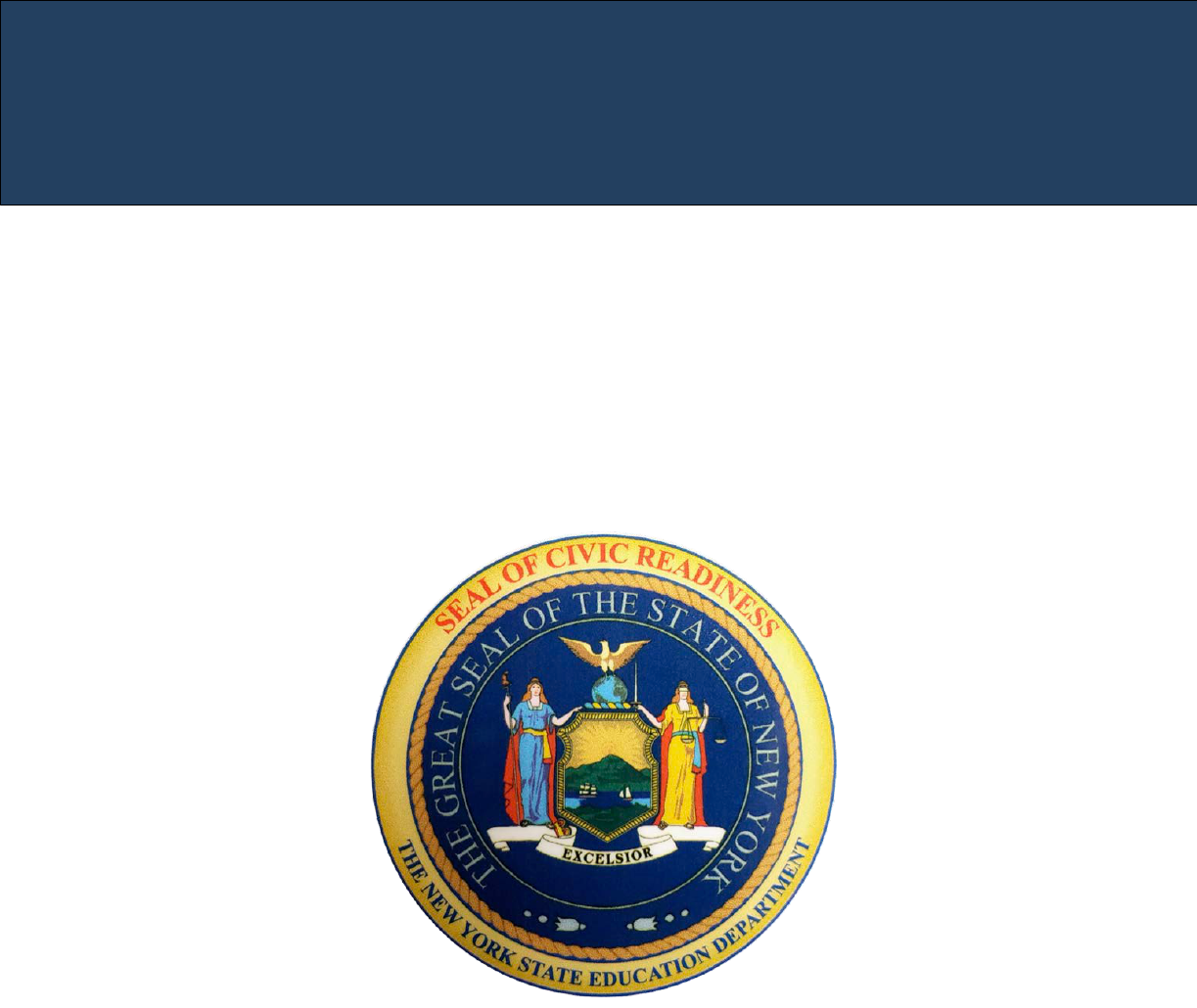
The New York State
Seal of Civic Readiness Handbook
Updated 2024
New York State Education Department
New York State Seal of Civic Readiness Manual 2
THE UNIVERSITY OF THE STATE OF
NEW YORK
REGENTS OF THE UNIVERSITY
LESTER W. YOUNG, JR., Chancellor, B.S., M.S., Ed.D. ...................................... Beechhurst
J
OSEPHINE VICTORIA FINN, Vice Chancellor B.A., J.D. ..................................... Monticello
R
OGER TILLES, B.A., J.D. .................................................................................... Manhasset
C
HRISTINE D. CEA, B.A., M.A., Ph.D. ............................................................... Staten Island
W
ADE S. NORWOOD, B.A. .................................................................................. Rochester
K
ATHLEEN M. CASHIN, B.S., M.S., Ed.D. ........................................................ Brooklyn
J
AMES E. COTTRELL, B.S., M.D. ......................................................................... New York
J
UDITH CHIN, B.S., M.S. in Ed. .......................................................................... Little Neck
C
ATHERINE COLLINS, R.N., N.P., B.S., M.S. in Ed., Ed.D. .............................. Buffalo
L
UIS O. REYES, B.A., M.A., Ph.D. ...................................................................... New York
S
USAN W. MITTLER, B.S., M.S. .......................................................................... Ithaca
F
RANCES G. WILLS, B.A., M.A., M.Ed., C.A.S., Ph.D. ..................................... Ossining
A
RAMINA VEGA FERRER, B.A., M.S. in Ed., Ph.D. .......................................... Bronx
S
HINO TANIKAWA, B.A., M.S. ........................................................................... Manhattan
R
OGER P. CATANIA, B.A., M.A., M.S., C.A.S., Ph.D. ...................................... Saranac Lake
A
DRIAN I. HALE, A.S., B.A. ............................................................................... Rochester
Commissioner of Education and President of The University
BETTY A. ROSA
Senior Deputy Commissioner for Education Policy
Jeffrey Matteson
P-12 Deputy Commissioner for Instructional Support
ANGELIQUE JOHNSON-DINGLE
P-12 Deputy Commissioner for Operational Support
JASON HARMON
The State Education Department does not discriminate on the basis of age, color, religion, creed, disability, marital status,
veteran status, national origin, race, gender, genetic predisposition or carrier status, or sexual orientation in its
educational programs, services and activities. Portions of this publication can be made available in a variety of formats,
including braille, large print, or audio tape, upon request. Inquiries concerning this policy of nondiscrimination should
be directed to the Department’s Office for Diversity and Access, Room 530, Education Building, Albany, NY 12234.
New York State Seal of Civic Readiness Manual 3
Table of Contents
Introduction ................................................................................................................................ 5
Civic Readiness Initiative Background ....................................................................................... 5
Civic Readiness Definition ......................................................................................................... 6
Civic Readiness Domains ........................................................................................................... 7
Civic Knowledge .................................................................................................................................. 7
Civic Skills and Actions ........................................................................................................................ 8
Civic Mindsets ...................................................................................................................................... 8
Civic Experiences ................................................................................................................................. 8
How the Seal of Civic Readiness Connects to NYSED’s Broader Missions ............................. 9
Criteria for the NYSED Seal of Civic Readiness ....................................................................... 9
Criteria for Demonstrating Proficiency in Civic Knowledge ................................................... 12
Civic Knowledge Research Project ..................................................................................................... 12
Criteria for Demonstrating Civic Participation ......................................................................... 16
High School Civic Project................................................................................................................... 17
Service Learning ................................................................................................................................. 20
Elective Course work .......................................................................................................................... 23
Extra-curricular or Worked-Based Learning Experience ................................................................... 23
Middle School Capstone Project ......................................................................................................... 24
High School Capstone Project ............................................................................................................ 26
How Schools and Districts Can Offer the Seal of Civic Readiness .......................................... 30
How BOCES, P-Tech Programs, Regional High Schools, and Other Educational Entities Can
Offer a Seal Program ................................................................................................................ 30
Frequently Asked Questions ..................................................................................................... 31
The Seal of Civic Readiness and How to Apply ................................................................................. 31
Student and Community Outreach ...................................................................................................... 33
Advisement ......................................................................................................................................... 34
Appendix A: Seal of Civic Readiness Application Instructions ............................................... 35
Appendix B: Seal of Civic Readiness Application for Educational Entities that Enroll Students
from Multiple Districts and Do Not Confer Diplomas for All ................................................. 41
Appendix C: Application for Districts to Grant the Seal of Civic Readiness to Students who
Complete the Seal Program outside of the District ................................................................... 47
Appendix D: Seal of Civic Readiness Optional Reflection Guide ........................................... 48
Appendix E: Students Scenarios Earning the Seal of Civic Readiness .................................... 52
Appendix F: Sample Rubric for the Research Project .............................................................. 62
New York State Seal of Civic Readiness Manual 4
Appendix G: Sample Rubric for the High School Civics Project ............................................. 64
Appendix H: Service-Learning Project Reflection Evaluation Example ................................. 67
Appendix I: Service-Learning Project Reflection - Evaluation Rubric .................................... 68
Appendix J: Service-Learning Resources ................................................................................. 70
Appendix K: Application of Knowledge .................................................................................. 71
Appendix L: Work-Based Learning Definitions and Examples ............................................... 77
Appendix M: Sample Extracurricular Activities ...................................................................... 79
Appendix N: Criteria for Elective and Advanced Social Studies Courses ............................... 80
Appendix O: Middle School Capstone Project Essential Elements .......................................... 83
Appendix P: Essential Elements of a High School Capstone Project ....................................... 85
Appendix Q: Sample Student Assignment for a High School Civic Capstone Project ............ 89
Appendix R: Seal of Civic Readiness Pilot Regional Coordinators ......................................... 93
Appendix S: Seal of Civic Readiness Author List .................................................................... 94
Appendix T: Updated Frequently Updated Questions ............................................................. 95
Appendix U: Updated Frequently Asked Questions for BOCES ............................................. 96

New York State Seal of Civic Readiness Manual 5
The New York State Seal of Civic Readiness
Introduction
The New York State Seal of Civic Readiness (NYSSCR) is a formal recognition that a student
has demonstrated the civic knowledge, skills, mindsets, and experiences necessary to become an
actively engaged citizen. The Seal of Civic Readiness distinction on a high school transcript and
diploma
• Shows the student’s understanding of and commitment to participatory government, civic
responsibility, and civic values;
• Provides universities and colleges with a method to recognize and provide credit for
attainment of higher level of understanding and skills in Social Studies;
• Demonstrates to universities, colleges, and future employers that students have earned
recognition for their civic knowledge, skills, mindset, and experiences; and
• Recognizes the value of civic engagement and scholarship to school communities and
society at large.
The Seal of Civic Readiness is an approved +1 Pathway to meet New York State diploma
requirements. However, if a student has already passed five Regents Exams or has chosen a
separate 4+1 Pathway, they may still earn the Seal of Civic Readiness as a stand-alone
distinction on a NYS High School Diploma.
Civic Readiness Initiative Background
The New York State Board of Regents and the New York State Education Department (NYSED)
are committed to civic education that empowers all students to make informed decisions for the
public good as members of a culturally diverse, democratic society in an interdependent world.
Civic education facilitates the development of civic competencies, which are needed for a
democratic society to flourish. Through civic education, students learn how to identify and
address problems in their school and community. Students also learn how to demonstrate respect
for the rights of others, respectfully disagree with other viewpoints, and provide evidence for a
counterargument. Civic education can strengthen the relationships of schools and students with
parents, families, civic leaders, organizations, and community partners.
The New York Civic Readiness Diploma Seal builds on a long-standing foundation of civic
education in New York. Since 1985, students in grade 12 have been required to complete a half
credit course, Participation in Government or its equivalent, to earn a high school diploma. In
2000, the Governor and Legislature amended State Education Law by adding a new section, 801-
a, to require instruction in civility, citizenship, and character education. Participation in
Government guidance was published in 2002 and was updated in 2014 with the New York Social
Studies Curriculum Framework.
1
The Participation in Government course “aims to provide
students with opportunities to become engaged in the political process by acquiring the
knowledge and practicing the skills necessary for active citizenship (as) ...participation in
government and in our communities is fundamental to the success of American democracy.”
1
http://www.nysed.gov/common/nysed/files/programs/curriculum-instruction/ss-framework-9-12.pdf Participation
in Government course outline begins on page 45.

New York State Seal of Civic Readiness Manual 6
In 2018, New York State included the Civic Readiness Index in the state’s Every Student
Succeeds Act (ESSA) Plan as a tool to measure the performance of schools in providing life-long
skills to support student success. The Civic Readiness Index will be a component of the
College, Career, and Civic Readiness Level. The College, Career, and Civic Readiness Level is
defined as the percentage of students who are leaving high school prepared for college, career,
and civic readiness as measured by diploma, credentials, advanced course credits and assessment
results, career and technical education certifications, and other similar measures. One measure
of students’ civic readiness will be the attainment of the New York State Seal for Civic
Readiness.
In 2018, The Board of Regents established the Civic Readiness Task Force with the charge to
define civic readiness and develop recommendations for a Diploma Seal for Civic Readiness and
a Capstone project. In January 2020, The Civic Readiness Task Force, appointed by the Board of
Regents, presented their recommendations to the Board of Regents. Public comment was invited
from March 2020 until October 2020.
In September 2021, the NYS Board of Regents approved the Seal of Civic Readiness +1 Civics
Pathway for all high schools beginning in the 2022-2023 school year. One hundred and
seventeen (117) schools were approved to participate in a pilot for the 2021-2022 school year.
The manual was developed with guidance from stakeholders and the pilot schools to provide
guidance on implementing the Seal of Civic Readiness.
Civic Readiness Definition
Civic readiness is the ability to make a positive difference in the public life of our
communities through the combination of civic knowledge, skills and actions, mindsets, and
experiences.
Civic ready students use civic knowledge, skills, and mindsets to make decisions and take
actions for themselves, their communities, and public good as members of a culturally diverse,
democratic society. Schools, therefore, must provide students meaningful opportunities to
develop specific civic knowledge, skills, and mindsets—and to participate in authentic actions
and experiences—that are necessary for them to function as productive civic participants within
their schools, communities, states, our country, and the world.
NYSED is committed to empowering the civic agency of students and ensuring all students
achieve civic readiness as a result of their Pre-kindergarten - 12th grade education. The Regents
have also emphasized this position in their Every Student Succeeds Act (ESSA) Plan. NYSED
understands that the results we seek for all our children can only be fully achieved by
incorporating an equity and inclusion lens in every facet of our work.
Civic education strengthens the relationships between schools and students, as well as students’
relationships with parents, caregivers and families, civic leaders, community partners, and
among each other. The responsibility of ensuring that all students are civic ready is a chief aim of
social studies education.

New York State Seal of Civic Readiness Manual 7
The New York State Board of Regents has adopted this definition of civic readiness. Eligibility
for the Seal of Civic Readiness will be based on the demonstration of competencies aligned with
this definition.
Civic Readiness Domains
Civic readiness is continuously developed throughout students’ Pre-kindergarten - 12th grade
education and should include focus on the following Domains:
Civic Knowledge: Demonstrate a fundamental and functional knowledge of
government, law, history, geography, culture, economics, and current events. These
may include inequities within our democratic system at the federal, state, and local
level. Students should know how to apply this knowledge to different circumstances and settings.
Civic Mindsets: Demonstrate the mindset of a participant in a democratic society. A
civic mindset is a commitment to democratic interpersonal and intrapersonal values,
virtues, attitudes, and beliefs and informed actions that promote and facilitate
meaningful participation in civic life. It is an understanding of self as part of and responsible to
larger social groups.
Civic Skills & Actions: Demonstrates a broad array of skills including but not limited
to critical thinking, analytic, verbal, communication, media literacy skills. Students
participate in a wide variety of civic activities leading to a range of civic actions.
Students practice such actions outside the classroom and inside school on a regular basis.
Civic Experiences: Participate in developmentally appropriate civic experiences. Civic
readiness should be developed in a variety of settings and ways—inside and outside of
the classroom, across content areas, and for multiple purposes. Civic Readiness should
be promoted by engaging students in relevant experiences that include students as active
participants.
Domain Examples:
Civic Knowledge
Fundamental civic knowledge in grade level appropriate forms includes:
• The structure and functioning of government, law, and democracy at the federal, state,
local, and school levels, and how to participate therein;
• Civil and educational rights and responsibilities guaranteed by the U.S. Constitution, the
Constitution of the State of New York, and federal, state and local statutes and
regulations;
• History, geography, economics, and current events within our country and in our global
society;
• The impact of individual and collective histories in shaping contemporary issues;
• View and analyze history and current issues from multiple perspectives;
• The importance of civic rights and responsibilities, such as voting, volunteering, serving
on a jury, and the importance of ensuring a free press.

New York State Seal of Civic Readiness Manual 8
Civic Skills and Actions
Critical intellectual and participatory civic skills students should develop and actions they should
take in grade-level appropriate forms include the ability to:
• Demonstrate respect for the rights of others in discussions and classroom debates, and
how to respectfully disagree with other viewpoints and provide evidence for a
counterargument;
• Participate in activities that focus on a classroom, school, community, state or national
issue, or problem;
• Identify, describe and contrast the roles of the individual in opportunities for social and
political participation in different societies;
• Work to influence those in positions of power to achieve extensions of freedom, social
justice, and human rights;
• Fulfill social and political responsibilities associated with participation in a democratic
society and the interdependent global community by developing awareness of and/or
engaging in the political process;
• Analyze and evaluate news (news literacy), media, social media, and other sources of
information for accuracy, bias, reliability, and credibility;
• Engagement in working toward the public good.
Civic Mindsets
Key civic mindsets students should develop in grade-level appropriate ways include:
• Valuing equity, inclusivity, diversity, and fairness;
• Recognizing the need to plan for both current needs and the good of future generations;
• Empathy, compassion, and respect for the views of people with other opinions and
perspectives;
• Committing to balancing the common good with individual liberties;
• Demonstrating a sense of self as an active participant in society, willing to contribute to
solving local and/or national problems;
• Respecting fundamental democratic principles, such as freedom of speech, freedom of
the press and the rule of law.
Civic Experiences
Examples of civic experiences in which students should be able to participate in grade-level
appropriate ways include:
• Completing a civic readiness capstone or civic engagement project;
• Engaging in service-learning;
• Engaging in civil discourse around controversial issues;
• Engaging with news and digital tools, such as social media, responsibly;
• Participating in civic-centered co-curricular and extracurricular activities such as Model
UN, Student Government, Debate Club, Moot Court, Student Journalism, or Mock Trial;
• Participating in school governance;

New York State Seal of Civic Readiness Manual 9
• Voting, volunteering, and participating in community organizations and governmental
systems, such as community boards, youth advisory councils, etc., to promote continuous
improvement;
• Engaging with local officials and government institutions through activities such as
providing public comment before a government agency, or meeting with public and
elected officials.
How the Seal of Civic Readiness Connects to NYSED’s Broader Missions
Diversity, Equity, and Inclusion
In a diverse society, governed by a constitution and laws that provide for individual rights,
liberty, justice, and equality under the law, civic engagement will involve exposure to a diversity
of people and perspectives. Respect for and commitment to the rights of others, informed and
thoughtful deliberation about societal, political, and governmental issues, consistent with the
constitution, the law, and the rights of others, is a responsibility of all citizens. The Civic
Readiness Initiative centers around creating positive social interactions across differences. This
includes exposing students to multiple perspectives.
Social Emotional Learning
Civic engagement encourages students to explore issues in the broader community from various
perspectives, helping them to reflect upon their own ideas and opinions, building understanding
of themselves, their aspirations, and consideration of the diverse people and perspectives in the
larger community.
Financial Literacy
Development of financial literacy is integral to student understanding of the rights and
responsibilities of citizenship and participation in the economic and social lives of their
communities. This includes understanding, assuming, and fulfilling responsibility for the
financial support of oneself, one’s family, and financial obligations to the larger community.
Culturally Responsive-Sustaining Education
The Culturally Responsive-Sustaining framework is intended to help education stakeholders
create student-centered learning environments that affirm cultural identities; foster positive
academic outcomes; develop students’ abilities to connect across lines of difference; elevate
historically marginalized voices; empower students as agents of social change; and contribute to
individual student engagement, learning, growth, and achievement through the cultivation of
critical thinking.
Criteria for the NYSED Seal of Civic Readiness
To earn the Seal of Civic Readiness, a student must earn a total of six points on the chart below.
A student must earn at least two points from column #1 (Criteria for Demonstrating Proficiency
in Civic Knowledge) and at least two points from column #2 (Criteria for Demonstrating Civic
Participation) and an additional two points from either column. This chart is a menu of options
designed to allow for flexibility. This is not a checklist. It is not necessary for a student to earn
points in all these categories to earn the Seal of Civic Readiness.

New York State Seal of Civic Readiness Manual 10
Criteria for Demonstrating
Proficiency in Civic Knowledge
Pts.
Criteria for Demonstrating
Civic Participation
Pts.
Options Options
1a. Social Studies courses
required for graduation:
• Obtain course credit in
Global History &
Geography I
• Obtain course credit in
Global History &
Geography II
• Obtain course credit in
United States History &
Government
• Obtain course credit in
Participation in Government
& Economics
Or the equivalent of these courses, as
approved by the local public-school
superintendent or his or her designee or
by the chief administrative officer of a
registered nonpublic high school.
1
2a. Civic Skills, Actions, and
Mindsets
• Complete a high school civic
project that demonstrates civic
knowledge, skills, actions, and
mindsets, as established by the
local Seal of Civic Readiness
Committee (SCRC). (The
culminating project is different
from the Capstone and further
explained in the Introduction to
the Seal of Civic Readiness.)
1.5**
1b. Social Studies Regents Exams -
Mastery level
• Demonstrate mastery level on
the Global History &
Geography Regents and/or
United States History Regents
1.5*
2b. Civic Experiences Area I
• Complete a service-learning
project that includes a
minimum of 25 hours of
demonstrated service to the
community and submit a
reflective civic learning
essay/presentation.
1*
1c. Social Studies Regents
Exams - Proficiency Level
• Receive a passing score on the
Global History & Geography
Regents and/or United States
History Regents (apply safety
net if eligible)
1*
2c. Civic Experiences Area II
• Demonstrate proficiency in an
elective course that promotes
civic engagement (as defined
by SCR committee) and submit
an application of knowledge
essay/presentation.
.50*

New York State Seal of Civic Readiness Manual 11
Criteria for Demonstrating
Proficiency in Civic Knowledge
Pts.
Criteria for Demonstrating
Civic Participation
Pts.
1d. Advanced Social Studies Courses
• Demonstrate proficiency in an
advanced social studies course
(e.g., Honors, Pre-AP, AP, IB
or College/University level
approved by the school district;
including dual enrollment
courses or others approved by
the SCR Committee.
.50*
2d. Civic Experiences Area III
• Participate in an extra-curricular
program, or work-based learning
experience, that promotes civic
engagement or civic action for a
minimum of 40 hours. Students
must also submit an application of
knowledge essay/presentation.
This may be accomplished over
four years of high school.
.50*
1e. Research Project
• Demonstrate civic knowledge
through a social studies
research project. This project
must be approved by the
district’s Seal of Civic
Readiness Committee.
1
2e. Middle School Capstone Project
Complete the middle school capstone
project that includes the essential
elements listed below:
• Identify an issue (local,
state, national, or global);
• Apply civic knowledge, skills,
actions, and mindsets to the
issue;
• Present the overall project to
the Middle School Capstone
Committee.
1
2f. High School Capstone
Project The Capstone Project
includes these Essential
Elements:
• Identify an issue (local,
state, national, or global);
• Apply civic knowledge, skills,
actions, and mindsets to the
issue;
• Engage in a civic experience
based on the issue to influence
positive change to the
community (local, state,
national, or global);
• Present overall project to the
school’s Civic Readiness
Committee.
4
*Students may receive these points more than once.
** Students may receive these points no more than two times

New York State Seal of Civic Readiness Manual 12
Testing accommodations recommended in an individualized education program or section 504
Accommodations Plan must be provided for all State and districtwide assessments administered to
students with disabilities, as consistent with State policy. Students in schools with an alternate pathway
for graduation approved by the Commissioner will be held to those schools' criteria.
Scenarios: See Appendix E
for scenarios
Criteria for Demonstrating Proficiency in Civic Knowledge
Students who receive the NYSED Seal of Civic Readiness must earn a total of six
points, with at least two points from column #1 - Criteria for Demonstrating
Proficiency in Civic Knowledge.
The options for this category include:
1a. Social Studies courses required for graduation: ...................................................... 1 pt.
• Obtain course credit in Global History & Geography I
• Obtain course credit in Global History & Geography II
• Obtain course credit in United States History & Government
• Obtain course credit in Participation in Government & Economics
• Or the equivalent of these courses, as approved by the local public-school
superintendent or his or her designee or by the chief administrative officer of a
registered nonpublic high school
1b. Social Studies Regents Exam – Mastery Level .................................................. 1.5 pts.*
• Demonstrate mastery level on the Global History & Geography II Regents and/or
United States History Regents
1c. Social Studies Regents Exams - Proficiency Level ................................................. 1 pt.*
• Receive a passing score on the Global History & Geography II Regents and/or
United States History Regents (apply safety net if eligible)
1d. Advanced Social Studies Courses ......................................................................... .50 pt.*
• Demonstrate proficiency in an advanced social studies course (e.g., Honors, Pre-
AP, AP, IB or College/University level approved by the school district; including
dual enrollment courses or others approved by the SCR Committee).
1e. Research Project ......................................................................................................... 1 pt.
• Demonstrate civic knowledge through a social studies research project. This
project must be approved by the District’s Seal of Civic Readiness Committee.
* Students may receive these points more than once. Testing accommodations recommended in an
individualized education program or section 504 Accommodations Plan must be provided. Students in
schools with an alternate pathway for graduation approved by the Commissioner will be held to those
schools' criteria.
Civic Knowledge Research Project
1e. The Civic Knowledge Research Project - 1 point
Civic education must include the opportunity to gather, analyze and use information. New
York’s Next Generation Learning Standards for Literacy in History/Social Science, Science and

New York State Seal of Civic Readiness Manual 13
Technical Subjects
2
outline three Grades 6-12 Anchor Standards in Writing that address the
research skills required to build and present knowledge that are relevant to civic readiness. These
research skills involve a careful examination of sources, requiring media literacy and thinking
skills developed through both Social Studies and English curricula.
Civic Knowledge Research Projects must be approved by the School/School District’s Seal of
Civic Readiness Committee. A Civic Knowledge Research project may provide an opportunity
for students to deepen their background knowledge and hone their disciplinary skills in
preparation for the Civics Project or Civics Capstone. Research projects may be short-term and
may be connected to a classroom project or an extra-curricular organization.
In a High School Civic Knowledge Research Project, students will:
• Examine a question (constitutional, historical, political, economic, and/or social) through
the lens of civics.
• Use a variety of sources (i.e., quantitative, qualitative, primary, secondary) to fully
investigate the research question and support the research thesis (argument or perspective
on the topic).
• Present their research using written, audio/visual, oral, and/or multimodal formats.
The structure and content of the research project may depend on the context in which it is
completed. Students may evaluate the impact of the topic being researched on the past and
describe its connection to the present day. If the research project is completed in an Economics
or Business class, students would focus their research on a U.S. or state economic policy and its
consequences.
Examples may include:
Global History and Geography I & II
• Compare political systems in different global societies. Evaluate their legacies and
implications in our contemporary systems and global relationships.
• Choose an enduring issue or set of issues and apply them to current local, national, or
international situations. Students will examine root causes of the situation, evaluate how
the issue has affected or been affected by people and how it has changed or stayed the
same over time. By anchoring these issues in the civic readiness definition, students will
analyze current policies and legislation relevant to the situation and evaluate their
efficacy and impacts.
United States History & Government
• Choose a particular amendment to the Constitution (either a successful amendment or an
unsuccessful attempt at an amendment), and research how that change was advocated for,
organized, and voted on in this example. Students can also research the implications of
this amendment through the lens of civics and how it impacts their lives or communities
today.
2
http://www.nysed.gov/curriculum-instruction/new-york-state-next-generation-english-language-arts-learning-
standards

New York State Seal of Civic Readiness Manual 14
Participation in Government/United States History & Government
• Throughout American history, citizens, organizations, and movements have been the
driving force behind the most significant social, political, and economic changes that
have occurred. Research an individual and/or organization, as well as the movement they
represented and the issues they sought to change. Analyze and explain the historical
circumstances from which the movement arose, background information on the activist or
organization, strategies and tactics used by the individual/organization/movement to
achieve its goals, any successes and setbacks that were experienced, and/or the legacy of
the activist and/or the movement.
Economics
• What is the role that the U.S. government should play in decreasing economic inequality?
Using quantitative data, examine the impact of government policies like the Earned
Income Tax Credit (EITC) or Title I on income inequality.
NOTE: Students may earn credit for the Civic Knowledge Research Project within their
Participation in Government class, but this task must be separate from tasks they complete for
Civic Participation. It is possible, however, that a research subject may inspire a student to
pursue a similar issue for their civic project, service learning, or Capstone project.
How to Plan for a Civic Knowledge Research Project?
When planning a Civic Knowledge Research Project in an existing Social Studies course (such
as US History, Global History & Geography, Participation in Government, or Economics), use
the following guidance:
• Look at the units in the social studies course and consider the goals for each of the units.
Choose a unit/units where a Civic Knowledge Research Project helps to support the unit
goals for student learning.
• Consider choosing units in your social studies courses that provide sufficient time and
purpose for students to conduct research.
• Frame the research question for students to conduct authentic civic research. For
example, civic research questions could be:
Is the process for amending the U.S. Constitution fair?
To what extent can people and movements influence change to the U.S.
Constitution using the amendment process?
• The research methods included in the Civic Knowledge Research project may include:
Analysis of primary and secondary historical sources
Interviews with key stakeholders
Surveys and analysis of public opinion related to the topic
Comparison of relevant social and political movements
• A Civic Knowledge Research Project should simultaneously allow students to meet the
stated goals of the unit of the course within which it takes place and meet the stated
criteria of the project (detailed above).
Another example to consider is using an inquiry as a springboard for a research project. See
Inquiries for Grades 9-12. Within the topics, teachers should seek to emphasize civics-based
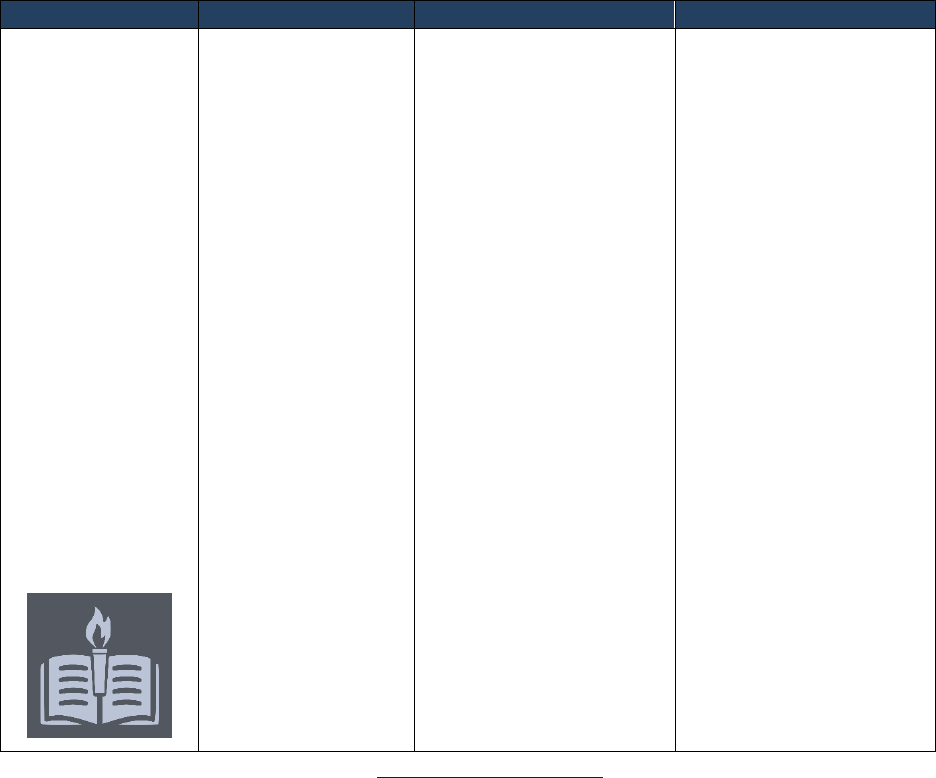
New York State Seal of Civic Readiness Manual 15
issues. For example, students arguing the question: How did the Industrial Revolution move
people? should analyze the development of policies and legislation and the impact they had on
workers and society at large. The Extension Activities and Taking Informed Action sections of
the inquiries are useful tools for including the domains of civic readiness into the research
project.
Applicable NYS Social Studies Framework-aligned C3 Inquiry topics and compelling questions
may include:
Grade 9
Grade 10
Grade 11
Grade 12
Did Shi Huangdi
improve China?
How “magnificent”
was Suleiman?
Was the French
Revolution
successful?
Is the Boxer
Rebellion
misrepresented?
How did the
Industrial Revolution
move people?
Can peace lead to
war?
What ended
apartheid?
Does development
mean progress?
(Analyzing
modernization in
African countries)
Did the Constitution
establish a just
government?
What does it take to secure
equality? (Debating
Reconstruction)
Was the vote enough?
(Analyzing women’s
suffrage movement)
Who’s to blame for the
Cold War?
What made non-violent
protest effective during the
civil rights movement?
How should the president
foster economic
opportunity? (Comparing
viewpoints and policies of
Johnson and Reagan
viewpoints)
Is anything new about
today’s immigration
policy debate?
Are students protected by
the first amendment?
Do we need the electoral
college?
Why is the Affordable
Care Act so controversial?
Does money matter in
political campaigns?
Who has the power?
(Analyzing federalism)
Is the Internet good for
democracy? Am I going to
vote?
What drives you to the
polls?
Do any political parties
represent me? Who’s to
blame for the Great
Recession? Should
corporations have a
conscience?
What should be done
about the gender wage
gap?
Teachers and students may also use the Inquiry Design Model to develop their own civics-based
inquiries and research projects.
What Makes for a Successful Civic Knowledge Research Project?
A 1e Civic Knowledge Research Paper asks students to:
• Examine a question (constitutional, historical, political, and/or social) through the lens of
civics.
• Research primary and secondary sources that enable them to analyze the history of the
topic, the structures that underlie or perpetuate the issue, and its relevance today.
• Evaluate the impact of the topic on the past and its connection to the present day.
• Present their research using written, audio/visual, oral, and/or multimodal formats.

New York State Seal of Civic Readiness Manual 16
Evaluation will be based on performance indicators included in Social Studies Practice A:
Gathering, Interpreting and Using Evidence. The full evaluation criteria and process will be
determined by the SCR Committee.
See Appendix F: Sample Research Project Rubric
Criteria for Demonstrating Civic Participation
Students who receive the NYSED Seal of Civic Readiness must earn a
total of six points, with at least two points from column #2 - Criteria for
Demonstrating Civic Participation. The options for this category include:
2a. Civic Skills, Actions, and Mindsets .................................................................. 1.5 pts.**
• Complete a high school civic project that demonstrates civic knowledge, skills,
actions, and mindsets, as established by the local Seal of Civic Readiness
Committee (SCRC).
2b. Civic Experiences Area I .......................................................................................... 1 pt.*
• Complete a service-learning project that includes a minimum of 25 hours of
demonstrated service to the community and submit a reflective essay/presentation.
2c. Civic Experiences Area II ..................................................................................... .50 pt.*
• Demonstrate proficiency in an elective course that promotes civic engagement (as
defined by SCR committee) and submit a written application of knowledge
essay/presentation.
2d. Civic Experiences Area III .................................................................................... .50 pt.*
• Participate in an extra-curricular program, or work-based learning experience that
promotes civic engagement or civic action for a minimum of 40 hours. Write an
application of knowledge essay/presentation. This may be accomplished over four
years of high school.
2e. Middle School Capstone Project ................................................................................ 1 pt.
• Complete the middle school capstone project that includes the essential elements
listed below:
○ Identify an issue (local, state, national, or global)
○ Apply civic knowledge, skills, actions, and mindsets to the issue
○ Present the overall project to the Middle School Capstone Committee.
2f. High School Capstone Project ................................................................................. 4 pts.
• Identify an issue (local, state, national, or global)
• Apply civic knowledge, skills, actions, and mindsets to the issue
• Engage in a civic experience based on the issue to influence positive change to the
community (local, state, national, or global)
• Present overall project to the school’s Civic Readiness Committee
*Students may receive these points more than once. Testing accommodations recommended in
an individualized education program or section 504 Accommodations Plan must be provided.

New York State Seal of Civic Readiness Manual 17
Students in schools with an alternate pathway for graduation approved by the Commissioner will
be held to those schools' criteria.
** Students may complete the high school civics project twice during their 9-12 school years,
maxing out at three points.
High School Civic Project
2a. High School Civic Project - 1.5 points
A High School Civic Project is a short-term project completed in either the classroom or as part
of an extracurricular organization that incorporates some of the essential elements of the Civic
Readiness Capstone Project. A Civic Project could also be integrated with a Service-Learning
Project. The Civic Project will demonstrate the NYSSCR domains of civic readiness, reflecting
students’ civic knowledge, skills, actions, and mindsets. Civic projects will be approved and
evaluated by a process established by the local Seal of Civic Readiness Committee (SCRC).
Students may receive these points twice during their 9-12 school years, maxing out at three
points. Students may complete their projects individually or collaboratively in groups.
In a High School Civic Project, students will:
• Focus on a civic issue or problem within a policy area that may be predetermined by the
teacher or advisor. The civic project is focused on a civic issue or problem that can be
interpreted in a variety of ways by a broad array of citizens holding various viewpoints.
• Analyze data, use primary and/or secondary sources of evidence related to the civic issue
under investigation, and determine its impact on communities. Sources should be
evaluated for bias and credibility. Sources can be provided by the teacher, advisor, or
student.
• Evaluate at least two current public policies related to the issue or problem under
investigation.
• Recommend and/or evaluate potential strategies to address the issue or problem that is
under investigation.
• Communicate their project using written, audio/visual, and/or oral presentations.
• Explain how the project influenced their civic knowledge, skills, and mindsets.
Example 1: The teacher assigns a project that focuses on the policy area of criminal justice
reform.
• Students are provided both quantitative and qualitative data on the Violent Crime Control
Act and Law Enforcement Act of 1994 (also known as the Clinton Crime Bill) and the
2018 First Step Act (passed under President Donald Trump) to evaluate the impact and
effectiveness of these criminal justice reform measures. The teacher may arrange guest
speakers (in-person or virtual) from law enforcement, prosecutors and defense attorneys,
and criminal justice reform activists for students to interview as resources. Prior to data
analysis, the teacher will instruct students on how to evaluate sources for accuracy, bias,
reliability, and credibility, perhaps with the assistance of the school librarian.
• Students evaluate the effectiveness of the two pieces of legislation and develop at least
one policy recommendation to improve the criminal justice system.
New York State Seal of Civic Readiness Manual 18
• Students persuasively communicate their evaluation of the pieces of legislation and their
recommended policy. This communication can take the form of a policy paper, an op-ed
essay, an audio/visual presentation, an oral presentation, etc. The teacher can encourage
student voice and choice in the format that the students use to communicate their work.
• Students will produce a reflection on the most challenging aspects of affecting policy as a
citizen. This will include advice for effective activism for other citizens that wish to
impact public policy.
Example 2: The Student Council advisor creates a committee of students to provide student
input to the administration on issues of equity and the school’s code of conduct.
• Students are provided with data about equity in schools, including op-ed columns
representing a diverse array of views, quantitative data on disciplinary trends, the NYS
School Report Card, articles on Restorative Justice, and other initiatives. Students may
also interview school administration, PTSA representatives, and fellow students about
equity.
• Students will determine whether the school can improve the school’s code of conduct in
terms of equity and make recommendations, if necessary, to that end.
• Students will create a written report, an audio/visual presentation, or an oral presentation,
etc. to communicate their recommendations.
• Students will produce a reflection on the most challenging aspects of affecting policy as a
citizen. This will include advice for effective activism for other citizens that wish to
impact public policy.
Example 3: Within a Participation in Government class, students chose civic issues that were
important to them and worthy of investigation.
• Using the Question Formulation Technique, students arrived at civic issues they wanted
to investigate. Civic issues pursued included how foster care policies impact children and
young adults in the system; authoritarian versus rehabilitative prison systems and their
implications on communities; public safety vs. personal freedoms in relation to local
COVID-19 vaccine mandates; how to prevent gun-related violence in schools; improving
health education to be inclusive of modern sexual health and welcoming for LGBTQ+
students; investigating wealth gaps and raising the minimum wage; advocating for
stronger legislation to curtail the use of single-use plastics in the food industry;
examining students’ first amendment rights in schools; and arguing for stronger policy
related to civic education in NYS schools.
• Students used primary and secondary sources to analyze the historical and current
backgrounds of their issues. Students evaluated current policies to determine impacts,
strengths, and gaps. Students analyzed evidence and data to determine the impact of the
issue on their local community including locally developed surveys and interviews.
• Students recommended/argued for specific strategies to address the issue or problem.
• Students reflected on how the project influenced their civic knowledge, skills, and
mindsets.
• Students worked both individually and in groups and communicated their project using
written and visual presentations.

New York State Seal of Civic Readiness Manual 19
Example 4: In a Participation and Government and IB Economics class, students spent multiple
weeks pursuing the question: How can I use my civic voice to impact public policy in my school,
community, state, or country?
• Students began by profiling the work of several young activists, ages 6-22, to familiarize
themselves with their causes and methods for achieving positive change.
• Students grounded themselves in the language of public policy and explored the concepts
of civic action and civic identity. Students grappled with their own civic identities and
analyzed issues, ultimately choosing one was important to them and worthy of
investigation.
• Students researched their issue using the following supporting questions to guide their
work: What information do I need to understand the issue? What is the history of the
issue? How are people impacted by the issue? What are the opposing viewpoints of the
issue? What data (polling numbers or supporting statistics) provides useful evidence as to
how the issue is a problem?
• Students researched the public policies relevant to their issues using the following
supporting questions to guide their work: What information do I need to understand
public policy related to this issue? What is the current policy on the topic -local, state, or
federal? What are suggestions by political parties, interest groups, or others to change this
issue? What are my thoughts, opinions, and arguments on the current policies?
• Students developed arguments for policy change using the following supporting
questions to guide their ideas: What change do I want to bring about on this topic?
• Who do I contact to bring about this change? How do I make a compelling argument and
or plan to make a change?
• Students ultimately organized their research and arguments into an 8-10 page paper that
included the following sections:
o Identify and Define the Problem
o Analyze and Evaluate Current Public Policies
o Evaluate Alternative Solutions
o Develop Strategies and Solutions
What makes a successful 2a Civics Project?
A 2a Civics Project asks students to:
• Complete a project related to a local, state, or national civics-based issue in which they
gather, interpret, evaluate, and use evidence to better understand the impact of the issue
on their community or other communities.
• Identify, describe, and evaluate at least two current strategies, policies and legislation that
currently address the issue.
• Develop evidence-based claims and argue for specific recommendations, strategies or
improvements that address the issue.
• Communicate their findings using written, audio/ visual, oral, and/or multimodal
presentation
• Reflect on what they have learned about their role in the civic life of their community by
engaging with the project by explaining how the project influenced their civic
knowledge, skills, and mindsets.
See Appendix G: Sample High School Civics Project Rubric

New York State Seal of Civic Readiness Manual 20
Service Learning
2b. Civic Experiences Area I - Complete a Service-Learning Project - 1 point
• Complete a minimum of 25 hours of demonstrated service to the community
• Write and submit a reflective essay/presentation
• Students may receive these points more than once
What is Service Learning?
Service learning is an inquiry-based, experiential learning approach that teaches curriculum-
based objectives through meaningful service to the community. Service learning is more
complex than community service – students engage in meaningful opportunities to apply what
they learn to issues that matter to them. In addition, service learning involves investigation,
preparation, action, and reflection. High-quality service learning goes beyond a requirement of
minimum hours of service in a course. Students are required to use academic skills and
knowledge to understand community needs to complete a service-learning project that serves the
greater good of the community and to reflect upon their role as members of their community.
Service-learning projects are typically organized into five stages:
1. Investigation - conduct research on a community-based problem or needs
2. Preparation - create a plan to address these needs
3. Conduct Action
a. Direct service - Service involves hands-on, face-to-face interactions
b. Indirect service - Action is not seen by the people who may directly benefit from
the service; however, the action meets a real need.
c. Advocacy - Students educate others about a particular issue with the goal of
inspiring action to address the issue
4. Reflection - required to earn the point for the NYSED Civics Diploma Seal
5. Demonstration/celebration - can be combined with the presentation of the project and
reflection
How does service-learning support civic readiness?
Service learning provides students with the opportunity to make positive contributions to their
communities. Service learning can “spark the civic imagination of students of all ages as they
begin the lifelong habits of engaged learning and active citizenship. Given opportunities to use
the knowledge and skills they learn in school to address meaningful issues in the community,
students gain an understanding of the importance and benefits of civic participation and how to
effectively engage in our democracy.”
3
3
Guardian of Democracy: The Civic Mission of Schools, page 32, https://www.carnegie.org/publications/guardian-
of- democracy-the-civic-mission-of-schools/

New York State Seal of Civic Readiness Manual 21
Effective service-learning programs share the following eight traits:
1. Have sufficient duration and intensity to address community needs and meet specified
outcomes.
2. Are used intentionally as an instructional strategy to meet learning goals and/or content
standards.
3. Incorporate multiple challenging reflection activities that are ongoing and that prompt deep
thinking and analysis about oneself and one’s relationship to society.
4. Actively engage participants in meaningful and personally relevant service activities.
5. Promote understanding of diversity and mutual respect among all participants.
6. Are collaborative, and mutually beneficial and address community needs.
7. Engage participants in an ongoing process to assess the quality of implementation and
progress toward meeting specified goals and use results for improvement and sustainability.
8. Provide youth with a strong voice in planning, implementing, and evaluating service-learning
experiences with guidance from adults.
National Youth Leadership Council, “K–12 Service-Learning Standards for Quality Practice,” (2008)
How to plan for a Service-Learning Project?
When planning for a Service-Learning Project, use the following guidance:
• The most meaningful service-learning projects are personally relevant to students and
their interests. Surveying students to determine their interests is an important early step
when introducing service learning to students. The format, length, and focus of the
service-learning experiences should be age-appropriate and meaningful to the students.
• Service-learning projects are most effective when connected to the curriculum and high-
quality projects are integrated into the curriculum. Service-learning projects can be
organized in many academic disciplines.
• In both middle and high school settings, teachers will lead students through the five
stages of service learning. For example, in grade 8, an interdisciplinary team of teachers
could organize a service-learning experience in which students cleaned and decorated bus
shelters in their town to spread messages of cultural appreciation. Students applied their
knowledge by creating posters, which were installed as bus shelter panels. Cleaning and
decorating bus shelters also sparked conversations about being more respectful of public
property.
• With time, students with more experience with service-learning may be able to complete
the stages of service-learning independently or with a small group of students with the
facilitation/mentorship of an adult.
• Investigation into a community issue can be completed independently or within an
academic course.
• Educators that organize service-learning projects will need to be familiar with
School/District policies and regulations on fundraising, field trips and if applicable
volunteers/community partnerships.
• Community partners are essential to provide placements for students to complete direct
service-learning. Teachers/administrators will need to develop relationships with
community partners to facilitate these placements. Service-learning projects are most

New York State Seal of Civic Readiness Manual 22
often completed with nonprofit tax-exempt organizations. Learning about the work of a
community partner and its financial status, sources of funding, etc., should be included as
part of the investigation component of a service-learning project. Some schools organize
community fairs and invite community partners to attend to help students learn about the
scope of their work.
• Reflection on service-learning should occur prior, during and after the completion of the
service-learning project.
Reflective essay/presentation:
To earn points toward the NYSED Civics Diploma Seal for completing a service-learning
project, students are required to submit a reflective essay/presentation that describes the impact
of their service-learning.
Reflection opportunities must be incorporated before, during, and after the service-learning
experience. Reflection activities completed prior to the service-learning experience can focus on
helping students anticipate what their service-learning experience will be like and what
assumptions they are bringing into the situation. Reflection that occurs during and after the
service-learning experience helps students understand the actual outcome of their experience in
relation to their academic experiences. Reflection questions can help students understand
themselves, the population they are serving, the social issue driving their service activity, and the
relationship between the service and their civics knowledge, skills, and mindset.
• The reflective essay/presentation assignment and evaluation criteria will be locally
developed.
• Schools are strongly encouraged to ask students to self-assess their service-learning
experience and reflections.
• Sample questions are provided
4
to assist committees in developing the assignment and
evaluation tools.
Issue-focused questions:
• Why is there a need for your service?
• What do you perceive as the underlying issue, and why does it exist?
• What social, economic, political, and educational systems are maintaining and
perpetuating the situation?
• What can you do with the knowledge you gained from this experience to promote
change?
Client-focused reflection questions:
• What similarities do you perceive between you and the people you are serving?
• How are you perceived by the people you are serving?
• What do you think a typical day is like for the people you serve? What pressures do they
confront?
4
From Center for Innovative Teaching and Learning, Indiana University at Bloomington, Reflection in Service
Learning, accessed March 8, 2021,
https://citl.indiana.edu/teaching-resources/teaching-strategies/reflection-service-
learning/index.html

New York State Seal of Civic Readiness Manual 23
Self-focused reflection questions:
• What personal qualities (e.g., leadership, communication skills, empathy etc.) have you
developed through service-learning?
• What contribution can you make to public understanding of this issue based on your
service-learning experience?
• In what ways are you finding your involvement with service-learning difficult? What
have you found that is helping you follow through despite these difficulties?
What makes a Successful Service-Learning Project (2a)?
Evaluation Criteria:
Evaluation criteria for the reflective essay/presentation will be locally developed as they will
reflect how the service-learning project was organized. The evaluation of a student’s reflective
essay/presentation should include an evaluation of selected students’ Civic Knowledge, Civic
Skills and Actions, Civic Mindset and Experiences listed in the Civic Readiness Domains.
See Appendix H: Sample Service-Learning Evaluation
See Appendix I: Sample Service-Learning Rubric
See Appendix J: Service-Learning Resources
Elective Course work
2c. Civic Experiences II - Demonstrate proficiency in an elective course that promotes civic
engagement - .50 points
These courses will be locally determined and may exist within disciplines other than social
studies. Acceptable courses will be determined by the district’s Seal of Civic Readiness
Committee. Examples include but are not limited to public speaking, literature of the civil rights
movement, leadership skills, news literacy, and separate courses that are designed to support
students as they pursue the Seal of Civic Readiness (Civics in Action, Contemporary Issues in
America, Public Policy, Capstone Civics, etc.). To receive credit towards the Seal of Civics
Readiness, students must complete and submit a Civic Participation Application of Knowledge
Reflection. For elective courses, Civic Participation Application of Knowledge Reflections will
be evaluated by a process established by the local Seal of Civic Readiness Committee (SCRC) in
accordance with the guidance below. Students may receive these points more than once.
See Appendix K: Application of Knowledge Component
Extra-curricular or Worked-Based Learning Experience
2d. Civic Experiences III - Extra-curricular program, or work-based learning experience
that promotes civic engagement or civic action - .5 points
• Must be a minimum of 40 hours.
• Write an application of knowledge essay/presentation.
• This may be accomplished over four years of high school.
• Students may receive these points more than once.

New York State Seal of Civic Readiness Manual 24
This component was designed to be flexible to recognize how clubs and responsibilities outside
of school can shape a student’s civic engagement. This includes working after school,
participating in Mock Trial, Model UN, or taking a leadership position in any extra-curricular
organization. These programs will be determined at the local district level and are not limited to
social studies related activities.
Definition of Work-based learning (according to: NYSED CTE WBL Manual)
Work-based learning is authentic learning experiences that allow students to explore their career
goals, abilities, and interests while applying their academic and technical knowledge and skills in
a real-world context. These experiences are planned and supervised by instructional staff in
collaboration with business, industry, or community partners. High quality work-based learning
will provide effective and equitable experiences to empower all students to become confident
workers and culturally competent citizens of New York State.
Please note: The Work-Based Learning experiences incorporated into BOCES CTE
programming may count as the Seal of Civic Readiness Work-Based Learning experiences. This
is a local school district decision. It will be the responsibility of the local school to create and
assess the Application of Knowledge component of this category.
See Appendix L: Work-Based Learning Definitions and Examples
See Appendix M: Sample Extracurricular Activities
Middle School Capstone Project
2e. Middle School Capstone Project – 1 pt.
The Middle School Capstone Project is designed to give students a meaningful and foundational
civic experience before they enter high school. The project should be completed under the
direction of a teacher with requirements that reflect the elements listed below.
• Identify an issue (local, state, national or global)
• Apply civic knowledge, skills, actions, and mindsets to the issue
• Reflect on their learning
• Present the project to a wider audience
A Middle School Capstone committee of at least three educators, including at least one social
studies teacher, should be formed at the middle school level. This committee will collaborate
with teachers to develop Middle School Capstone project(s) ideas and evaluation criteria. The
committee will review projects to determine if students meet the criteria set by the school to
receive the one point of credit toward the Seal of Civic Readiness. At the middle school level,
students are not required to present to the entire Middle School Civic Readiness Committee.
However, students should present their completed projects to their advisor/teacher and a group of
classmates.
The Middle School Capstone can also include a service option which will allow students to
volunteer within their school or community. Civic action or service can be very beneficial but

New York State Seal of Civic Readiness Manual 25
requires significant parental and/or school support. At the middle school level, service is not
required as part of the Middle School Capstone Project.
In developing guidelines for a Middle School Capstone Project, schools may want to develop a
process that includes the following elements:
1. Under the direction of a teacher, students identify an issue or problem in their school,
community, the nation, or the world as their area of focus. While some schools may
decide to assign topics, the most meaningful projects are personally relevant to students
and their interests. For example, projects might include hunger or food
scarcity/insecurity, cancer, homelessness, endangered animals, preservation of hunting
land, climate change, animal cruelty, access to youth athletics, juvenile diabetes, human
rights, drug and alcohol abuse, issues surrounding family farms, etc.
2. Students develop a guiding question for their inquiry and then research the issue or
problem they identified using multiple primary and secondary sources under the guidance
of their advisor/teacher. Relevant research should be analyzed, with sources cited. While
not required, students may want to contact organizations or individuals who are helping
with their chosen issue for more information or an online interview. Letter writing can be
included as an element in the project. Please note that any student contact with
organizations or individuals outside of the school should follow procedures and protocols
that have been developed by the school.
3. After the completion of their research, students develop either a service action plan or a
detailed action plan.
Option A
Service Action Plan: Students develop an action plan that focuses on how individuals can
make a difference with the chosen problem or issue. After developing the plan, students
should complete service hours as determined by the school.
Option B
Detailed Action Plan: Students develop a detailed action plan that includes:
• Analyze research and data to determine the impact of the issue on the community.
• Evaluate several possible solutions to address the problem.
• Recommend one strategy and develop a detailed plan to implement that strategy.
4. Students should reflect on what they have learned about their role in civic life and the
community.
5. Students will present their middle school capstone project to their teacher/advisor and a
group of students determined by the school
See Appendix O: Middle School Capstone Project Essential Elements

New York State Seal of Civic Readiness Manual 26
High School Capstone Project
2f. High School Capstone Project – 4 pts.
What is a Capstone Project? What does a Capstone Project assess?
A Capstone Project is a culminating assignment typically completed by students at the end of
their final year of study in high school or college. Capstone Projects may be based in any
academic subject area. Students typically create a portfolio, a final product, presentation, or
performance. High quality Capstone Projects are generally designed to encourage students to:
1. Think critically
2. Solve challenging problems
3. Take action(s)
4. Practice skills related to the academic discipline and interdisciplinary skills such as oral
communication, research skills, media literacy, teamwork, and planning
What is a New York Civic Readiness Capstone Project?
In New York, the Civic Readiness Capstone Project is a culminating, experiential, summative
project assessing a student’s Civic Knowledge, Skills and Actions, and Civic Mindset that will
be:
• Social Studies Standards-based
• Locally developed
• Authentic, hands-on, and include real-world investigation and application
5
In addition to students’ preparation through the Pre-K-12 Social Studies program, students have
gained knowledge and applied skills in other disciplines that will help them complete the Civic
Readiness Capstone Project. For example, students’ skills and competencies that enable
communication, spoken and written, in increasingly diverse ways and with increasingly diverse
audiences have been developed through their P-12 English/Reading course work. Students’
research skills have been developed in English, Science and Social Studies coursework.
Students have experience with asking questions and defining problems, developing, and carrying
out investigations, analyzing and interpreting data from their math and science coursework.
Capstone Projects required for graduation (i.e., Colorado) are typically aligned with
postsecondary and workforce readiness requirements.
Finally, Capstone Projects allow for schools to create authentic interdisciplinary learning
experiences for students that while rooted in Social Studies, have deep ties and explicit
connections to the expectations and learnings laid out in the NYSED CR-SE Framework and the
NYSED SEL Benchmarks.
In a Civic Readiness Capstone Project, students will:
• Work independently or in groups
• Identify a civic issue (problem) facing them, their school, or their community
5
From “A Discussion of the Pathways to a New York State Diploma,” Presentation to NY Board of Regents,
December 2018

New York State Seal of Civic Readiness Manual 27
• Analyze a civic issue (problem), evaluate alternative solutions, design and/or execute a
solution for this problem
• Take informed action to address the civic issue
• Reflect on what they have learned about their school or community from the Capstone
project
• Make a presentation about their Civic Readiness Capstone project to the School Civic
Readiness Committee
When would students complete a Civic Readiness Capstone Project?
• Since the Civic Readiness Capstone Project is a component of the Seal of Civic
Readiness, we recommend students complete a Civic Readiness Capstone Project in 11th
or 12th grade. Students may begin working on the Capstone Project in an earlier grade if
appropriate support and mentoring is available to them.
• Students can complete a Capstone Project within a course curriculum or as an
independent study/project.
• Below are excerpts from the New York’s Grades 9-12 Social Studies Civics Practices
which outline a partial framework for the development of a Civics Capstone Course.
New York State Social Studies Practices, Grades 9-12
F. Civic Participation:
2. Participate in activities that focus on a classroom, school, community, state, or national issue
or problem.
5. Participate in persuading, debating, negotiating, and compromising in the resolution of
conflicts and differences.
6. Identify situations in which social actions are required and determine an appropriate course
of action.
7. Work to influence those in positions of power to strive for extensions of freedom, social
justice, and human rights.
8. Fulfill social and political responsibilities associated with citizenship in a democratic society
and interdependent global community by developing awareness of and/or engaging in the
political process.
The Grade 12 Participation and Civics Curriculum Framework also includes content that could
form the basis for the student experiences in a Civics Capstone course:
○ 12.G3 Rights, Responsibilities, and Duties of Citizenship: Active, engaged, and
informed citizens are critical to the success of the United States representative
democracy. United States citizens have certain rights, responsibilities, and duties, the
fulfillment of which help to maintain the healthy functioning of the national, state, and
local communities.
○ 12.G4 Political and Civic Participation: There are numerous avenues for engagement in
the political process, from exercising the power of the vote, to affiliating with political

New York State Seal of Civic Readiness Manual 28
parties, to engaging in other forms of civic participation. Citizens leverage both electoral
and non-electoral means to participate in the political process
12.G4e Citizens participate in civic life through volunteerism and advocacy,
including efforts such as contacting elected officials, signing/organizing petitions,
protesting, canvassing, and participating in/organizing boycotts.
○ 12.G5 Public Policy: All levels of government—local, state, and federal—are involved
in shaping public policy and responding to public policy issues, all of which influence
our lives beyond what appears in the Constitution. Engaged citizens understand how to
find, monitor, evaluate, and respond to information on public policy issues.
*Please note that whether students work on the Capstone individually or in groups, individual
students will need to meet the locally developed requirements for the Capstone Project that are
aligned with the Essential Elements if using the Capstone to earn the Diploma Seal of Civic
Readiness.
How does completing a Civic Readiness Capstone Project demonstrate students’ readiness
for civic engagement?
The Civic Readiness Capstone Project will provide students with an opportunity to apply and
demonstrate Civic Knowledge, Civic Skills and Actions, and use a Civic Mindset to participate
in activities that focus on a school or local community issue. The Essential Elements of the
Capstone project (see Appendix P) requires students to examine their community, identify
issue(s), conduct research into the contemporary and historical context of the issue, conduct
analysis, develop strategies and solutions, take informed action, and reflect on their learning
through the Capstone.
What do schools/Districts need to do to implement the Civic Readiness Capstone Project?
• Step 1: Convene the school’s Seal of Civic Readiness Committee
o Appoint a committee to design and evaluate the Capstone Project
Consider including community representatives on the Committee
• Step 2: Develop a structure for the Capstone
o Develop a timeline for the completion of the Capstone
o Develop the course structure within which the capstone project will live (i.e.,
Independent Study, a 12th grade course meeting the requirement for Participation
in Government, a (Civics) Capstone Course, etc.)
• Step 3: Draft High School Civics Capstone Plan and Materials
o Draft materials, student and teacher facing for the Capstone project
o Develop evaluation tools (i.e., rubrics) to evaluate student progress during the
work on the Capstone (i.e., formative assessment) and a summative evaluation of
the Capstone
o Share the materials with the school’s Seal of Civic Readiness Committee for
feedback
• Step 4: Create a plan for appropriate professional learning for teachers supporting the
capstone work
o Should teachers attend training?
o What training might be appropriate for teachers to attend?
New York State Seal of Civic Readiness Manual 29
• Step 5: Develop relationships with community organizations (as necessary)
o Create MOUs or other partnership agreements as necessary
What are the ideal circumstances for implementation of a Civic Readiness Capstone
Project?
• Ideally, the Civics Capstone Project is completed in a course that is dedicated solely or
partially to this project - i.e., a semester or trimester course dedicated to the Civics
Capstone Project
• Ideally, students are matched with faculty advisors or mentors to help them present the
Civics Capstone Project to the Civic Readiness Committee at a midpoint evaluation for
feedback
• Ideally, students present their civics capstone project to the School’s Civics Readiness
Committee at the end of the course
• Students partner with community organizations or community leaders to take action
What are some examples of informed actions taken by high school students in civic
engagement projects?
Teachers and students will work together to determine appropriate actions that can be taken by
students. Examples include:
• Organizing students to meet with the school principal to present petitions about changing
school rules
• Meeting with local legislators to lobby for a change in local laws
• Organizing and participating in a debate
• Writing editorials or creating social media campaigns to raise awareness about a local
issue such as a transportation desert
• Organizing a campaign to raise awareness of mental health support systems that might be
available at a school or school district
• Starting a sustainable community garden for a school or community.
In addition to participating in action, students should also reflect on what they have learned about
their civic identity from their action and analyze the consequences (the benefits and costs) of the
course(s) of action taken.
How will schools evaluate Civic Readiness Capstone Projects?
Schools should develop evaluation tools, including scoring rubrics, based on the Essential
Elements of the Civics Capstone Project. Students will need both formative and summative
feedback on their Civics Capstone Projects. Schools will need to develop project timelines with
associated benchmarks to ensure a timely completion of the Civics Capstone Project if it is being
used as a requirement for the Seal of Civic Readiness.
Can students compile a portfolio for their Civic Readiness Capstone Project?
Yes, students can organize a portfolio to collect the elements of their Civics Capstone Project. A
portfolio would include artifacts from the Essential Elements and different stages of the project
and a summative reflection on the Civics Capstone Project experience, reflecting on the process
that was implemented, challenges that were faced, project limitations, successes, future civic

New York State Seal of Civic Readiness Manual 30
actions, and transferable skills. The reflection will also address the student’s sense of self as an
active participant in society, willing to contribute to solving local and/or national problems.
Social Studies teachers will benefit from professional development on principles of portfolio
design to help students select appropriate artifacts for their portfolio. Schools/districts will need
to develop guidelines and criteria for student portfolios if they are evaluated as the summative
assessment for the Civics Capstone Project.
Can students complete a research paper for their Civic Readiness Capstone Project?
No. A research paper would not contain the Essential Elements of a Civics Capstone Project.
Students can complete a Research paper on a civic engagement-related issue and use that for 1
point toward the Seal of Civic Readiness Criteria for Civic Knowledge.
See Appendix P: High School Capstone Project Essential Elements
See Appendix Q: Sample of a Student High School Civic Capstone Project
How Schools and Districts Can Offer the Seal of Civic Readiness
Public schools, charter schools, and registered nonpublic schools that wish to offer the Seal must
complete the Seal of Civic Readiness +1 Civics Pathway application through the NYSED
Business Portal and receive approval from NYSED. Applicants will describe the following:
goals, communication plan, student tracking system, projected enrollment, connection to
NYSED Diversity, Equity and Inclusivity Initiative, advisement, and evaluation plans. For more
information about the application process see Appendix A: Seal of Civic Readiness Application
Instructions.
At the conclusion of every school year, schools that were accepted to offer the Seal of Civic
Readiness will be required to report the number of Seal recipients, the names and titles of their
Seal of Civic Readiness Committee members, and any changes to the school’s program through
the NYSED Business Portal.
How BOCES, P-Tech Programs, Regional High Schools, and Other Educational Entities
Can Offer a Seal Program
BOCES and other educational entities that enroll students from one or more districts, and which
do not confer high school diplomas for some (out of district) or all enrolled students, that would
like to offer coursework and learning experiences that would provide students with the
opportunity to attain the Seal, must complete the Seal of Civic Readiness application through the
NYSED Business Portal and receive approval from NYSED.
Applicants must describe the following: goals, communication plan, student tracking system,
projected enrollment, connection to NYSED Diversity, Equity and Inclusivity Initiative,
advisement, and evaluation plans. Please see Appendix B: Seal of Civic Readiness Application
for Educational Entities.

New York State Seal of Civic Readiness Manual 31
In addition, entities wishing to offer a Seal of Civic Readiness Program which would provide the
coursework and educational experiences that would allow students to complete the requirements
to obtain the Seal of Civic Readiness must do the following:
1. Provide a description and documentation of the proposed Seal Program to all
Superintendents of districts that enroll students in the program;
2. Provide a copy of Appendix C: Application for Districts to Grant the Seal of Civic
Readiness to Students who Complete the Seal Program outside of the District to all
districts that enroll students in the program; and
3. Collect signed applications from all districts to submit with the application, per the
instructions found in Appendix B.
Frequently Asked Questions
The Seal of Civic Readiness and How to Apply
Q1: What is the New York State Seal of Civic Readiness (NYSSCR)?
A: The Seal of Civic Readiness is a formal recognition that a student has attained a high level of
proficiency in civic knowledge, civic skills, civic mindset, and civic experiences. The Seal of
Civic Readiness distinction on a high school transcript and diploma
• Indicates the student’s understanding of and commitment to participatory government,
civic responsibility, and civic values;
• Provides universities and colleges with a method to recognize and provide credit for
attainment of higher level of understanding and skills in Social Studies;
• Demonstrates to universities, colleges, and future employers that students have earned
recognition for their civic knowledge, skills, mindset, and experiences; and
• Recognizes the value of civic engagement and scholarship to school communities and
society at large.
Q2: What are the benefits for implementing the NYS Seal of Civic Readiness in School
Districts?
A: High quality, school-based civic learning fosters civic knowledge, skills, attitudes or
dispositions, and promotes civic equality and engagement. It connects scholarship to real-world
learning experiences that promote active civic participation in communities. In addition,
progression through the skills and competencies of the Seal include:
• Fostering Civic Knowledge, Skills, Mindsets: When students engage in school-based
civic learning and civic action projects they broaden and deepen their civic knowledge
and understanding, and their civic mindsets are nurtured and refined.
• Promotes Civic Equity: Universally available, high-quality civic learning opportunities
can help by elevating historically marginalized voices and communities.
• Builds 21st Century Skills: Students develop and hone presentation, media-literacy,
collaborative, critical thinking, and problem-solving skills.
• Improves School Climate and Community Involvement: Real world learning
experiences further connects students to their schools and neighborhood communities.
Through civic action projects, young people learn how to navigate the world outside of

New York State Seal of Civic Readiness Manual 32
the classroom, learn respectful dialogue, collaboration and teamwork, and develop an
appreciation for diversity.
Q3: Is the Seal of Civic Readiness part of the College, Career, and Civic Readiness (CCR)
Index for ESSA?
A: The CCR Index calculates the percentage of students in the accountability cohort who
demonstrate readiness as measured by diplomas, credentials, advanced course credits and
enrollment, technical education certifications, HSE diplomas and other similar indicators. The
index is on a scale of 200 and each student in the cohort can earn a maximum of two points
towards the index. For example, if a school has 100 students and all earn two points, the school’s
index score would be 200. You can find the weight assigned to the different indicators of
readiness on the State Accountability Resource Tool (StART) Educator Guide here. Graduating
with a Seal of Civic Readiness has a weight of two. Students who demonstrate readiness through
multiple indicators get credit for the one with the highest weight.
Q4: What are the requirements for students interested in receiving the NYSSCR?
A: Students who wish to receive the NYS Seal of Civic Readiness shall complete all
requirements for a New York State local or Regents diploma.
Q5: Who awards the NYSSCR to the students?
A: The NYSSCR is an award given by a school that has been approved by NYSED to grant the
Seal. The school formally recognizes students who have demonstrated proficiencies in civic
knowledge and participation by high school graduation.
Q6: Can the Seal of Civic Readiness be granted to students who are earning a local
diploma?
A: Yes, the Seal of Civic Readiness is open to all students who earn a NYS diploma.
Q7: What are the criteria for attaining the NYS Seal of Civic Readiness?
A: The criteria require students to meet both academic and participation criteria. There is a level
of choice for students that is reflective of the diversity of their experiences and backgrounds as
well as the diversity of New York State school systems. Students must demonstrate proficiencies
in civic knowledge and civic participation as measured in the Seal of Civic Readiness criteria.
Q8: Is there a cost to students for the Seal?
A: No. A fee may not be charged to students who participate in the NYSSCR program.
Q9: Who provides the physical Seal and any graduation regalia to the students?
A: It is the school’s or district’s decision whether to provide physical printed seals. The
Department does not provide physical seals, but an electronic image of the seal will be made
available by the Department.
Q10: To get more information on and/or to ask questions about the New York State Seal of
Civic Readiness, which office do I contact?
A: Contact the Office of Standards and Instruction at [email protected].

New York State Seal of Civic Readiness Manual 33
Q11: Where is the application located?
A: The application to offer the Seal of Civic Readiness +1 Civics Pathway is now available for
all districts and schools in the SED Monitoring and Vendor Performance System located within
the Application Business Portal.
Q12: Is there a role for community members or organizations?
A: Yes. Civic readiness and engagement involves students interacting in meaningful ways with
the local community, government representatives, civic organizations, etc. The role of civic
groups and organizations is extremely important to the process. There are several entry points for
districts to involve community members or organizations. Districts may choose to include a
community member on its NYSSCR committee, as a member of the evaluation committee for
the student’s civic project, or as student mentors.
Q13: In districts with multiple high schools, can a single high school create its own
program?
A: Yes. In large school districts with multiple high schools, a single high school may form a
SCR committee and create an independent NYSSCR program within the district.
Q14: What information do schools need to submit to NYSED if they plan to award the
Diploma Seal?
A: Schools need to complete the Seal of Civic Readiness Application on NYSED’s business
portal. This application will include contact information and detailed narratives describing how
the district will provide opportunities for students to earn the Seal of Civic Readiness.
Q15: Is there a timeline for NYSSCR program activities?
A: The school-based SCR Committee will be responsible for creating a timeline for all activities
pertaining to the NYSSCR program. This will include outreach, a student advisement schedule,
and dates for important benchmarks throughout the year.
Student and Community Outreach
Q16: When should a student be educated about NYSSCR?
A: Guidance counselors and teachers may begin speaking to students as early as possible so that
they may begin planning their course of study and potential projects. While this is designed as a
culminating high school project, students may begin developing ideas or becoming engaged in a
civics-related course of action much earlier. Possible entry points for planning and involvement
may begin in the early high school years, middle school, and even elementary school. Students
can earn points toward the NYSSCR by completing a Middle School Capstone Project.
However, students are not at a disadvantage if they begin the Capstone project in high school.
Q17: Can students begin working towards a NYSSCR before high school?
A: Yes. Students can earn points toward the NYSSCR by completing a Middle School Capstone
Project. Schools/Districts are advised to create a Middle School Seal of Civic Readiness
subcommittee to collaborate with Social Studies teachers to develop the Middle School Capstone
project(s).

New York State Seal of Civic Readiness Manual 34
Q18: How should the District’s Seal of Civic Readiness Committee promote the Seal?
A: The District’s committee must decide on methods for communicating the NYSSCR program
to its students, parents, faculty, and community, which may include informational meetings,
parent letters, newsletters, school website, workshops, assemblies, and coverage in the local
media. Information presented would contain background information on the NYSSCR, NYSSCR
contact information, the student application process, the advisement process, and proficiency
criteria.
Advisement
Q19: Should students be set up with an advisor after they apply?
A: Once the committee has received the application, it is recommend but not required that
students be assigned an advisor who will remain with the student through the completion of the
program requirements. Ideally, the advisor will review the requirements with the students and
meet with him/her on a regular basis.
Components of the Seal of Civic Readiness application packet will include:
• NYS Seal of Civic Readiness Student Application, which may include a self-
assessment
• NYS Seal of Civic Readiness student, mentor, and school counselor checklists
Q20: If a student scores Mastery on a Regents Exam, do they get points for proficiency and
mastery?
A: No. Students will earn either 1.0 or 1.5 depending on their score on exams. A student will
earn 1 point for scores between 65-84 and 1.5 point for each score between 85-100. Students
who are eligible for 55-64 safety nets and 45 variances will also earn 1 credit per exam.
Q21: Can students who are participating in remote learning earn the Seal?
A: Yes. The participation requirements may be completed in remote learning environments.
Q22: When can students start earning points for the Seal of Civic Readiness?
A: The Middle School Capstone Project may begin in Grade 7 or 8. All other points may be
earned in Grades 8-12.
Q23: Once a school or district is approved to grant students the Seal of Civic Readiness,
may students count work they did before their school was approved?
A: Yes. Students may retroactively count any work they did from Grades 7-12 as outlined above.
This will be a local district decision.

New York State Seal of Civic Readiness Manual 35
Appendix A: Seal of Civic Readiness Application Instructions
Seal of Civic Readiness Application
Information and Guidance
Overview
This document is intended to provide guidance for schools and districts on the creation and
submission of the Seal of Civic Readiness +1 Civics Pathway Application.
Regulations
8 CRR-NY 100.5(i), New York State Seal of Civic Readiness
8 CRR-NY 100.5(d)(13), Civics Pathway
School District participation in The Seal of Civic Readiness +1 Civics Pathway is voluntary.
Schools who wish to offer this pathway shall:
(i) submit an application for approval to the Commissioner, in a form and by a date
prescribed by the commissioner, for the school District to participate in the program.
Such application shall include a narrative that describes how the District will implement
the NYS Seal of Civic Readiness program, including plans for program communications,
processes pertaining to student tracking, advisement and evaluation, and timeliness and
benchmarks for the program;
(ii) maintain appropriate records in order to identify students who have earned a NYS Seal of
Civic Readiness. At the end of each school year in which a school District participates in
the program, the school District shall submit a report to the commissioner, in a form and
by a date prescribed by the commissioner, that includes the number of students receiving
the Seal along with relevant data including, but not limited to the criteria chosen under
subparagraph (4)(ii) and (iii) of this subdivision; and
(iii) establish and identify a NYS Seal of Civic Readiness Committee (SCRC).
(a) The SCRC shall include, but is not limited to, the following personnel:
(1) at least one Social Studies teacher;
(2) at least one School Counselor or other staff who will track student progress on
earning the Seal; and
(3) at least one administrator or other staff member who will serve as the main
contact with the Department to collect data on school offerings and submit
copies of student work to the Department if requested.
(b) The SCRC shall:
(1) create a NYS Seal of Civic Readiness plan that includes, but is not limited to,
details concerning communications, student advisement, evaluation, and
presentation of awards;
(2) create a master list of all available courses and extra-curricular activities
pertaining to the NYS Seal of Civic Readiness program within their high
school including, but not limited to dates for required benchmarks throughout
the program year;
(3) develop a student tracking process, including an application process to be
completed by interested students and reviewed by an advisor;

New York State Seal of Civic Readiness Manual 36
(4) review and approve potential service learning, extracurricular and work-based
learning experiences, the Middle School Capstone Project if available, Civic
Projects and Civics Capstone Projects in accordance with Commissioner’s
guidelines; and
(5) review and evaluate all coursework, assessments, and civic experiential
learning completed by each student to ensure criteria for the seal are met.
The method by which NYSED collects information on The Seal of Civic Readiness +1 Civics
Pathway is an application through the SED Monitoring and Vendor Reporting System.
NYSED Goals
The intent of the NYS Seal of Civic Readiness is to encourage the study of civics and civility
through experiential learning; certify attainment of civic readiness; provide employers with a
method of identifying high school graduates with skills in civics and civility; provide universities
with an additional method to recognize applicants seeking admission; prepare students with
twenty-first century skills; recognize the value of K-12 Social Studies education in schools as a
means to build civic knowledge; empower students as agents of positive social change to redress
historical and contemporary oppression; and strengthen our diverse democracy. The NYS Seal of
Civic Readiness shall be awarded to students who meet the criteria of this subdivision and
complete all criteria prescribed by the Commissioner at a New York State high school approved
by the Commissioner to offer the NYS Seal of Civic Readiness.
Submission Process
School District superintendents, or their designees, will submit essential information about the
Seal of Civic Readiness +1 Civics Pathway through an application issued through the SED
Monitoring and Vendor Reporting System.
Districts must complete all sections and enter answers directly into the application. NYSED will
review plans and may communicate with the applicants if answers are not complete or thorough.
The applicant may be required to communicate with NYSED for clarification or to provide
additional information. Once any concerns are addressed and properly corrected, plans will be
approved.
Access to the Survey
To access the SED Monitoring and Vendor Performance System:
Go to the NYSED Business Portal;
Click on the “Log In” button;
Enter your username and password;
Click on “SED Monitoring and Vendor Performance System” under My
Applications;
Select “NYSED Seal of Civic Readiness +1 Civics Pathway Application”
Click on ‘view’ to begin/continue to input information.

New York State Seal of Civic Readiness Manual 37
The superintendent will have automatic access to the plan. The superintendent will need to
delegate access to the person or persons completing the plan through SEDDAS, the SED
Delegated Account System, which manages access to SED web-based applications through the
Application Business Portal. Granting these permissions will NOT provide access to any other
information in the portal. The superintendent is the only individual that has submit/certify rights
and will therefore need to submit the plan when it is ready to be reviewed. For questions
regarding the entitlement process, please see the SEDDAS mini guide for entitling users to SED
Monitoring.
Timeline
This one-year application will enable a District to offer the Seal of Civic Readiness for the
upcoming school year.
The deadline to submit the application to NYSED to guarantee that the application will be
reviewed in time for Spring graduation is August 1
st
of the current school year. NYSED will
continue to review applications received after August 1
st
on a rolling basis. Applicants will be
notified of their application status, also on a rolling basis.
Structure of the Guidance
The following pages outline the specific information that districts will be required to enter in the
SED Monitoring system survey. Guidance is provided in italics below each question. The
questions below provide a framework for planning and provide relevant information to support
the development of a Seal of Civic Readiness +1 pathway program. Responses should be
thorough. A more comprehensive plan is a best practice that will serve Districts well for planning
and implementation with stakeholders.
Section I – Questions 1-7
1. Last name/First name
NYSED will consider this person to be the point of contact for questions about the
application
2. High School BEDS Code
Write in your school’s BEDS Code. Additional information about BEDS codes can be found
on the NYSED website
3. School name
Write in the full official name of the High School
4. Type of school.
A drop-down menu will appear. Please select one of the following categories: Public,
Private, Charter, Other
5. Official job title of applicant completing this form
Write in your official title

New York State Seal of Civic Readiness Manual 38
6. School District name
Write in the full title of your LEA/Charter School
7. Projected number of students who will earn the Seal by June
Estimated number of students who will be in a position to earn all 6 points on the Seal by
June
8. Is this a public school within the New York City Department of Education?
If yes, please do NOT complete this form and instead contact the NYCDOE Civics for All at
NYCDOE will oversee all NYCDOE public schools. If you are a NYCDOE public school
interested in offering the Seal of Civic Readiness please contact
[email protected] to receive the appropriate application.
Section II – Questions 9-16
9. Provide a detailed description of the goals for the school’s program.
Your narrative may include information about:
Improving participation in experiential learning
Expanding access for all students to acquire and use the knowledge, skills, mindsets, and
experiences to attain civic readiness
Promoting a relationship of trust, cultural responsiveness, and respect between schools
and families
10. Provide a detailed narrative that describes how the school will implement the Seal of
Civic Readiness program, including timeliness and benchmarks for program.
Your narrative may include information about:
Building the capacity of educators and administrators
Building culturally responsive instruction and learning environments to support high
expectations and rigorous instruction including student led civic engagement that
empower students as positive agents of social change
Professional development related to the Civic Readiness Initiative
Resource allocations in place to support the Civic Readiness Initiative
Approaches to accommodate diverse learning styles and language proficiencies
11. Provide a detailed description of the school’s communication plan that has been
developed to aid in the implementation the Seal of Civic Readiness.
Your narrative may include information about:
·Communication plan that targets students, staff, community, and other stakeholder
groups

New York State Seal of Civic Readiness Manual 39
Goals and objectives for the Civic Readiness Initiative are clearly defined, actionable
and serve as the foundation for communication and engagement efforts
A well-maintained social media presence utilizing the #NYSCIVICSSEAL
A plan to build awareness and to strengthen civics education that align with the
Definition of Civic Readiness.
A plan to sustain and grow parent and community stakeholder engagement
12. Provide a detailed description of the school’s student tracking process that has been
developed to aid in the implementation the Seal of Civic Readiness.
Your narrative may include information about:
Development and maintenance of a school wide data system that will enable all
applicable points counted towards the Seal for each student.
The school level Seal of Civic Readiness Committee should determine if retroactive
points will be allowable and how that information will be collected if applicable.
Determine whether to build or buy a data management system
Clearly articulate system requirements relative to user needs
Evaluate the accessibility and consistency of the student tracking process
Plan and stage the implementation of the data system.
13. Provide a detailed description of the school’s advisement and evaluation plans, policies,
and procedures that have been developed to aid in the implementation the Seal of Civic
Readiness.
Your narrative may include information about:
Collection of formal and informal feedback to measure success to improve
communications and engagement activities
Processes in place to adjust the program based on data analysis
Plan for awarding points is rigorous and consistent
Processes to measure and evaluate District Civic Readiness goals and action steps to
attain goals.
A responsive services component on behalf of student with disabilities, English Language
Learners, or students experiencing homelessness and/or housing insecurity to ensure
their ability to earn a Seal of Civic Readiness
14. Provide a detailed narrative that describes how the school’s program connects to
NYSED’s Diversity, Equity and Inclusivity Initiative.
Your narrative may include information about:
Preparing all students to become actively engaged citizens
Respecting diversity to meet the physical, social, and emotional needs for all
Creating an environment where all feel safe, supported, and valued
15. Please read the regulations:
a. 8 CRR-NY 100.5(i), New York State Seal of Civic Readiness
b. 8 CRR-NY 100.5(d)(13), Civics Pathway

New York State Seal of Civic Readiness Manual 40
16. Please go to the Office of Standards and Instruction's Civic Readiness Initiative website
and review the following materials:
(http://www.nysed.gov/curriculum-instruction/civic-readiness-initiative):
• The Seal of Civic Readiness
• The Definition of Civic Readiness
• The Civic Capstone Project

New York State Seal of Civic Readiness Manual 41
Appendix B: Seal of Civic Readiness Application for Educational Entities that Enroll
Students from Multiple Districts and Do Not Confer Diplomas for All
Information and Guidance
Overview
This document is intended to provide guidance for educational entities that enroll students from
one or more districts, and which do not confer high school diplomas for some (out of district) or
all enrolled students, on the creation and submission of the Seal of Civic Readiness +1 Civics
Pathway Program Application. This includes but may not be limited to BOCES programs,
regional secondary schools, and alternative, special education, early college, and P-Tech
programs/schools that enroll students from multiple districts.
Entities wishing to offer a Seal of Civic Readiness Program which would provide the coursework
and educational experiences that would allow students to complete the requirements to obtain the
Seal of Civic Readiness must do the following:
1. Complete the application as described in this document;
2. Provide a description and documentation of the program to all Superintendents of districts
that enroll students in the program;
3. Provide a copy of Appendix C: Application for Districts to Grant the Seal of Civic
Readiness to Students who Complete the Seal Program outside of the District to all districts
that enroll students in the program; and
4. Collect signed applications from all districts to submit with this application, per the
instructions found in this document.
District participation is voluntary; however, please be aware that if a student completes the Seal
of Civic Readiness +1 Pathway requirements within your program, and if the district does NOT
sign the District Application (Appendix C), the district may not award the student the Seal of
Civic Readiness.
The District Application (Appendix C) only applies to students participating in the Seal of Civic
Readiness Pathway program offered by your entity. If the district wishes to offer the Seal to
district students through the district’s high schools, they should see Appendix A for instructions
on how to apply.
Regulations
8 CRR-NY 100.5(i), New York State Seal of Civic Readiness
8 CRR-NY 100.5(d)(13), Civics Pathway
School District participation in The Seal of Civic Readiness +1 Civics Pathway is voluntary.
Schools who wish to offer this pathway shall:
(i) submit an application for approval to the Commissioner, in a form and by a date
prescribed by the commissioner, for the school District to participate in the program.
Such application shall include a narrative that describes how the District will implement

New York State Seal of Civic Readiness Manual 42
the NYS Seal of Civic Readiness program, including plans for program communications,
processes pertaining to student tracking, advisement and evaluation, and timeliness and
benchmarks for the program;
(ii) maintain appropriate records in order to identify students who have earned a NYS Seal of
Civic Readiness. At the end of each school year in which a school District participates in
the program, the school District shall submit a report to the commissioner, in a form and
by a date prescribed by the commissioner, that includes the number of students receiving
the Seal along with relevant data including, but not limited to the criteria chosen under
subparagraph (4)(ii) and (iii) of this subdivision; and
(iii) establish and identify a NYS Seal of Civic Readiness Committee (SCRC).
(a) The SCRC shall include, but is not limited to, the following personnel:
(1) at least one Social Studies teacher;
(2) at least one School Counselor or other staff who will track student progress on
earning the Seal; and
(3) at least one administrator or other staff member who will serve as the main
contact with the Department to collect data on school offerings and submit
copies of student work to the Department if requested.
(b) The SCRC shall:
(1) create a NYS Seal of Civic Readiness plan that includes, but is not limited to,
details concerning communications, student advisement, evaluation, and
presentation of awards;
(2) create a master list of all available courses and extra-curricular activities
pertaining to the NYS Seal of Civic Readiness program within their high
school including, but not limited to dates for required benchmarks throughout
the program year;
(3) develop a student tracking process, including an application process to be
completed by interested students and reviewed by an advisor;
(4) review and approve potential service learning, extracurricular and work-based
learning experiences, the Middle School Capstone Project if available, Civic
Projects and Civics Capstone Projects in accordance with Commissioner’s
guidelines; and
(5) review and evaluate all coursework, assessments, and civic experiential
learning completed by each student to ensure criteria for the seal are met.
The method by which NYSED collects information on The Seal of Civic Readiness +1 Civics
Pathway is an application through the SED Monitoring and Vendor Reporting System.
NYSED Goals
The intent of the NYS Seal of Civic Readiness is to encourage the study of civics and civility
through experiential learning; certify attainment of civic readiness; provide employers with a
method of identifying high school graduates with skills in civics and civility; provide universities
with an additional method to recognize applicants seeking admission; prepare students with
twenty-first century skills; recognize the value of K-12 Social Studies education in schools as a
means to build civic knowledge; empower students as agents of positive social change to redress
historical and contemporary oppression and strengthen our diverse democracy. The NYS Seal of
Civic Readiness shall be awarded to students who meet the criteria of this subdivision and

New York State Seal of Civic Readiness Manual 43
complete all criteria prescribed by the Commissioner at a New York State high school approved
by the commissioner to offer the NYS Seal of Civic Readiness.
Submission Process
District Superintendents or their designees, or CEOs shall submit essential information about the
Seal of Civic Readiness +1 Civics Pathway through an application issued through the SED
Monitoring and Vendor Reporting System.
Schools/programs must complete all sections and enter answers directly into the application.
NYSED will review plans and may communicate with the applicants if answers are not complete
or thorough. The applicant may be required to communicate with NYSED for clarification or
additional information. Once any concerns are addressed and properly corrected plans will be
approved.
Access to the Survey
To access the SED Monitoring and Vendor Performance System:
Go to the NYSED Business Portal;
Click on the “Log In” button;
Enter your username and password;
Click on “SED Monitoring and Vendor Performance System”
Click on “Office of Curriculum”
Select “Seal of Civic Readiness Application for BOCES, P-Tech, Regional Secondary,
Early College, Alternative and Special Education High School Programs”
Click on ‘view’ to begin/continue to input information.
The point of contact from the school/program will have automatic access to the plan. They will
need to delegate access to the person or persons completing the plan through SEDDAS, the SED
Delegated Account System, which manages access to SED web-based applications through the
Application Business Portal. Granting these permissions will NOT provide access to any other
information in the portal. They are the only individual that has submit/certify rights and will
therefore need to submit the plan when it is ready to be reviewed. For questions regarding the
entitlement process, please see the SEDDAS mini guide for entitling users to SED Monitoring.
Timeline
This one-year application will enable a School/Program to offer the Seal of Civic Readiness for
the current school year.
Applicants will be notified of their application status on a rolling basis.
Structure of the Guidance
The following pages outline the specific information that schools/program will be required to
enter in the SED Monitoring system survey. Guidance is provided in italics below each question.
The questions below provide a framework for planning and provide relevant information to

New York State Seal of Civic Readiness Manual 44
support the development of a Seal of Civic Readiness +1 pathway program. Responses should be
thorough. A more comprehensive plan is a best practice that will serve schools/program well for
planning and implementation with stakeholders.
Section I – Questions 1-4
1. Last name/First name
NYSED will consider this person to be the point of contact for questions about the
application
2. Type of school/program.
A drop-down menu will appear. Please select one of the following categories: BOCES, P-
Tech, Early College, Regional Secondary, Special Education, Other
3. Official job title of applicant completing this form
Write in your official title
4. Projected number of students who will earn the Seal by June
Estimated number of students who will be able to earn all 6 points on the Seal by June
Section II – Questions 5-13
5. Provide a detailed description of the goals for the school/program.
Your narrative may include information about:
• Improving participation in experiential learning
• Expanding access for all students to acquire and use the knowledge, skills, mindsets,
and experiences to attain civic readiness
• Promoting a relationship of trust, cultural responsiveness, and respect between
school/program and families
6. Provide a detailed narrative that describes how the school/program will implement the Seal
of Civic Readiness program, including timeliness and benchmarks for program.
Your narrative may include information about:
• Building the capacity of educators and administrators
• Building culturally responsive instruction and learning environments to support high
expectations and rigorous instruction including student led civic engagement that
empower students as positive agents of social change
• Professional development related to the Civic Readiness Initiative
• Resource allocations in place to support the Civic Readiness Initiative
• Approaches to accommodate diverse learning styles and language proficiencies
7. Provide a detailed description of the school/program communication plan that has been
developed to aid in the implementation the Seal of Civic Readiness.
Your narrative may include information about:
• Communication plan that targets students, staff, community, and other stakeholder
groups

New York State Seal of Civic Readiness Manual 45
• Goals and objectives for the Civic Readiness Initiative are clearly defined, actionable
and serve as the foundation for communication and engagement efforts
• A well-maintained social media presence utilizing the #NYSCIVICSSEAL
• A plan to build awareness and to strengthen civics education that align with the
Definition of Civic Readiness.
• A plan to sustain and grow parent and community stakeholder engagement
8. Provide a detailed description of the school/program student tracking process that has been
developed to aid in the implementation the Seal of Civic Readiness.
Your narrative may include information about:
• Development and maintenance of a data system that will enable all applicable points
counted towards the Seal for each student.
• The local Seal of Civic Readiness Committee should determine if retroactive points
will be allowable and how that information will be collected if applicable
• Determine whether to build or buy a data management system
• Clearly articulate system requirements relative to user needs
• Evaluate the accessibility and consistency of the student tracking process
• Plan and stage the implementation of the data system.
9. Provide a detailed description of the school/program advisement and evaluation plans,
policies, and procedures that have been developed to aid in the implementation the Seal of
Civic Readiness.
Your narrative may include information about:
• Collection of formal and informal feedback to measure success to improve
communications and engagement activities
• Processes in place to adjust the program based on data analysis
• Plan for awarding points is rigorous and consistent
• Processes to measure and evaluate District Civic Readiness goals and action steps to
attain goals.
• A responsive services component on behalf of student with disabilities, English
Language Learners, students experiencing homelessness and/or housing insecurity to
ensure their ability to earn a Seal of Civic Readiness
10. Provide a detailed narrative that describes how the school/program connects to NYSED’s
Diversity, Equity and Inclusivity Initiative.
Your narrative may include information about:
• Preparing all students to become actively engaged citizens
• Respecting diversity to meet the physical, social, and emotional needs for all
• Creating an environment where all feel safe, supported, and valued
11. Please read the regulations:
a. 8 CRR-NY 100.5(i), New York State Seal of Civic Readiness
b. 8 CRR-NY 100.5(d)(13), Civics Pathway

New York State Seal of Civic Readiness Manual 46
12. Please go to the Office of Standards and Instruction's Civic Readiness Initiative website
(http://www.nysed.gov/curriculum-instruction/civic-readiness-initiative) and review the
following materials:
• The Seal of Civic Readiness
• The Definition of Civic Readiness
• The Civic Capstone Project
13. Attach a completed District Application Form (Appendix C) for every participating
district. It is the responsibility of the entity applying to offer the Seal Program to collect this
completed application from all participating districts and upload the completed forms in their
NYSED application.

New York State Seal of Civic Readiness Manual 47
Appendix C: Application for Districts to Grant the Seal of Civic Readiness to Students who
Complete the Seal Program outside of the District
This is a one year application for districts seeking authorization to grant the Seal of Civic
Readiness to their own district students who
- attend a program outside of the district with an educational entity that does not confer
high school diplomas (BOCES programs, regional secondary schools, and alternative,
special education, early college, and P-Tech programs/schools that enroll students from
multiple districts), and
- complete the requirements for the Seal of Civic Readiness Program while attending the
outside program or school, as determined by the outside program.
This application only applies to students participating in a Seal of Civic Readiness Program in
the entity listed below (#4). If the district wishes to offer the Seal to district students through the
district’s high schools, please see Appendix A for instructions on how to apply.
District participation is voluntary; however, please be aware that if a student completes the Seal
of Civic Readiness +1 Pathway requirements outside of the district, and if the district does NOT
sign this application, the district may not award the student the Seal of Civic Readiness.
The Seal of Civic Readiness is an approved +1 Pathway to meet New York State diploma
requirements. However, if a student has already passed five Regents Exams or has chosen a
separate 4+1 Pathway, they may still earn the Seal of Civic Readiness as a stand-alone
distinction on a NYS High School Diploma.
Once completed and signed, this application should be sent to the entity listed below (#4), which
is responsible for collecting and submitting to NYSED as part of its application to offer a Seal of
Civic Readiness Program all applications from districts of students participating in the entity’s
program.
1. Name of District:
2. BEDS CODE:
3. Name of Superintendent:
4. Name of entity providing the Seal of Civic Readiness Program to district student(s):
5. As Superintendent, my signature below affirms the following:
- I have reviewed and approve of the Seal of Civic Readiness Program being provided
to my district student(s) at the educational entity listed above (#4), and this
application is based on the responses provided by the above entity;
- Upon confirmation from the above entity that the student(s) have successfully met the
requirements for the Seal of Civic Readiness, the Seal will be granted upon the
student’s graduation; and
- I understand that the entity offering the Seal Program must apply separately and be
approved by the New York State Education Department in order to offer the Seal
Program, and that until approval is granted, my district may not grant the Seal to any
student participating in the program at the above entity.
_____________________________________________________ Date: _____________
Signature of Superintendent
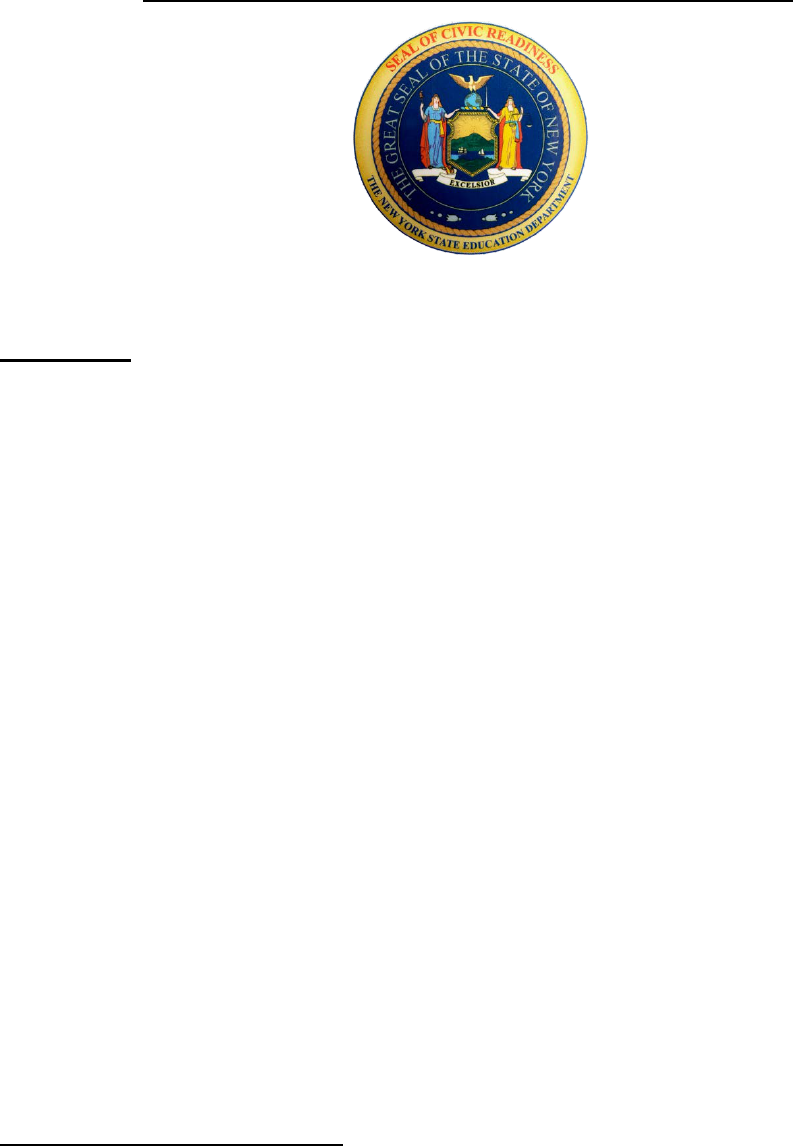
New York State Seal of Civic Readiness Manual 48
Appendix D: Seal of Civic Readiness Optional Reflection Guide
Civic Readiness
Optional Reflection Guide
Introduction
Civic Ready students use civic knowledge, skills, and mindsets to make decisions and take
actions for themselves, their communities, and the public good as members of a culturally
diverse, democratic society. Schools, therefore, should provide students with meaningful
opportunities to develop specific civic knowledge, skills, and mindsets—and to participate in
authentic actions and experiences—that are necessary for them to function as productive civic
participants within their schools, communities, states, our country, and the world.
The New York State Education Department (NYSED) is committed to empowering the civic
agency of students and ensuring all students achieve civic readiness as a result of their
prekindergarten – 12th grade education. The Board of Regents and NYSED have also
emphasized this position in their Every Student Succeeds Act (ESSA) Plan. NYSED understands
that the results we seek for all our children can only be fully achieved by incorporating an equity
and inclusion lens in every facet of our work.
Civic education strengthens the relationships between schools and students, as well as students’
relationships with parents, caregivers and families, civic leaders, community partners, and
among each other. The responsibility of ensuring all students are civic ready is a chief aim of
social studies education.
Additionally, a growing body of research finds that all students benefit when their schools
implement strong Diversity, Equity, and Inclusion (DEI) policies and practices – including
academic, cognitive, civic, social-emotional, and economic benefits. Effective school DEI
policies empower students from all backgrounds to visualize successful futures for themselves
and provide them with a sense of belonging and self-worth. These benefits can lead to improved
student achievement, which in turn can lead to better outcomes in other areas of their lives,
including work and civic engagement.
The Definition of Civic Readiness is organized around four domains:
1. Civic Knowledge
2. Civic Skills and Actions
3. Civic Mindsets
4. Civic Experiences

New York State Seal of Civic Readiness Manual 49
This Refection Document is provided as an optional guide to help schools and districts as they
plan to offer the Seal of Civic Readiness.
Directions for Part 1:
Completing the Reflection
The school’s Civic Readiness coordinator and/or the school’s Seal of Civic Readiness
Committee could review the indicators and consider which of the three categories best captures
the work the school has completed to date and/or needed areas of focus.
Emerging: Demonstrates beginning knowledge and skills with limited use of the defined
practice.
Integrating: Exhibits an understanding and use of knowledge and skills in the practice,
and performance is growing.
Sustaining: Sustains an exemplary level of practice.
Post- Reflection
School teams could use the reflection to identify priorities to pursue throughout the school year.
Part 1
Civic Knowledge- demonstrate a fundamental and functional knowledge of government,
law, history, geography, culture, economics, and current events. These may include
inequities within our democratic system at the federal, state, and local level. Students
should know how to apply this knowledge to different circumstances and settings.
PRACTICES
E
I
S
How this looks in our school
Structure and functioning of government, law,
and democracy at the federal, state, local and
school levels and how to participate
Civil and educational rights and responsibilities
guaranteed by the U.S. Constitution, the
Constitution of the State of NY, and federal,
state, and local statutes and regulations
History, geography, economics, and current
events within our country and in our global
society
Impact of individual and collective histories in
shaping contemporary issues
View and analyze history and current issues from
multiple perspectives
The importance of civic rights and
responsibilities, such as voting, volunteering,
Ensuring a free press

New York State Seal of Civic Readiness Manual 50
Civic Skills and Actions- Demonstrate a broad array of critical analytic, verbal,
communication, media literacy and other skills and participate in a wide variety of
actions. Students should practice such actions both inside and outside of school on a
regular basis.
PRACTICES
E
I
S
How this looks in our school
Demonstrate respect for the rights of others in
discussions and classroom debates and how to
respectfully disagree with other viewpoints and
provide evidence for a counterargument
Participate in activities that focus on a
classroom, school, community, state, or
national issue or problem
Identify, describe, and contrast the roles of the
individual in opportunities for social and political
participation in different societies
Work to influence those in positions of power to
achieve extensions of freedom, social justice, and
human rights
Fulfill social and political responsibilities
associated with participation in a democratic
society and the interdependent global
community by developing awareness of and/or
engaging in the political process
Analyze and evaluate news (news literacy)
media, social media, and other sources of
information for accuracy, bias, reliability, and
credibility
Engagement in working toward the public good
Civic Mindsets- Demonstrate the mindset of a participant in a democratic society. A civic
mindset is a commitment to democratic interpersonal and intrapersonal values, virtues,
attitudes, and beliefs and informed actions that promote and facilitate meaningful
participation in civic life. It is an understanding of self as part of and responsible to
larger social groups.
PRACTICES
E
I
S
How this looks in our school
Valuing equity, inclusivity, diversity, and fairness
Recognizing the need to plan for both current
needs and the good of future generations
Committing to balancing the common good with
individual liberties
Demonstrating a sense of self as an active
participant in society, willing to contribute to
solving local and/or national problems
Respecting fundamental democratic principles,
such as freedom of speech, freedom of the press
and the rule of law
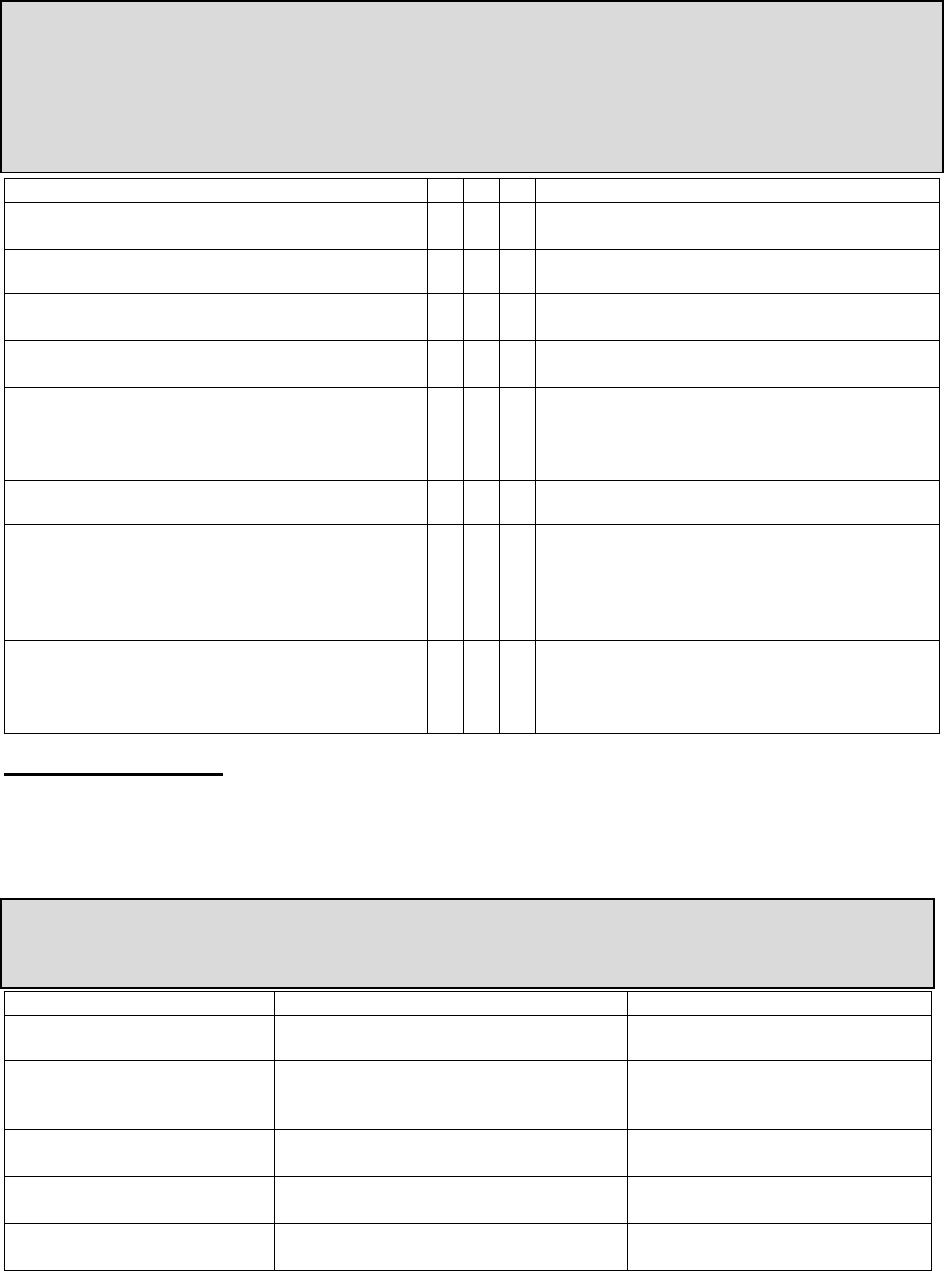
New York State Seal of Civic Readiness Manual 51
Civic Experiences- participate in developmentally appropriate civic experiences. Civic
readiness should be developed in a variety of settings and ways—inside and outside the
classroom, across content areas and for multiple purposes. Civic Readiness should be
promoted by engaging students in relevant experiences that include students as active
participants.
PRACTICES
E
I
S
How this looks in our school
Completing a civic capstone or civic engagement
project
Engaging in service learning
Engaging in civil discourse around controversial
issues
Engaging with news and digital tools, such as
social media, responsibly
Participating in civic centered co-curricular and
extracurricular activities such as Model UN,
Student Government, Debate Club, Student
Journalism, or Mock Trial
Participating in school governance
Voting, volunteering, and participating in
community organizations and governmental
systems, such as community boards, youth
advisory councils etc. to promote continuous
improvement
Engaging with local officials and government
institutions through activities such as providing
public comment before a government agency, or
meeting with public and elected officials.
Directions for Part 2:
Answers to this section could be based on feedback received at the end of the year from teachers
and students, in addition to the committee.
Part 2
The Seal of Civic Readiness
Successes and Challenges
Categories of Feedback
Successes
Challenges
Point Structure of the Seal
Accessibility for all
students including ELL
and Students with Disabilities
Barriers to offering the Seal to
all students
Building a K-8 Civics
program to support the Seal
Building Partnerships with
outside organizations

New York State Seal of Civic Readiness Manual 52
Appendix E: Students Scenarios Earning the Seal of Civic Readiness
The following scenarios show examples of how a student might earn the Diploma Seal of Civic
Readiness. These scenarios are not inclusive of all the possibilities that exist for students to
achieve the Seal, but serve as examples for schools, districts, and administration to better
understand the options available to students. Please note, the highlighted portion of the below
Sample Student Record Sheet shows examples of when and how the student(s) obtained the
points.
Sample Student Record Sheet
Name:
Counselor:
Date:
Students who receive the NYSED Seal of Civic Readiness must earn a total of six points,
with at least two points from column #1 (Criteria for Demonstrating Proficiency in Civic
Knowledge) and at least two points from column #2 (Criteria for Demonstrating Civic
Participation).
Criteria for Demonstrating Proficiency in
Civic Knowledge
Criteria for Demonstrating Civic
Participation
Points
Possible
Points
Earned
Date(s)
Earned
SCRC
Approval
Points
Possible
Points
Earned
Date(s)
Earned
SCRC
Approval
1a. Four (4)
Social Studies
courses
required
for
graduation**
1
2a. Civic
Skills,
Actions, and
Mindsets
Complete a
high school
civic project
1.5*
1b. Social
Studies
Regents Exams
Mastery level
(85+)
Exam Scores:
Global History
&
Geography
Regents
United States
History
Regents ____
1.5*
2b. Civic
Experiences
Area I
Complete a
service-
learning
project
1*
1c. Social
Studies
Regents Exams
Proficiency
Level
(65+)***
Exam Scores:
Global History
&
Geography
Regents
United States
History
Regents ____
1*
2c. Civic
Experiences
Area II
Demonstrate
proficiency in
an elective
course that
promotes
civic
engagement
Course(s):
.50*

New York State Seal of Civic Readiness Manual 53
Points
Possible
Points
Earned
Date(s)
Earned
SCRC
Approval
Points
Possible
Points
Earned
Date(s)
Earned
SCRC
Approval
1d. Advanced
Social Studies
Courses
List courses
here:
.50*
2d. Civic
Experiences
Area III
Participate in
an extra-
curricular
program, or
work-based
learning
experience
.50*
1e. Research
Project
1
2e. Middle
School
Capstone
Project
Year
Completed:
1
2f. High
School
Capstone
Project
Year
Completed:
4
Points
Earned:
Points
Earned:
Total Points Earned:_________
Notes:
*Students may receive these points more than once.
**or the equivalent of these courses, as approved by the local public-school superintendent or his or her designee or by the chief
administrative officer of a registered nonpublic high school
***apply safety net if eligible
Testing accommodations recommended in an individualized education program or section 504 Accommodations Plan must be
provided for all State and districtwide assessments administered to students with disabilities, as consistent with State policy.
Students in schools with an alternate pathway for graduation approved by the Commissioner will be held to those schools'
criteria.
**Please note, while reviewing the Sample Student Record sheets below, the highlighted areas
are either what the student did to earn the point, obtaining the point(s), the date the student
obtained the point(s), and if the Seal of Civic Readiness Committee approved the student earning
the point(s).

New York State Seal of Civic Readiness Manual 54
New York State Diploma Seal of Civic Readiness
Sample Student Record Sheet
Name: Student 1 – Earns Diploma Seal
Students who receive the NYSED Seal of Civic Readiness must earn a total of six points,
with at least two points from column #1 (Criteria for Demonstrating Proficiency in Civic
Knowledge) and at least two points from column #2 (Criteria for Demonstrating Civic
Participation).
Criteria for Demonstrating Proficiency in
Civic Knowledge
Criteria for Demonstrating Civic
Participation
Points
Possible
Points
Earned
Date(s)
Earned
SCRC
Approval
Points
Possible
Points
Earned
Date(s)
Earned
SCRC
Approval
1a. Four (4)
Social Studies
courses
required
for
graduation**
1
1
6/22
Yes 6/22
2a. Civic
Skills,
Actions, and
Mindsets
Complete a
high school
civic project
1.5*
1b. Social
Studies
Regents Exams
Mastery level
(85+)
Exam Scores:
Global History
&
Geography
Regents
United States
History
Regents ____
1.5*
2b. Civic
Experiences
Area I
Complete a
service-
learning
project
Completed
through PIG
class 9/21-
1/22. “Adopt
a
grandparent
at local
nursing
home”;
presented to
PIG class
1/22.
1*
1
1/22
Yes
Presented
1/22
1c. Social
Studies
Regents Exams
Proficiency
Level
(65+)***
Exam Scores:
Global History
&
Geography
Regents: 72
United States
History
Regents: 79 __
1*
2
6/19
6/20
EX
Yes
5/1/22
2c. Civic
Experiences
Area II
Demonstrate
proficiency in
an elective
course that
promotes
civic
engagement
Course(s):
.50*
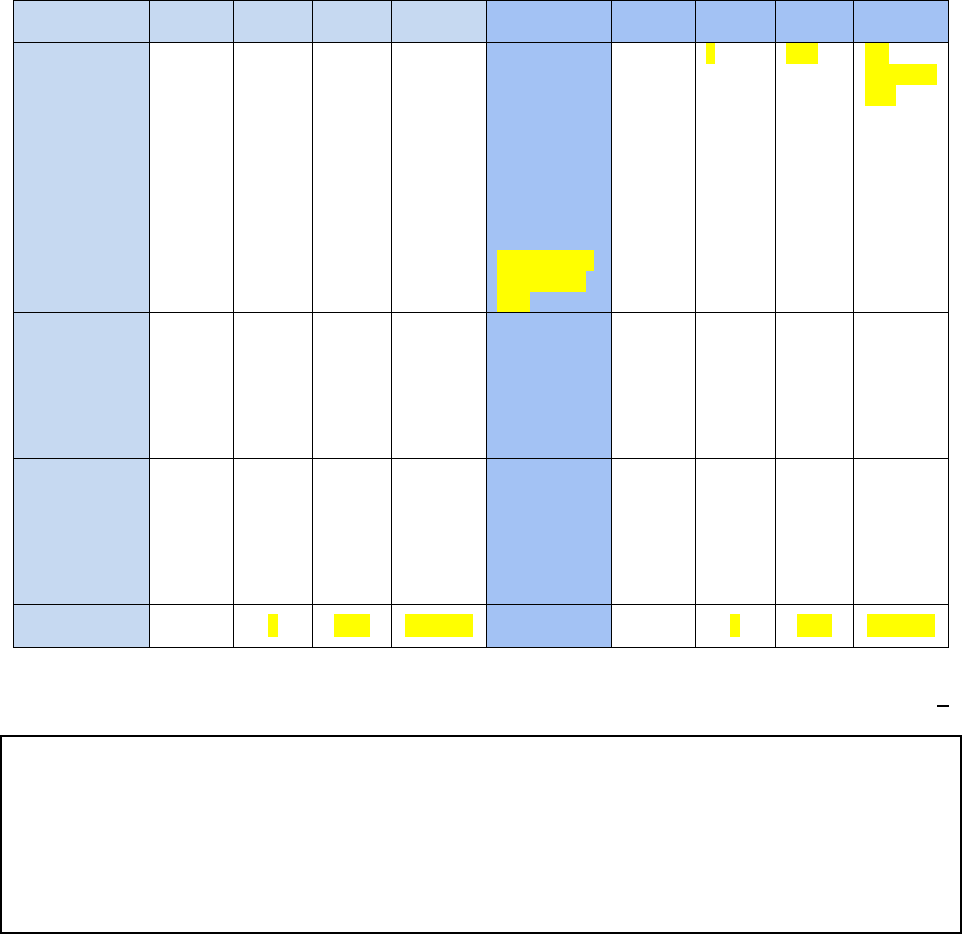
New York State Seal of Civic Readiness Manual 55
Points
Possible
Points
Earned
Date(s)
Earned
SCRC
Approval
Points
Possible
Points
Earned
Date(s)
Earned
SCRC
Approval
1d. Advanced
Social Studies
Courses
List courses
here:
.50*
2d. Civic
Experiences
Area III
Participate in
an extra-
curricular
program, or
work-based
learning
experience
Member, Key
Club grades
9-12
.50*
2
6/22
Yes
Presented
6/22
1e. Research
Project
1
2e. Middle
School
Capstone
Project
Year
Completed:
1
2f. High
School
Capstone
Project
Year
Completed:
4
Points
Earned:
3 6/22 Yes 6/22
Points
Earned:
3 6/22 Yes 6/22
Total Points Earned: 6
Notes:
*Students may receive these points more than once.
**or the equivalent of these courses, as approved by the local public-school superintendent or his or her designee or by the chief
administrative officer of a registered nonpublic high school
***apply safety net if eligible
Testing accommodations recommended in an individualized education program or section 504 Accommodations Plan must be
provided for all State and districtwide assessments administered to students with disabilities, as consistent with State policy.
Students in schools with an alternate pathway for graduation approved by the Commissioner will be held to those schools'
criteria.
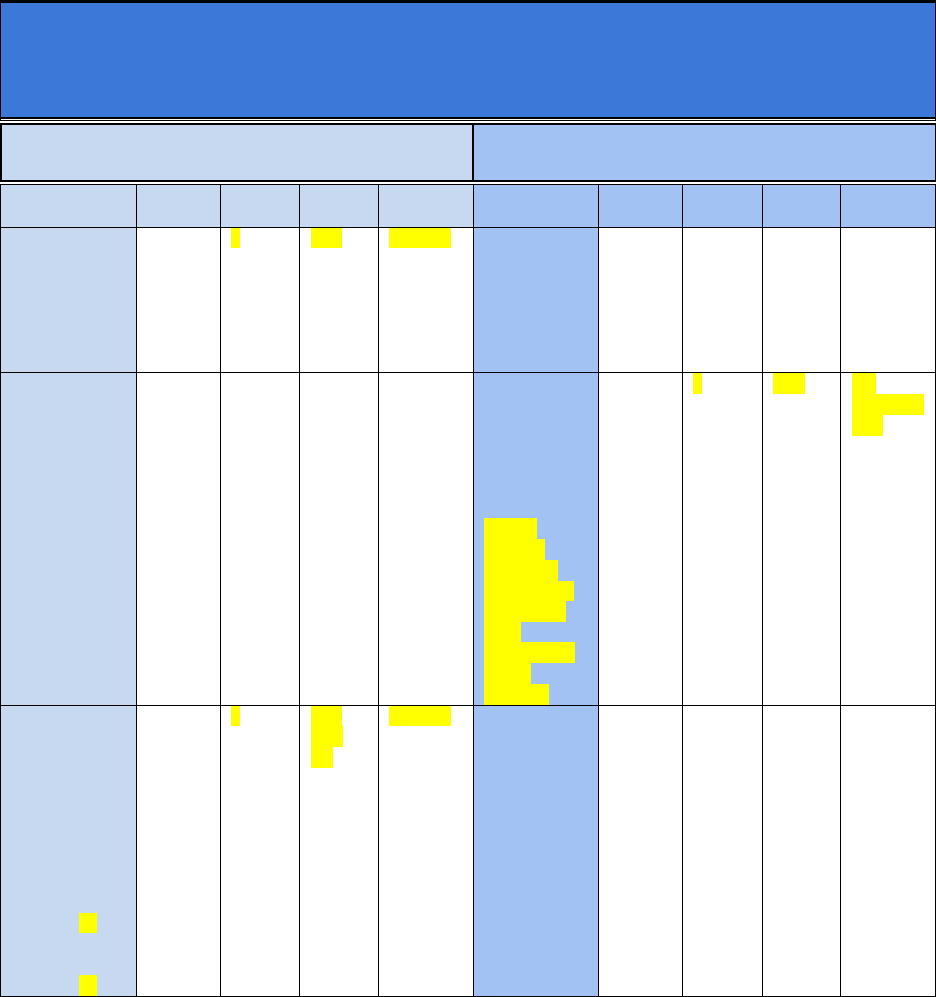
New York State Seal of Civic Readiness Manual 56
New York State Diploma Seal of Civic Readiness
Sample Student Record Sheet
Name: Student 2 – Earns Diploma Seal
Students who receive the NYSED Seal of Civic Readiness must earn a total of six points,
with at least two points from column #1 (Criteria for Demonstrating Proficiency in Civic
Knowledge) and at least two points from column #2 (Criteria for Demonstrating Civic
Participation).
Criteria for Demonstrating Proficiency in
Civic Knowledge
Criteria for Demonstrating Civic
Participation
Points
Possible
Points
Earned
Date(s)
Earned
SCRC
Approval
Points
Possible
Points
Earned
Date(s)
Earned
SCRC
Approval
1a. Four (4)
Social Studies
courses
required
for
graduation**
1
1
6/22
Yes 6/22
2a. Civic
Skills,
Actions, and
Mindsets
Complete a
high school
civic project
1.5*
1b. Social
Studies
Regents Exams
Mastery level
(85+)
Exam Scores:
Global History
&
Geography
Regents
United States
History
Regents ____
1.5*
2b. Civic
Experiences
Area I
Complete a
service-
learning
project
Service
learning
completed
through Key
Club, 9/21-
5/22.
Presented at
Senior
Banquet.
1*
1
5/22
Yes
Presented
5/22
1c. Social
Studies
Regents Exams
Proficiency
Level
(65+)***
Exam Scores:
Global History
&
Geography
Regents: 45***
United States
History
Regents: 65 __
1*
2
6/19
6/20
EX
Yes 5/22
2c. Civic
Experiences
Area II
Demonstrate
proficiency in
an elective
course that
promotes
civic
engagement
Course(s):
.50*
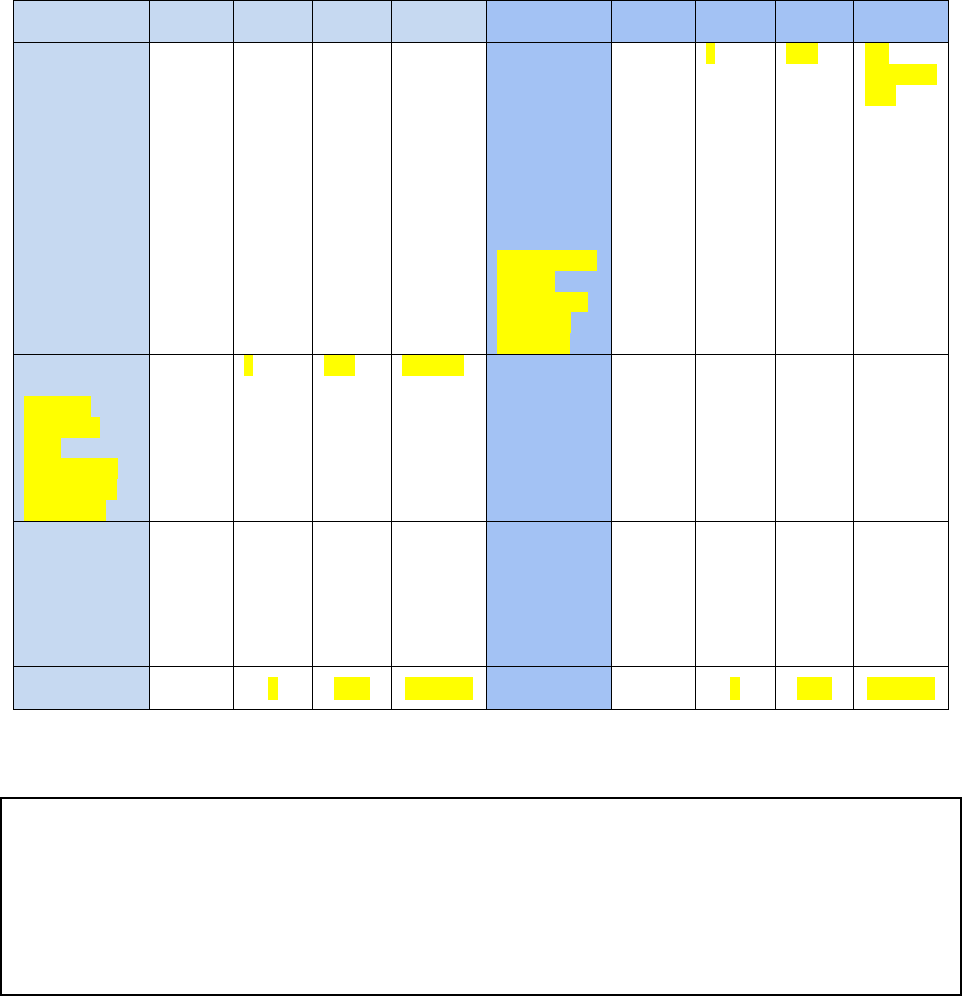
New York State Seal of Civic Readiness Manual 57
Points
Possible
Points
Earned
Date(s)
Earned
SCRC
Approval
Points
Possible
Points
Earned
Date(s)
Earned
SCRC
Approval
1d. Advanced
Social Studies
Courses
List courses
here:
.50*
2d. Civic
Experiences
Area III
Participate in
an extra-
curricular
program, or
work-based
learning
experience
Member, Best
Buddies
grades 9-11.
President,
Grade 12.
.50*
1
6/22
Yes
Presented
6/22
1e. Research
Project
Research
Project on
voter
participation
completed in
English 12.
1
1
1/21
Yes 1/21
2e. Middle
School
Capstone
Project
Year
Completed:
1
2f. High
School
Capstone
Project
Year
Completed:
4
Points
Earned:
4 6/22 Yes 6/22
Points
Earned:
3 6/22 Yes 6/22
Total Points Earned: 7
Notes:
*Students may receive these points more than once.
**or the equivalent of these courses, as approved by the local public-school superintendent or his or her designee or by the chief
administrative officer of a registered nonpublic high school
***apply safety net if eligible
Testing accommodations recommended in an individualized education program or section 504 Accommodations Plan must be
provided for all State and districtwide assessments administered to students with disabilities, as consistent with State policy.
Students in schools with an alternate pathway for graduation approved by the Commissioner will be held to those schools'
criteria4.
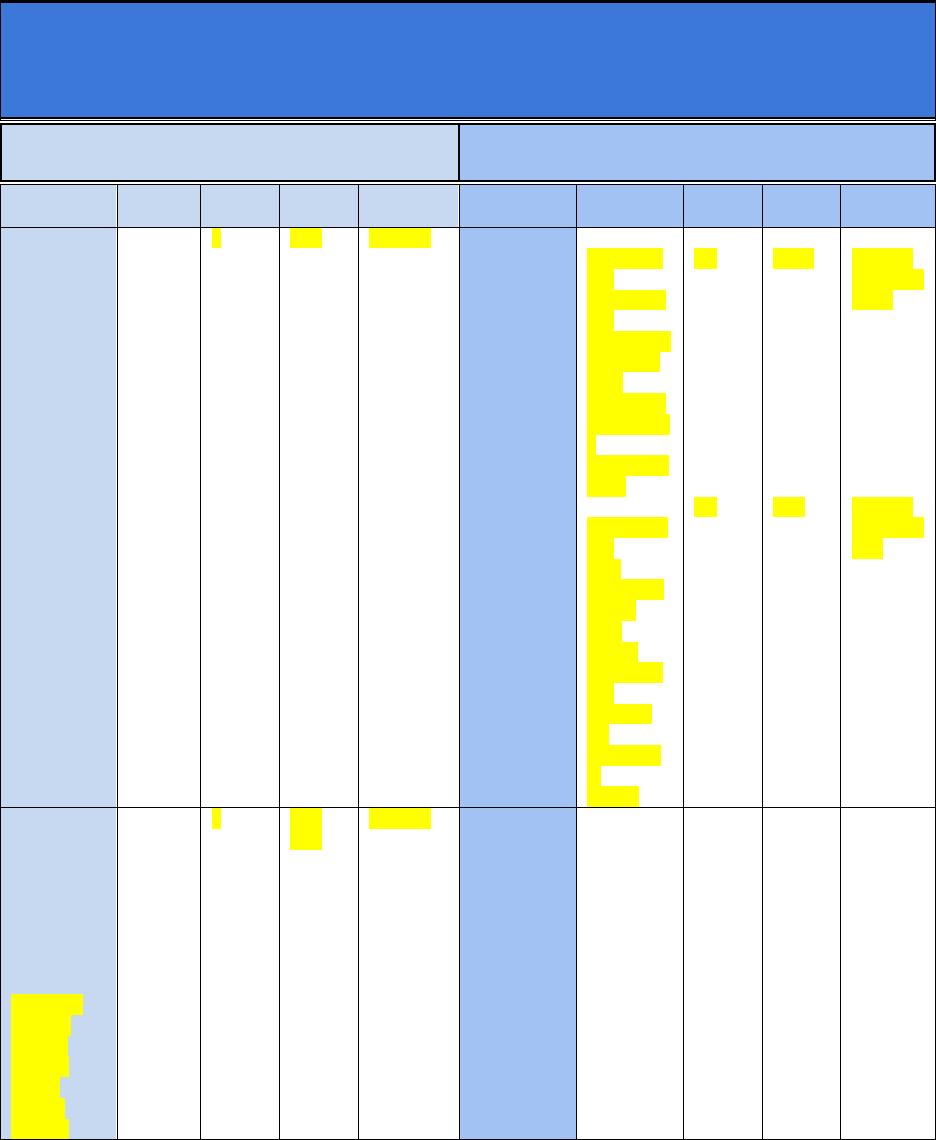
New York State Seal of Civic Readiness Manual 58
New York State Diploma Seal of Civic Readiness
Sample Student Record Sheet
Name: Student 3 – Earns Diploma Seal
Students who receive the NYSED Seal of Civic Readiness must earn a total of six points,
with at least two points from column #1 (Criteria for Demonstrating Proficiency in Civic
Knowledge) and at least two points from column #2 (Criteria for Demonstrating Civic
Participation).
Criteria for Demonstrating Proficiency in
Civic Knowledge
Criteria for Demonstrating Civic
Participation
Points
Possible
Points
Earned
Date(s)
Earned
SCRC
Approval
Points
Possible
Points
Earned
Date(s)
Earned
SCRC
Approval
1a. Four (4)
Social
Studies
courses
required
for
graduation*
*
1
1
6/22
Yes 6/22
2a. Civic
Skills,
Actions, and
Mindsets
Complete a
high school
civic project
1.5*
Organized
and
participate
d in
virtual food
drive with
local
community
organizatio
n
with soccer
team.
Participate
d in
civic
project led
by Key
Club
raising
awareness
and
funds for
the
local Wall
of
Heroes
1.5
1.5
12/21
5/22
Yes 6/22
Presented
12/21
Yes 6/22
Presented
5/22
1b. Social
Studies
Regents
Exams
Mastery
level
(85+)
Exam
Scores:
AP World
History:
Modern
exam: 5
AP US
History
exam: 5
1.5*
3
6/19
6/20
Yes 5/22
2b. Civic
Experiences
Area I
Complete a
service-
learning
project
1*
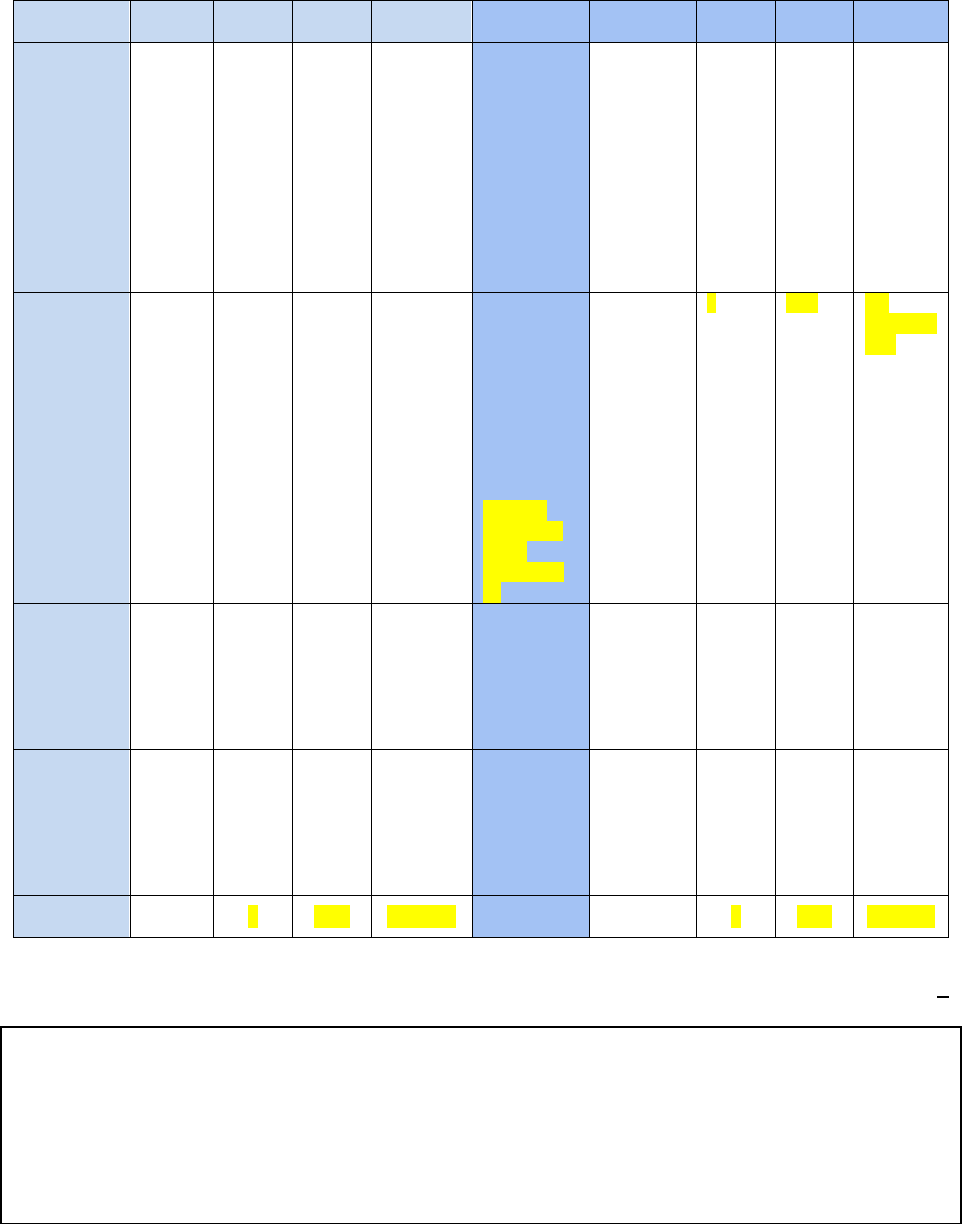
New York State Seal of Civic Readiness Manual 59
Points
Possible
Points
Earned
Date(s)
Earned
SCRC
Approval
Points
Possible
Points
Earned
Date(s)
Earned
SCRC
Approval
1c. Social
Studies
Regents
Exams
Proficiency
Level
(65+)***
Exam
Scores:
1*
2c. Civic
Experiences
Area II
Demonstrate
proficiency
in
an elective
course that
promotes
civic
engagement
Course(s):
.50*
1d.
Advanced
Social
Studies
Courses
List courses
here:
.50*
2d. Civic
Experiences
Area III
Participate
in an extra-
curricular
program, or
work-based
learning
experience
Member,
Mock Trial
Team,
Grades 11-
12
.50*
1
6/22
Yes
Presented
6/22
1e. Research
Project
1
2e. Middle
School
Capstone
Project
Year
Completed:
1
2f. High
School
Capstone
Project
Year
Completed:
4
Points
Earned:
4 6/22 Yes 6/22
Points
Earned:
4 6/22 Yes 6/22
Total Points Earned: 8
Notes:
*Students may receive these points more than once.
**or the equivalent of these courses, as approved by the local public-school superintendent or his or her designee or by the chief
administrative officer of a registered nonpublic high school
***apply safety net if eligible
Testing accommodations recommended in an individualized education program or section 504 Accommodations Plan must be
provided for all State and districtwide assessments administered to students with disabilities, as consistent with State policy.
Students in schools with an alternate pathway for graduation approved by the Commissioner will be held to those schools'
criteria.
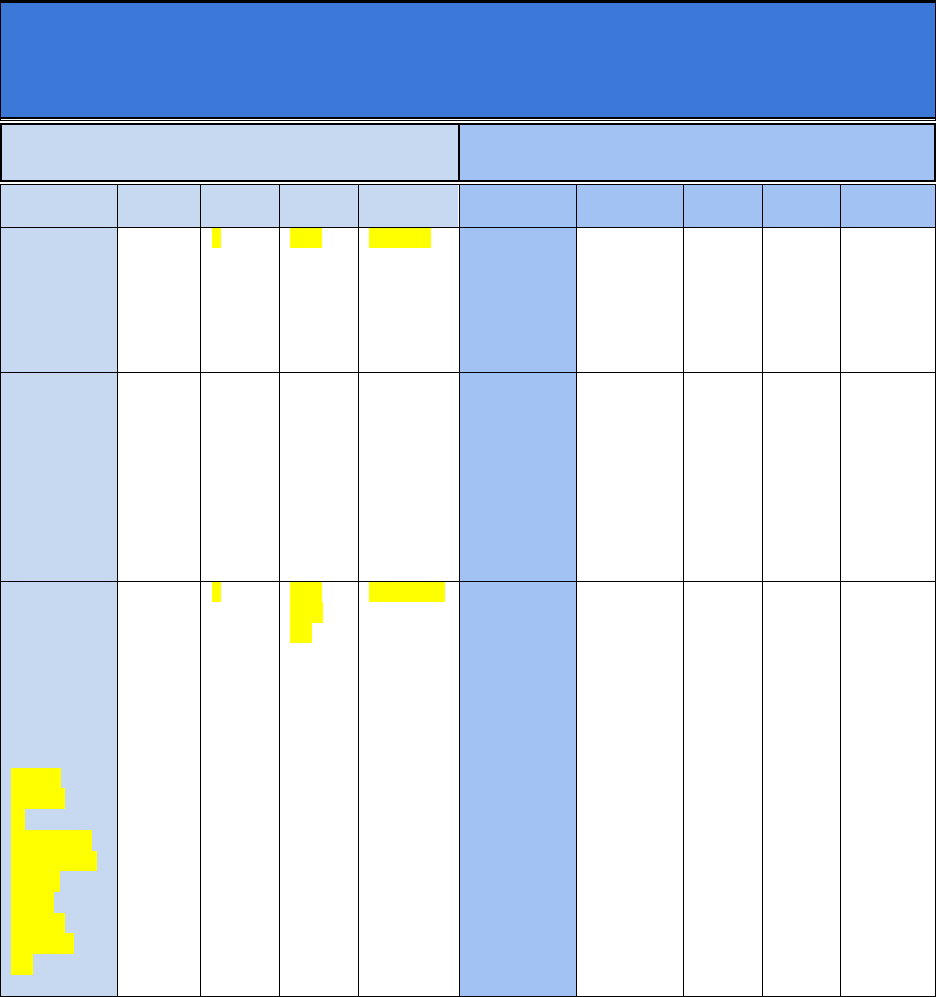
New York State Seal of Civic Readiness Manual 60
New York State Diploma Seal of Civic Readiness
Sample Student Record Sheet
Name: Student 4 – Does Not Earn Diploma Seal
Students who receive the NYSED Seal of Civic Readiness must earn a total of six points,
with at least two points from column #1 (Criteria for Demonstrating Proficiency in Civic
Knowledge) and at least two points from column #2 (Criteria for Demonstrating Civic
Participation).
Criteria for Demonstrating Proficiency in
Civic Knowledge
Criteria for Demonstrating Civic
Participation
Points
Possible
Points
Earned
Date(s)
Earned
SCRC
Approval
Points
Possible
Points
Earned
Date(s)
Earned
SCRC
Approval
1a. Four (4)
Social
Studies
courses
required
for
graduation**
1
1
6/22
Yes 6/22
2a. Civic
Skills,
Actions, and
Mindsets
Complete a
high school
civic project
1.5*
1b. Social
Studies
Regents
Exams
Mastery
level
(85+)
Exam
Scores:
1.5*
2b. Civic
Experiences
Area I
Complete a
service-
learning
project
1*
1c. Social
Studies
Regents
Exams
Proficiency
Level
(65+)***
Exam
Scores:
Global
History
&
Geography
Regents: 75
United
States
History
Regents:
EX
1*
2
6/19
6/20
EX
Yes 5/1/22
2c. Civic
Experiences
Area II
Demonstrate
proficiency
in
an elective
course that
promotes
civic
engagement
Course(s):
.50*
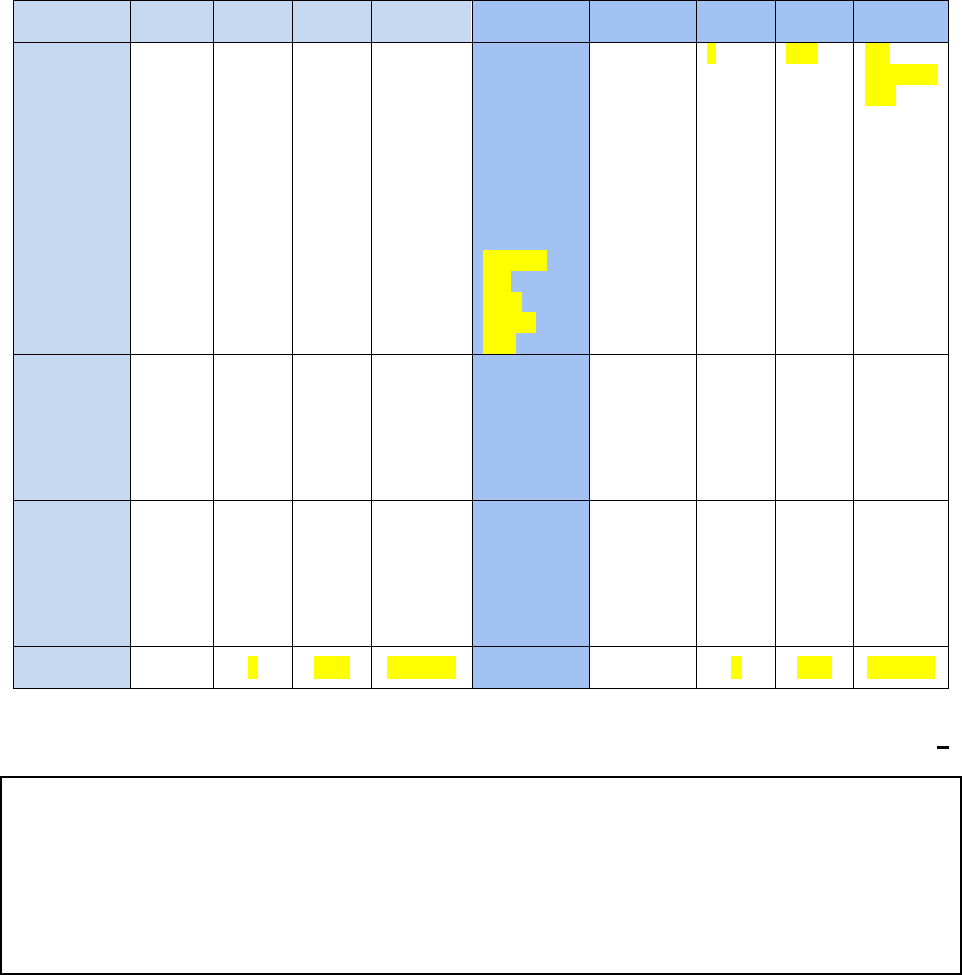
New York State Seal of Civic Readiness Manual 61
Points
Possible
Points
Earned
Date(s)
Earned
SCRC
Approval
Points
Possible
Points
Earned
Date(s)
Earned
SCRC
Approval
1d.
Advanced
Social
Studies
Courses
List courses
here:
.50*
2d. Civic
Experiences
Area III
Participate
in an extra-
curricular
program, or
work-based
learning
experience
Member,
Key
Club,
Grades
9-12
.50*
1
6/22
Yes
Presented
6/22
1e. Research
Project
1
2e. Middle
School
Capstone
Project
Year
Completed:
1
2f. High
School
Capstone
Project
Year
Completed:
4
Points
Earned:
3 6/22 Yes 6/22
Points
Earned:
1 6/22 Yes 6/22
Total Points Earned: 4
Notes:
*Students may receive these points more than once.
**or the equivalent of these courses, as approved by the local public-school superintendent or his or her designee or by the chief
administrative officer of a registered nonpublic high school
***apply safety net if eligible
Testing accommodations recommended in an individualized education program or section 504 Accommodations Plan must be
provided for all State and districtwide assessments administered to students with disabilities, as consistent with State policy.
Students in schools with an alternate pathway for graduation approved by the Commissioner will be held to those schools'
criteria.

New York State Seal of Civic Readiness Manual 62
Appendix F: Sample Rubric for the Research Project
The Civics Knowledge Research Paper rubric below reflects the basic criteria for assessing
student learning in the project. You will need to modify it so that it reflects the specific research
task provided to your students, including adding additional sections where needed. Research
projects will be approved and evaluated by a process established by the local Seal of Civic
Readiness Committee (SCRC). Research projects should earn holistic scores of Proficient or
Advanced to receive credit towards the Seal of Civic Readiness. Students may revise and
improve their research papers to meet the criteria for proficient and/or advanced.
Research
Project Rubric
Advanced Proficient Developing Beginning
Presentation of
Topic Under
Investigation
Research topic is
aligned with the
domain of civic
knowledge.
Author presents a
compelling thesis that
states the argument,
question, or topic
under examination.
Thesis answers the
prompt (as provided
or developed by the
student). The
thesis/question/topic
is a consistent focal
point throughout the
paper.
Research topic is
aligned with the
domain of civic
knowledge.
Presents a persuasive
thesis that states the
argument, question,
or topic under
examination. Thesis
answers the prompt.
Research topic is
aligned with the
domain of civic
knowledge.
Presents a clear thesis
that states the
argument, question,
or topic under
examination. Thesis
is related to the
prompt.
Research topic is not
aligned with the
domain of civic
knowledge.
Presents a thesis that
does not answer the
prompt.
Argumentation
(Where Applicable)
Constructs a
plausible and
compelling argument
by integrating
relevant evidence
from sources.
Introduces accurate,
credible, and precise
claims, distinguishing
the claims from
alternate or opposing
claims.
Identifies the
strengths and
limitations of both
claims and counter-
claims, refuting the
counterargument.
Constructs a
plausible and
persuasive argument
using relevant
evidence from
sources.
Introduces credible
and accurate claims
of an event or issue,
acknowledging and
distinguishing the
claims from at least
one counterclaim.
Presents a plausible
claim or argument
using relevant
evidence from
sources.
Introduces credible
claims about a topic.
May include minor
inaccuracies.
Student makes an
implausible claim
or argument using
irrelevant and/or
disconnected
evidence from
sources.
Introduces claims
about a topic or
issue with
inaccuracies.

New York State Seal of Civic Readiness Manual 63
Research
Project Rubric
Advanced Proficient Developing Beginning
Gathering,
Using,
Interpreting
Sources
Integrates relevant,
compelling, credible,
and varied evidence
to analyze historical,
current, and civic
issues in support of
the topic or
argument.
Cites complete and
accurate source
information for each
piece of evidence.
Integrates useful,
credible, and
varied evidence to
analyze historical,
current, and civic
issues in support
of the topic or
argument.
Cites accurate
source
information for
each piece of
evidence.
Uses some useful and
credible evidence to
analyze historical,
current, and civic
issues in support of the
topic or argument;
some sources may not
be relevant or may
refute even refute the
argument.
Source information is
cited for some
evidence. Minor
inaccuracies may exist.
Evidence selected is
not useful or credible
and does not support
the topic or argument.
Limited evidence is
cited. Major
inaccuracies exist.
Historical
Background
Demonstrates
thorough
understanding of the
issue/topic by
providing many rich,
varied, and relevant
facts, examples, and
details. Examples
provide historically
accurate context and
background.
Demonstrates
comprehension of
the issue/topic by
providing many
historically accurate
and relevant facts,
examples, and
details.
Demonstrates fair
comprehension of the
issue/topic using
relevant facts,
examples, and details.
May include some
minor inaccuracies,
misunderstandings, or
misapplications.
Demonstrates poor
comprehension of
the issue/topic with
few historically
accurate or relevant
facts, examples, or
details.
Includes
inaccuracies,
misunderstandings,
or misapplications.
Organization,
Cohesion &
Conventions
Demonstrates a
logical and clear plan
of organization that
supports the student’s
topic or argument;
includes an
introduction and a
conclusion that
support the argument
presented.
Maintains a fluent,
cohesive style and
appropriate tone in
attendance to the
domains of civic
knowledge and skills.
Relationships in the
text are strengthened
and clarified using
accurate words,
phrases, and varied
syntax. Little to no
grammatical errors
are present.
Demonstrates a
logical and clear
plan of organization
that supports the
student’s topic or
argument; includes
an introduction and
a conclusion that
support the
argument presented.
Maintains fluency,
cohesion, and
appropriate tone in
attendance to the
domains of civic
knowledge and
skills.
Relationships in the
text are clarified
using accurate
words and phrases.
Few grammatical
errors are present.
Demonstrates a
general plan of
organization; may lack
focus; it may not be
clear which aspect of
the research project is
being addressed. May
lack an introduction
and/or conclusion.
Fluency, cohesion, and
appropriate tone is
uneven. Attendance to
the domains of civic
knowledge and skills,
is uneven or
unbalanced.
Relationships in the
text/aspects of the task
are unclear at times.
Use of accurate words
and phrases is uneven.
Grammatical errors
are present.
Demonstrates a
weakness in
organization; lacks
focus; aspects may be
omitted or are
disconnected from the
topic or argument;
lacks an introduction
and/or a conclusion.
Lacks fluency,
cohesion, and
appropriate tone to
the task.
Relationships in the
text/aspects of the
task are unclear or
omitted. Use of
accurate words and
phrases is uneven or
inappropriate for the
issue under
investigation.
Grammatical errors
are present.

New York State Seal of Civic Readiness Manual 64
Appendix G: Sample Rubric for the High School Civics Project
The 2a Civic Project rubric below reflects the basic criteria for assessing student learning in the
project. You will need to modify it so that it reflects the specific task investigated by students,
including adding additional sections where needed. Civic projects should earn holistic scores of
proficient or advanced to receive credit towards the Seal of Civic Readiness. Students may revise
and improve their Civic Projects to meet the criteria for proficient and/or advanced.
Civics Project Rubric
Advanced
Proficient
Developing
Beginning
Identification and
Definition of the Issue
Under Investigation
Focus on a civic issue or
problem within a policy area
that may be predetermined by
the teacher or advisor. The
Civic Project is focused on a
civic issue or problem that can
be interpreted in a variety of
ways by a broad array of
citizens holding various
viewpoints.
Civic
issue/problem
under investigation
is identified clearly
and effectively
explained in depth.
Presents a precise
and knowledgeable
central claim
(thesis) that
convincingly
answers the
question or issue
under investigation.
Civic issue/problem
under investigation
identified and
described clearly.
Understanding by
the reader is not
seriously impeded
by omissions.
Presents a
knowledgeable
central claim
(thesis) that
answers the
question or issue
under investigation.
Civic
issue/problem
under investigation
identified but
description may be
ambiguous. The
boundaries of the
issue may be broad
or unclear. Minor
inaccuracies may
be present.
Civic
issue/problem
under
investigation is
vaguely or
partially
identified
without
clarification or
description.
Thesis and
position are
unclear.
Analysis and Use of
Sources
Analyze data and
primary, and secondary
sources of evidence
related to the civic
issue under
investigation and its
impact on communities.
Sources should be evaluated
for bias and credibility.
Sources can be provided by
the teacher, advisor, or
student.
Student constructs a
strong, coherent
claim or argument
by integrating
relevant, varied,
credible, compelling
evidence from
sources.
Integrates relevant
and compelling
evidence to analyze
the historical
background of the
issue and its impact
in our current
society.
Cites complete and
accurate source
information for each
piece of evidence.
Student constructs
a coherent claim or
argument using
relevant, varied,
credible evidence
from sources.
Integrated useful
and relevant
evidence to
analyze the
historical
background of the
issue and its
impact in our
current society.
Cites accurate
source information
for each piece of
evidence.
Student presents
a claim or
argument using
evidence from
credible sources.
Uses some
relevant evidence
to analyze the
historical
background of
the issue and its
impact in our
current society.
Some evidence
may not be useful
or relevant, may
be uneven or may
even refute the
argument.
Source
information is
cited for some
evidence. Minor
inaccuracies
exist.
Student makes
an implausible
claim or
argument using
irrelevant and/or
disconnected
evidence from
sources. Sources
may lack
credibility.
Evidence
selected is not
useful and does
not support the
argument.
Limited
evidence is
cited. Major
inaccuracies
exist.

New York State Seal of Civic Readiness Manual 65
Civics Project Rubric
Advanced
Proficient
Developing
Beginning
Analysis and Evaluation
of Current Policies
Evaluate at least 2 current
public policies related to the
issue or problem under
investigation. Policies may
be local, state, national or
international.
Policies under
investigation are
described and
analyzed clearly
and
comprehensively.
Thoroughly
evaluates the
impact, strengths,
and limitations of
current policies on
communities.
Policies under
investigation are
described and
analyzed clearly
(may include more
description versus
analysis).
Evaluates the
impact, strengths,
and limitations of
current policies on
communities.
Policies under
investigation are
identified and
minimally
described. May
include minor
inaccuracies.
Attempts to
evaluate the policy
may be present, but
may be unclear,
vague, unbalanced,
or one- sided.
Policies under
investigation are
identified with no
description or are
not identified.
Information
may be
inaccurate.
Evaluation of
policies is missing
or unclear.
Justification of
Potential Alternatives,
Strategies/ Courses of
Action
Recommend and evaluate
potential
strategies/courses of action
to address the issue or
problem that is under
investigation.
Plan of
action/alternatives
to current policy,
recommended
strategies and
arguments are
presented, and
described and
justified
thoroughly.
Recommendations
and arguments are
clearly connected
to the student’s
evaluation of
current policies.
Plan of
action/alternatives
to current policy/
recommended
strategies and
arguments are
presented and
described and
justified.
Recommendations
and arguments are
connected to the
student’s
evaluation of
current policies.
Plan of
action/alternatives
to current policy/
recommended
strategies and
arguments are
presented but may
lack adequate
description or
justification.
Recommendations
and arguments may
be somewhat
disconnected to the
student’s evaluation
of current policies.
Plan of
action/alternatives
to current policy/
recommended
strategies and
arguments may be
omitted or are
presented but lack
description and
coherence.
Recommendations
are disconnected
from the student’s
evaluation or are
inconsistent with
the issue under
investigation.
Reflection
Explains how the project
influenced their civic
knowledge, skills, mindsets
and, where appropriate,
actions.
Includes a thorough
self-reflection on
how their project
impacted their civic
knowledge, skills,
mindsets and, if
appropriate, actions.
Reflections are
connected to the
issue under
investigation.
Includes a self-
reflection on how
their project
influenced their
civic knowledge,
skills, mindsets
and, if appropriate,
actions.
Reflections are
connected to the
issue under
investigation, but
may be somewhat
uneven, favoring
one aspect over
another.
Includes a self-
reflection on how
their project
influenced their
civic knowledge,
skills, mindsets
and, if appropriate,
actions.
Reflections may be
minimal, omit one
or more of the
domains or may be
somewhat
disconnected from
the issue under
investigation.
Project does not
include a self-
reflection.

New York State Seal of Civic Readiness Manual 66
Civics Project Rubric
Advanced
Proficient
Developing
Beginning
Organization,
Cohesion &
Conventions
Projects are organized
and communicated in a
manner that enhances the
argument and the
audience’s understanding.
Demonstrates a
logical and clear
plan of organization
that supports the
student’s argument;
includes an
introduction and a
conclusion that
support the
argument presented.
Maintains a fluent,
cohesive style and
appropriate tone in
attendance to the
domains of civic
knowledge and
skills.
Relationships in the
text are
strengthened and
clarified using
accurate words,
phrases, and varied
syntax. Little to no
grammatical errors
are present.
Demonstrates a
logical and clear
plan of organization
that supports the
student’s argument;
includes an
introduction and a
conclusion that
support the
argument
presented.
Maintains fluency,
cohesion, and
appropriate tone in
attendance to the
domains of civic
knowledge and
skills.
Relationships in the
text are clarified
using accurate
words and phrases.
Few grammatical
errors are present.
Demonstrates a
general plan of
organization; may
lack focus; it may
not be clear which
aspect of the
project is being
addressed. May
lack an
introduction and/or
conclusion.
Fluency, cohesion,
and appropriate
tone is uneven.
Attendance to the
domains of civic
knowledge and
skills, is uneven or
unbalanced.
Relationships in the
text/aspects of the
task are unclear at
times.
Use of accurate
words and phrases
is uneven.
Grammatical errors
are present.
Demonstrates a
weakness in
organization;
lacks focus;
aspects may be
omitted or are
disconnected
from the issue
under
investigation;
lacks an
introduction
and/or a
conclusion.
Lacks fluency,
cohesion, and
appropriate tone
to the task.
Relationships in
the text/aspects
of the task are
unclear or
omitted. Use of
accurate words
and phrases is
uneven or
inappropriate for
the issue under
investigation.
Grammatical
errors are
present.
Presentation
Communicate their project
using written, audio/visual,
and/or oral presentations.
Communicates
civic project in an
SCR committee-
approved format.
Format chosen
enhances the
communication of
the project.
Communicates
civic project in an
SCR committee-
approved format.
Format chosen is
appropriate for the
communication of
the project.
Communicates
civic project in an
SCR committee-
approved format.
Format chosen is
for the
communication of
the project and vice
versa.
Communicates
civic project in a
format that is not
approved by the
SCR committee.
Project is not
submitted or is
unfinished. Format
chosen degrades
the quality and
communication of
the project.
Adapted from: Performance Level Descriptors, United State History and Government (Framework); NYS Next Generation
Writing Standards for Literacy in History/Social Studies, Science and Other Technical Subjects, 11-12
Resources:
How to Write an Op-Ed or Column from the Harvard Kennedy School of Government. Accessed at:
https://projects.iq.harvard.edu/files/hks-communications- program/files/new_seglin_how_to_write_an_oped_1_25_17_7.pdf
A Political Science Guide: What is a Policy Paper? (2017). Accessed at: https://politicalscienceguide.com/home/policy-paper/

New York State Seal of Civic Readiness Manual 67
Appendix H: Service-Learning Project Reflection Evaluation Example
Student Name:
Service-Learning Project:
Element
Meets
Requirements?
Reviewer’s
Comments
Background
information
& Civic
Knowledge
Reflection includes a description of the service-
learning experience, including the challenges
faced by the student and the successes of the
project.
Demonstrates understanding of the community
problem and its connection to
local/state/national government.
The reflection essay/presentation/product
includes artifacts (i.e., photographs, video
recordings, newspaper articles) that document
your service-learning experience.
Yes No
Hours
Requirement
Completed 25 hours of service.
Yes No
Civic Skills
and Actions
Demonstrates understanding of the
opportunities for individual participation in
society.
Demonstrates engagement in working toward
the public good.
Yes No
Civic
Mindset
Demonstrates empathy, compassion, and respect
for the views of people with other opinions and
perspectives.
Demonstrates the sense of self as an active
participant in society, willing to contribute to
solving local problems.
Yes No
Reviewer’s Recommendation for Points earned: ___________

New York State Seal of Civic Readiness Manual 68
Appendix I: Service-Learning Project Reflection - Evaluation Rubric
Student Name:
Service-Learning Project:
Element Mastery Proficient Developing Beginning
Civic
Knowledge
• Demonstrates
understanding of the
community problem
and its connection to
local/state/national
government.
• Community need and
its relevance are
clearly identified and
focused upon
throughout the project
• Recognized need
identified through
research or a needs
assessment (methods
could include asset
mapping, surveying,
interviewing)
• Reflection includes a
description of the
service- learning
experience
• Demonstrates
understanding of the
community problem
and its connection to
local/state/national
government.
• Community need
and its relevance are
identified at the
beginning of the
project
• Recognized need
identified through
research (methods
could include asset
mapping or
surveying)
• Reflection includes
a description of the
service-learning
experience
• Limited
understanding of
the community
problem
• Need identified
but its relevance
to community is
not explored in
depth
• Reflection
includes a
description of
the service-
learning
experience
• No need identified
• Incomplete
description of the
service- learning
experience
Reflection
• Reflection completed
throughout the project
addresses need,
project impact, and
personal and academic
growth. Reflection
addresses challenges
faced and successes of
the project
• Reflection includes
multiple artifacts (i.e.,
photographs, video
recordings) that
document the
experience
• Reflection
completed
periodically (i.e., pre
and post) addresses
need, impact
• Reflection addresses
challenges or
successes
• Reflection includes
some artifacts (i.e.,
photographs, video
recordings) that
document the
experience
• Post-project
reflection
completed
• Reflection
addresses
challenges
• Reflection
includes one
artifact that
documents the
experience
• No reflection
evident
Hours
Requirement
• Met NYSED
requirement by
completing 25 hours
of service
• Met NYSED
requirement by
completing 25 hours
of service
• Did not meet
NYSED
requirements
by completing
less than 25
hours of service
• Did not meet
NYSED
requirements by
completing less
than 25 hours of
service

New York State Seal of Civic Readiness Manual 69
Element Mastery Proficient Developing Beginning
Civic Skills
and Actions
• Demonstrates
understanding of
the opportunities
for individual
participation in
society
• Demonstrates
engagement in
working toward the
public good
• Demonstrates
exemplary
communication and
collaboration skills
• Demonstrates
understanding of
the opportunities
for individual
participation in
society
• Demonstrates
engagement in
working toward
the public good
• Demonstrates
communication
and
collaboration
skills
• Describes limited
understanding of
the opportunities
for individual
participation in
society
• Describes limited
engagement in
working toward
the public good
• Demonstrates
limited
communication
and collaboration
skills
• Describes limited
understanding of
the opportunities
for individual
participation in
society
• Describes limited
engagement in
working toward
the public good
• Demonstrates
limited
communication
and collaboration
skills
Civic
Mindset
• Demonstrates
empathy,
compassion, and
respect for the
views of people
with other opinions
and perspectives
• Demonstrates the
sense of self as an
active participant in
society, willing to
contribute to
solving local
problems.
• Demonstrates
empathy,
compassion, and
respect for the
views of people
with other opinions
and perspectives
• Demonstrates the
sense of self as an
active participant
in society, willing
to contribute to
solving local
problems.
• Describes
empathy or
compassion for
the views of
people with other
opinions and
perspectives
• Describes empathy
or compassion for
the views of
people with other
opinions and
perspectives
Essay/
Presentation
• Consistently
establishes and
maintains a formal
style and
appropriate tone
while attending to
the norms and
conventions of
purpose, and
audience for the
essay/presentation
• Consistently makes
strategic use of
digital media and/or
visual displays in
essay/presentation
to enhance
understanding of
findings, reasoning,
and evidence, and
to add elements of
interest to engage
the audience
• Establishes a
formal style and
appropriate tone
while attending to
the norms and
conventions of
purpose, and
audience for the
essay/presentation
• Makes strategic use
of digital media
and/or visual
displays in
presentations to
enhance
understanding of
findings, reasoning,
and evidence, and
to add elements of
interest to engage
the audience
• Has difficulty
establishing or
maintaining a
formal style and
appropriate tone
while attending to
the norms and
conventions of
purpose, and
audience for the
essay/presentation
• Digital media
and/or visual
displays are
included in the
essay/presentation
but they may not
enhance
understanding of
findings,
reasoning, and
evidence
• No formal style
and appropriate
tone
• Essay/presentation
is not engaging to
the audience
• No digital media
and/or visual
displays are
included

New York State Seal of Civic Readiness Manual 70
Appendix J: Service-Learning Resources
Resources to assist schools in developing service-learning projects:
National Youth Leadership Council:
• National Youth Leadership Council, What is Service Learning? available for free
download at https://www.nylc.org/page/GettingStarted
• Service-Learning Standards: https://www.nylc.org/page/standards
• Additional resources require a paid membership
New York City Department of Education:
• Service Learning Resources: https://infohub.nyced.org/in-our-
schools/programs/experiential-learning/service-in-schools/service-learning-opportunities-
and-resources
Generation On:
• IPARDE Model - Investigation, Preparation, Action, Reflection, Demonstration and
Evaluation
• https://www.generationon.org/page/iparde-resources
• Checklist of Reflection Activities
• https://www.generationon.org/page/why-service-learning
Illinois Civics Hub:
• Service-Learning Tool Kit: https://www.illinoiscivics.org/curriculum-toolkit/service-
learning/
• https://www.illinoiscivics.org/democracy-schools/elements-of-democracy-
schools/learning-experiences/informed-action/
Maryland State Department of Education:
• Service learning is a graduation requirement in Maryland. Information about Maryland’s
service-learning requirement,
http://www.marylandpublicschools.org/programs/Pages/Service- Learning/par.aspx
Guardian of Democracy Report:
• https://media.carnegie.org/filer_public/ab/dd/abdda62e-6e84-47a4-a043-
348d2f2085ae/ccny_grantee_2011_guardian.pdf
Youth.gov - is the U.S. government website that helps create, maintain, and strengthen effective
youth programs. Included are youth facts, funding information, and tools to help assess
community assets, generate maps of local and federal resources, search for evidence-based youth
programs, and keep up to date on the latest, youth-related news. Youth.gov was created by the
Interagency Working Group on Youth Programs (IWGYP), which is composed of
representatives from 22 U.S. federal agencies that support programs and services focusing on
youth. Service Learning is included as a form of civic engagement in this website.
• https://youth.gov/youth-topics/civic-engagement-and-volunteering/service-learning
American Psychological Association:
• Research on service-learning pedagogy (college level): https://www.apa.org/education-
career/undergrad/research

New York State Seal of Civic Readiness Manual 71
Appendix K: Application of Knowledge
What makes a successful Civic Participation Application of Knowledge Reflection?
A Civic Participation Application of Knowledge Reflection asks students to show how the
experience is aligned with the SCR Domains of Civic Readiness by explaining how the
experience, elective course, or activity impacted their civic knowledge, skills, mindsets, and
ability to take action.
• Students may submit final reflections in a variety of formats: a written essay, an
extended-response survey, a podcast, a visual/slide-based presentation or a creative piece
accompanied with a rationale. Where appropriate, reflections could also be completed
whole class or in small groups in the form of a Socratic Seminar or other discussion-
based protocol.
• Based on the course or experience, students' reflections may be weighted more towards
one domain than another.
• It is recommended that teachers model and support students’ reflection and
metacognition throughout the course. Journaling, check-ins, community circles, and
small-group discussions are all ways for students to continually examine their own
growth and responses to different topics and issues. Ongoing reflection supports the
completion of quality final reflections that are aligned to the domains of civic readiness.
Civic Participation Application of Knowledge Reflections: Teacher Feedback Form
Teachers & SCR Committee Members: Use the feedback form, to structure your evaluation of
students’ application of knowledge reflections. Application of knowledge reflections are required
for students submitting evidence for 2c. Elective Courses and 2d. Extracurriculars and Work-
Based Learning. Reflections for 2a. Civic Projects, 2b. Service Learning, 2e. Middle School
Capstone and 2f. High School Capstones are embedded within the projects and do not require a
separate reflective task.
Reflection affords students the opportunity to align their civic experiences with personal learning
in the four domains: knowledge, skills and actions, mindsets and lived experience. Optimally,
students will share thinking from the beginning of their experience through its completion.
Considerations should be made to introduce students to the indicators of success and the
reflection opportunity as students begin their work. This will assist the students as they work
towards specific civic goals inherent in a variety of tasks and opportunities and help teachers and
students to have clarity about both the intended learning outcomes and application of knowledge
areas and criteria.
Students’ reflections may be in a variety of forms. Written tasks, podcasts, video, visual or oral
presentations, or creative pieces accompanied with a rationale are all examples of acceptable
application of knowledge products. The content of the reflection will be evaluated based upon
the criteria below.

New York State Seal of Civic Readiness Manual 72
Civic Participation Application of Knowledge Reflections - Teacher Feedback Form
Developing
Areas for
Improvement
Criteria
Standards for Mastery
Advanced
Evidence of
Exceeding
Standards
Criteria #1: Describes Civic Experience
• Course/activity
• Context/setting
• Student role
• Purpose of course/activity/experience
Notes:
Criteria #2: Explains Civic Knowledge Gained
• The structure and functioning of government and how
to be an active participant
• Civil and educational rights and responsibilities
(statutory)
• History, geography, economics, and current events
• The impact of various histories on shaping
contemporary issues
• How history and current issues can be analyzed from
multiple perspectives
• How the opportunities for social and political
participation in different societies can be described,
compared, and contrasted
Notes:
Criteria # 3: Describes How the Student’s Civic
Skills and Actions Were Impacted
• Respected the rights of others
• Participated in activities focused on a classroom,
school, community, state or national issue or problem
• Worked to influence those in positions of power to
achieve extensions of freedom, social justice, and
human rights
• Developed an awareness of/engaged in the political
process
• Analyzed and evaluated sources for accuracy, bias,
reliability, and credibility
•
Engaged in working towards public good
Notes:
Criteria #4: Describes How the Student’s Civic
Mindset Was Impacted
• Valuing equity, diversity and, and fairness
• Recognition of the necessity of planning for both
current and future needs
• Empathizing and respecting the multiple views and
perspectives
• Committing to balancing the common good with
individual liberties
• Willingness to contribute to solving local/national
problems through personal civic agency
Notes:

New York State Seal of Civic Readiness Manual 73
Civic Participation Application of Knowledge Reflections: Student Guide
NOTE: The guidance below is a broad starting point. You will need to modify it so that it
reflects the work you’ve done for the elective course, extra-curricular or work-based experience.
What makes a successful Civic Participation Application of Knowledge Reflection?
A Civic Participation Application of Knowledge Reflection asks you to show how the experience
you lead or participated in has impacted your civic knowledge, skills, mindsets, and ability to
take action.
• You may submit final reflections in a variety of formats: a written essay, an extended-
response survey, a podcast, a visual/slide-based presentation or a creative piece
accompanied with a rationale. Where appropriate and with teacher approval, your
reflections could also be completed whole class or in small groups in the form of a
Socratic Seminar or other discussion-based protocol. Based on the course or experience,
your reflections may be weighted more towards one domain than another.
• It is recommended that you reflect throughout the course, experience, or activity.
Journaling, check-ins, community circles, and discussions with your teachers or
classmates are all ways for you to continually examine your own growth and responses to
different topics and issues. Use reflection as an opportunity to reflect on where you stand.
What connections can you draw between what you knew and believed previously, what
you encountered in this course or experience, how those things agreed with or challenged
what you knew or believed, and where you stand here and now? What is your opinion?
Have the opinions of others shaped or changed your own?
• Keep in mind, on-going reflection makes the completion of quality final reflections much
easier!
These questions outline the types of thinking that are part of reflective writing. The reflection
paper is a common format for college writing. Reflective writing is a component of civil
discourse and civic being because it asks you to acknowledge that your thoughts are shaped by
your assumptions and the deep-rooted ideas that you bring with you day-to-day and that your
beliefs can grow and change in reaction to new information. In taking the time to note the
development of your own positions, you can better appreciate the positions of others.
Directions:
In a format approved by your school’s SCR Committee, reflections should include:
Criteria #1: An Overview and Description of the Civic Experience of the Learning Experience
Treat this section like an introduction to a typical paper or project. Introduce the civic learning
experience(s) and provide context by including the following information (when applicable):
• Course/activity
• Context/setting
• Your role
• Purpose of course/activity/experience

New York State Seal of Civic Readiness Manual 74
Criteria #2: Civic Knowledge: What Did You Learn?
Explain Civic Knowledge Gained Here explain how this experience increased, contributed to, or
influenced your civic knowledge. The following prompts are designed to provide you guidance. You do
not need to answer all of them. Choose the ones that are most aligned with your experience and how it
impacted you.
• What do you know now about the structure and function of government at the local, state, and/or
federal level?
• What did you learn about the law(s) that shape or govern what you investigated, experienced, or took
action on?
• What did you learn about the nature of democracy? How has that changed or grown because of this
experience?
• What do you know now about your civil and/or educational rights and responsibilities (guaranteed by
the U.S. Constitution, the Constitution of the State of New York, and federal, state, and local statutes
and regulations) that you didn’t know previously?
• What did you learn about the history of an issue you studied? How does that history inform current
events within our country and in our global society?
• What did you learn about the social, political, and economic forces that have shaped our collective
histories and contemporary issues?
• What historical or current perspectives or lenses are you aware of now because of this experience?
How do they impact your analysis and understanding of contemporary and historical issues?
• What did you learn about how opportunities for social and political participation in different societies
can be described, compared, and contrasted?
• What were the key takeaways, realizations, or lessons you learned during this course or experience?
What specific experiences led you to these takeaways, etc.?
Criteria #3: Civic Skills & Actions: What Skills Did You Gain?
Explain how this experience increased, contributed to, or influenced your civic skills and ability to take
positive action in your community. You do not need to answer all of them. Choose the ones that are most
aligned with your experience and how it impacted you. Areas you may wish to include are:
• How did this experience help you engage in respecting the rights of others? What did that look or
sound like?
• Explain how you participated in activities that focused on a classroom, school, community, state or
national issue or problem. In what skill area did you notice the most change within yourself?
• In what ways did you influence those in positions of power to achieve extensions of freedom, social
justice, and human rights?
• Regarding the political process, what was your level of understanding, awareness, or engagement
before this experience? What was your level of understanding or engagement after? How did this
change your understanding and ability to take positive action?
• How did this experience strengthen your ability to analyze and evaluate sources for accuracy, bias,
reliability, and credibility?
• In what ways did you feel you were engaged in working towards a public good? How did your efforts
meet a need in your community?
• What were the key takeaways, realizations, or lessons you learned during this experience? What
specific experiences led you to these takeaways, etc.?

New York State Seal of Civic Readiness Manual 75
Criteria #4: Civic Mindsets: How Did This Experience Change You?
Explain how this experience affected your civic mindsets. You do not need to answer all of them. Choose
the ones that are most aligned with your experience and how it impacted you. Areas you may wish to
include are:
• Through the lens of civic mindsets, what were the key takeaways, realizations, or lessons you learned
during this experience? What specific experiences led you to these takeaways, etc.?
• In what ways did this experience impact how you value equity, diversity, and fairness?
• What perspectives or lenses are you aware of now because of this experience? How do they impact
your analysis and understanding of contemporary and historical issues?
• How did this experience help you to develop a sense of empathy towards members of your
community with different positions or understandings than your own?
• Where did you get the information that shaped and supported your beliefs before? What, if anything,
felt difficult or challenged what you believed? What, if anything, affirmed what you believed
already?
• How did this experience affect your understanding of the importance of fundamental democratic
principles, such as freedom of speech, freedom of the press and the rule of law?
• During the course of this unit, did you encounter anything that made you challenge your assumptions
about what it means to be civically engaged? Why or why not?
• What did you believe about your role in the civic life of our community before beginning this unit of
study? What do you believe now? Did it change for you? In what ways?
Broader Significance
Make connections to your life beyond this project and/or civic learning experience. Answer one or more
of the following:
• To what extent has this civic learning experience mattered to you? What lasting impacts if any will it
have?
• Where will you go from here? What are your next steps for continuing your work with or on this
issue?
Student Guidance adapted from New York City Department of Education Seal of Civic Readiness Handbook Pilot Version, 2021.
Application of Knowledge Essay/Presentation: Guiding Questions and Criteria for Success
The purpose of the application of knowledge essay/presentation/product is to provide students
the opportunity to communicate the ways in which various experiences, elective courses, and
activities have impacted their civic knowledge, skills, and mindsets. The following are guiding
questions and a criterion for success to guide the development of students' application of
knowledge products. Application of knowledge products should include three main elements
aligned with the domains of civic readiness that address the questions and criteria below:
• Civic Experiences: What Did You Do?
o Describe the course or activity you participated in. Include:
The context/setting
Your role
The purpose of the course/activity/experience
Key ideas presented in the course/activity/experience
New York State Seal of Civic Readiness Manual 76
• Civic Knowledge: What Civic Knowledge Did You Gain?
o Explain and provide examples of how the course or experience increased your civic
knowledge. Elements of civic knowledge you may wish to describe may include but are
not limited to:
The structure and functioning of government, law, and democracy at the federal, state,
local, and school levels, and how to participate therein.
Civil and educational rights and responsibilities guaranteed by the U.S. Constitution,
the Constitution of the State of New York, and federal, state, and local statutes and
regulations.
History, geography, economics, and current events within our country and in our global
society.
The impact of individual and collective histories in shaping contemporary issues.
View and analyze history and current issues from multiple perspectives.
The importance of civic rights and responsibilities, such as voting, volunteering,
serving on a jury, and the importance of ensuring a free press.
• Civic Skills, Actions and Mindsets: How Did This Experience Change You?
o Explain and provide examples of the impact this course/activity/experience had on you
and your civic-related skills and mindset. Elements of civic skills, actions, and mindsets
you may wish to explain may include but are not limited to:
Civic Skills and Actions:
• Demonstrate respect for the rights of others in discussions and classroom debates,
and how to respectfully disagree with other viewpoints and provide evidence for a
counterargument.
• Participate in activities that focus on a classroom, school, community, state or
national issue or problem.
• Identify, describe, and contrast the roles of the individual in opportunities for social
and political participation in different societies.
• Work to influence those in positions of power to achieve extensions of freedom,
social justice, and human rights.
• Fulfill social and political responsibilities associated with participation in a
democratic society and the interdependent global community by developing
awareness of and/or engaging in the political process.
• Analyze and evaluate news (news literacy), media, social media, and other sources
of information for accuracy, bias, reliability, and credibility.
• Engagement in working toward the public good.
Civic Mindsets:
• Valuing equity, inclusivity, diversity, and fairness.
• Recognizing the need to plan for both current needs and the good of future
generations.
• Empathy, compassion, and respect for the views of people with other opinions and
perspectives.
• Committing to balancing the common good with individual liberties.
• Demonstrating a sense of self as an active participant in society, willing to
contribute to solving local and/or national problems.
• Respecting fundamental democratic principles, such as freedom of speech, freedom
of the press and the rule of law.

New York State Seal of Civic Readiness Manual 77
Appendix L: Work-Based Learning Definitions and Examples
WBL: Post-Secondary Activities – Examples
Overview: The purpose of this table below is to outline work-based learning definitions and
examples for schools. This allows schools to document hours towards the Seal of Civic
Readiness and to track postsecondary readiness milestones.
NYSED Categories of Work-Based Learning (see manual, page 14)
• Job shadowing
• Community service/volunteering
• Career-focused research projects
• Industry-based projects
• School-based enterprises
• Entrepreneurship
• Community-based work experiences for students with disabilities
Work-Based Learning Definitions and Examples
Apprenticeship
Apprenticeship is the process of learning a skilled occupation through
both paid on- the-job training under the guidance of experienced
workers and related classroom training
Career-Focused
Research Project
A research paper designed for students to explore possible career interests.
The paper should include:
1. Research a career of interest within a career pathway and the many
options for career choices within that pathway
2. Research the post-secondary training needed to achieve an entry
level position and advancement within the chosen career
3. Research projected future job opportunities in that career
4. Conduct interviews with professionals working in that career*
5. Participate in job shadowing experiences within that career
Prepare and deliver a presentation of your research findings to peers
Community Service
Students participate in volunteer experiences that teach them
responsibility, community involvement, and an awareness of the needs
of others. Community service does not directly connect to the
knowledge and technical skills learned in the classroom.
Entrepreneurship
Students plan a start-up company or product involving the research and
design of a business plan, financial planning, and marketing strategy as
an activity or class project.
Internship
Highly structured, time-limited activity in which students are placed at
a worksite to participate in and observe work firsthand. Paid or unpaid
activity.
Job
Paid work opportunity, documented through paystubs or signed
timecards.

New York State Seal of Civic Readiness Manual 78
Job Shadow
The student is paired with and observes the workday of an employee
for 1-8 hours, interacts with his or her clients or customers, and attends
meetings and other appointments with the person they are shadowing.
School-Based
Enterprise
An entrepreneurial operation in a school setting that provides
goods/services. SBEs are managed and operated by students.
Ex. School Store
SYEP
Students completing a Summer Youth Employment Program
placement.
Workplace
Challenge or
Industry-based
project
Small groups of students are engaged in solving a real-world problem
or a challenge issued by an employer. Students work as a team to
identify possible solutions. They then create and deliver a presentation
on their solutions to the employer. Ex. Students in a marketing class are
tasked by a local retail store to create a social media plan to help the
business expand its customer base.
Industry Boot Camp
A boot camp is a fast-track, industry-specific training program that
enhances jobseekers’ skills to prepare them for employment in high-
growth industries. Ex. OSHA-30 training
Sector Bridge
Training
Bridge programs contextualize instruction to a specific industry sector
and have established relationships with workforce training partners.
Usually offered as a prerequisite/skills training before a student can
enter the full-time training program. Ex. Healthcare or Construction
Career Intensive with St. Nicks Alliance (T2C example)
Sector Training
Sectoral employment training programs are high-quality workforce
training programs designed and delivered in partnership with
employers, employer associations, and/or worker associations, that
address the needs of both businesses and workers.
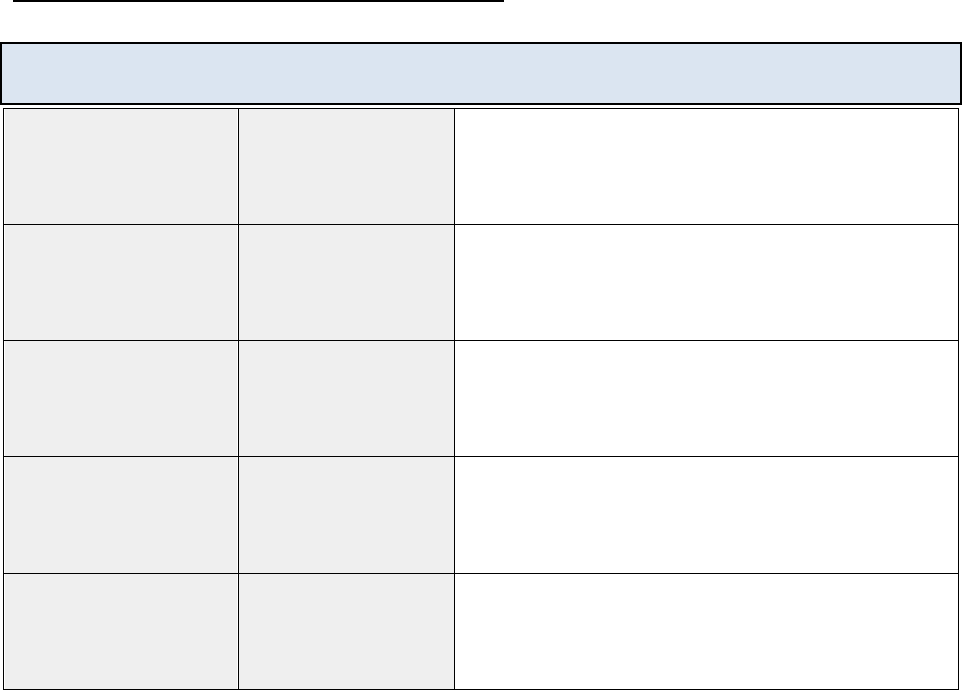
New York State Seal of Civic Readiness Manual 79
Appendix M: Sample Extracurricular Activities
Sample Extracurricular Activities
Clubs vary
High school clubs that provide opportunities for
student civic engagement include student
government, mock trial, speech and debate, Key
Club, Leo Club, class council, Model UN, etc.
Senior
Housing/Nursing
Home Volunteering
Opportunities
Office Duties
Volunteering, i.e., delivering goods, answering
telephones
SPCA/Humane
Society/Animal
Hospitals
Animal Welfare Volunteering to clean, groom, or care for animals
Tutoring Peer tutoring
Participating in a peer tutoring program at a
school or community-based organization
Volunteering
Experiences
Traditional
Community Service
Soup kitchen, city mission, food-drive
experiences limited to volunteering as a sole basis
of experience.
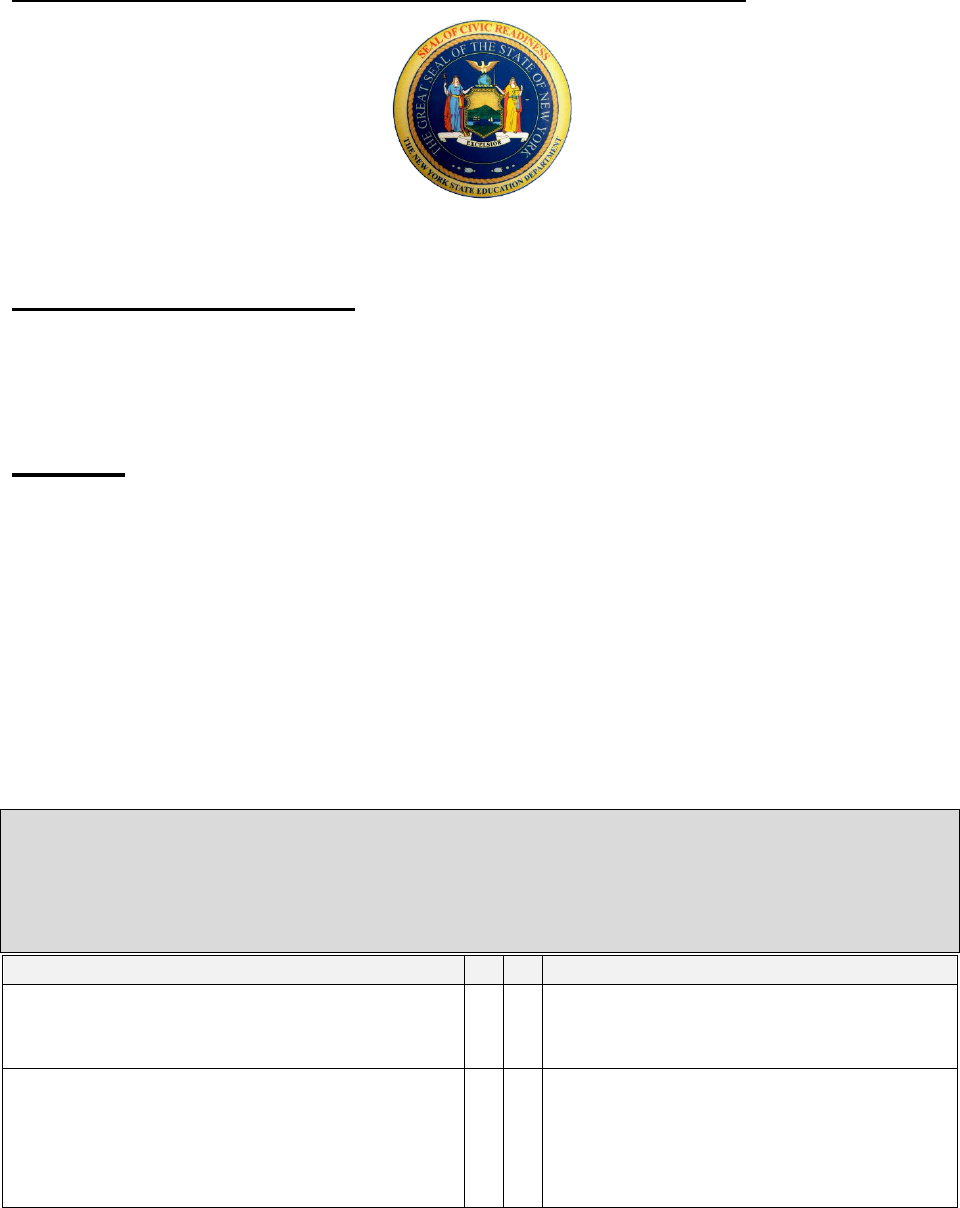
New York State Seal of Civic Readiness Manual 80
Appendix N: Criteria for Elective and Advanced Social Studies Courses
Criteria for Elective and Advanced Social Studies Courses (Civic Knowledge) and
Electives Rooted in Civic Participation
The Definition of Civic Readiness is organized around four domains:
1. Civic Knowledge
2. Civic Skills and Actions
3. Civic Mindsets
4. Civic Experiences
Directions:
Advanced Social Studies classes and electives rooted in civics must demonstrate
evidence of a strong foundation to Civic Readiness to be approved as part of the Seal of
Civic Readiness. Use this tool to evaluate individual courses. A course may only be
approved if there is evidence that the curriculum will include the four domains of civic
readiness. For each aspect of Civic Readiness check off if the course Y (yes) includes this
or N (no) does not include this element of civic readiness. Provide examples as
appropriate.
For a course to qualify it needs to have at least three components of each domain: Civic
Knowledge, Civic Skills and Actions, Civic Experience and Civic Mindsets.
Civic Knowledge: Demonstrate a fundamental and functional knowledge of government,
law, history, geography, culture, economics, and current events. These may include
inequities within our democratic system at the federal, state, and local level. Students
should know how to apply this knowledge to different circumstances and settings.
Practices
Y
N
Examples
Structure and functioning of government,
law, and democracy at the federal, state, local
and school levels and how to participate
Civil and educational rights and
responsibilities guaranteed by the U.S.
constitution, the Constitution of the State of
NY and federal, state, and local statutes and
regulations

New York State Seal of Civic Readiness Manual 81
History, geography, economics, and
current events within our country and in our
global society
Impact of individual and collective histories
in shaping contemporary issues
View and analyze history and current issues
from multiple perspectives
The importance of civic rights and
responsibilities, such as voting, volunteering,
Ensuring a free press
Civic Skills and Actions: Demonstrate a broad array of critical analytic, verbal,
communication, media literacy and other skills and participate in a wide variety of actions.
Students should practice such actions both inside and outside of school on a regular basis.
Practices
Y
N
Examples
Demonstrate respect for the rights of others
in discussions and classroom debates and
how to respectfully disagree with other
viewpoints and provide evidence for a
counterargument
Participate in activities that focus on a
classroom, school, community, state or
national issue or problem
Identify, describe, and contrast the roles of
the individual in opportunities for social and
political participation in different societies
Work to influence those in positions of
power to achieve extensions of freedom,
social justice, and human rights
Fulfill social and political responsibilities
associated with participation in a democratic
society and the interdependent global
community by developing awareness of
and/or engaging in the political process
Analyze and evaluate news (news literacy)
media, social media, and other sources of
information for accuracy, bias, reliability,
and credibility
Engagement in working toward the public
good

New York State Seal of Civic Readiness Manual 82
Civic Mindsets: Demonstrate the mindset of a participant in a democratic society. A civic
mindset is a commitment to democratic interpersonal and intrapersonal values, virtues,
attitudes, and beliefs and informed actions that promote and facilitate meaningful
participation in civic life. It is an understanding of self as part of and responsible to larger
social groups.
Practices
Y
N
Examples
Valuing equity, inclusivity, diversity, and
fairness
Recognizing the need to plan for both
current needs and the good of future
generations
Committing to balancing the common good
with individual liberties
Demonstrating a sense of self as an active
participant in society, willing to contribute to
solving local and/or national problems
Respecting fundamental democratic
principles, such as freedom of speech,
freedom of the press and the rule of law
Civic Experiences: Participate in developmentally appropriate civic experiences. Civic
readiness should be developed in a variety of settings and ways—inside and outside the
classroom, across content areas and for multiple purposes. Civic Readiness should be
promoted by engaging students in relevant experiences that include students as active
participants.
Practices
Y
N
Examples
Completing a civic capstone or civic
engagement project
Engaging in service learning
Engaging in civil discourse around
controversial issues
Engaging with news and digital tools,
such as social media, responsibly
Participating in civic centered co- curricular
and extracurricular activities such as Model
UN, Student Government, Debate Club,
Student Journalism or Mock Trial
Participating in school governance
Voting, volunteering, and participating in
community organizations and governmental
systems, such as community boards, youth
advisory councils etc. to promote continuous
improvement

New York State Seal of Civic Readiness Manual 83
Appendix O: Middle School Capstone Project Essential Elements
Middle School Capstone Project Essential Elements
Essential
Elements
Civic Knowledge Civic Skills Civic Mindset
Examine
community
Identify situations in
which social actions are
required.
Participate in activities
that focus on a classroom,
school, community, state,
or national issue or
problem with the support
of the classroom teacher.
Identify opportunities for
and the role of the
individual in social and
political participation in
the school, local, and/or
state community.
Identify
Issues
With the support of the
classroom teacher,
identify a civic issue
(problem) in the
community.
• For example, define
and frame questions
about events and the
world in which we
live, and use evidence
to answer these
questions.
Identify rights and
responsibilities as a
citizen of the community
and the state.
Conduct
Research
Describe how the issue
affects the daily lives and
shapes the perspectives
of similar and different
stakeholder groups.
• For example,
conducting interviews
and administering
surveys will help
students understand
the issue from
different perspectives,
including diverse
cultural groups.
Analyze and evaluate
news, media, social
media, and other sources
of information for
accuracy, bias, reliability,
and credibility.
Analysis
With the support of the
classroom teacher,
evaluate alternative
solutions to address the
community problem.

New York State Seal of Civic Readiness Manual 84
Essential
Elements
Civic
Knowledge
Civic Skills Civic Mindset
Develop
Strategies
and Solutions
With the support of the classroom
teacher, identify or develop
solution(s) in the form of a public
policy.
• For example, recognize an
argument and identify evidence
that supports the argument;
examine arguments that are
related to a specific social
studies topic from multiple
perspectives; deconstruct
arguments, recognizing the
perspective of the argument and
identifying evidence used to
support that perspective.
Communicate in a civic context,
showing the ability to express ideas,
discuss, and persuade when presenting
ideas.
Take Action
With the support of the classroom
teacher,
• Develop an awareness of and/or
engage in the political process.
• Create an action plan to enlist local
or state authorities to adopt their
proposed policy.
Demonstrate respect
for the rights of others
in discussions and
classroom debates;
respectfully disagree
with other viewpoints.
Work to influence those
in positions of power to
strive for extensions of
freedom, social justice,
and human rights.
Communicate
Participate in persuading, negotiating,
and compromising in the resolution
of differences and conflict; introduce
and examine the elements of debate.
Demonstrate respect for the rights of
others in discussions and debates;
respectfully disagree with other
viewpoints.
Reflection
Analyze the experience,
reflecting on the process
that was implemented,
challenges faced,
successes, and future
civic actions.

New York State Seal of Civic Readiness Manual 85
Appendix P: Essential Elements of a High School Capstone Project
Essential Elements of New York Civic Readiness Capstone Projects
Participation in government and in our communities is fundamental to the success of American
democracy
6
. Students choose to complete the Civic Readiness Capstone project to demonstrate
their readiness to make a positive difference in the public life of their communities through the
applied combination of civic knowledge, skills and actions, mindset, and experiences. Through
this project, students will apply knowledge and skills they have learned through their P-12 Social
Studies education, as well as other subject areas.
In this Civic Readiness Capstone project, students will:
• Examine the community to identify a civic issue (problem) facing them, their school, or
their community
• Analyze a civic issue (problem), evaluate alternative solutions, design and/or execute a
solution for this problem.
• Take informed action to address the civic issue.
• Reflect on what they have learned about their school or community from the Capstone
project.
• Make a presentation about their Civic Readiness Capstone project
High School Capstone Projects completed for the Civic Readiness Diploma Seal include
these essential elements based on the Definition of Civic Readiness:
Essential
Elements
Civic Knowledge Civic Skills Civic Mindset
Examine
Community
Demonstrate an
understanding of the
structure and function of
government and
democracy at the
appropriate level, and how
to participate therein.
Identify, describe, and
evaluate the relationships
between people, places,
regions, and environments
by using geographic tools
to place them in a spatial
context.
• For example, students
can conduct community
walks/drives and asset
map their community.
Define and frame
questions about events and
the world in which we
live, form hypotheses as
potential answers to these
questions, use evidence to
answer these questions,
and consider and analyze
counterhypotheses.
Identify opportunities
for and the role of the
individual in social and
political participation in
the school, local, and/or
state community.
6
Grade 12: Participation in Government and Civics, NYSED Social Studies Practices, 2014, page 45

New York State Seal of Civic Readiness Manual 86
Essential
Elements
Civic Knowledge Civic Skills Civic Mindset
Identify Issues
Integrate alternate,
divergent, or contradictory
perspectives or ideas.
Describe the impact of
individual and collective
histories in shaping
contemporary issues.
Analyze a civic issue
(problem) in the
community
• For example, include
data to describe the
number of people
affected by the issue,
the age/gender/socio-
economic status of
the people affected by
the issue, the
geographic impact of
the issue, the
environmental impact
of the issue, etc.
Integrate evidence from
multiple disciplines into a
Capstone Project.
Reflect on how
different cultures have
values, norms and
beliefs that shape how
they understand their
communities and the
problems they face.
Conduct
Research
Describe how the issue
affects the daily lives and
shapes the perspectives of
similar and different
stakeholder groups.
• For example, asset
mapping, conducting
interviews and
administering surveys
will help students
understand the issue
from different
perspectives, including
diverse cultural groups.
Analyze and evaluate
news, media, social media,
and other sources of
information for accuracy,
bias, reliability, and
credibility.
Analysis
Analyze a civic issue
(problem) in the
community, describe past
attempts to address the
issue, generate and
evaluate alternative
solutions to a civic
problem.
Weigh appropriate
evidence from multiple
disciplines to support
claims, which may include
political science, history,
natural sciences,
economics, geography,
and sociology.
Reflect on how
personal attitudes
and beliefs are
different and the
same from those of
other cultures and
communities.
Integrate what can be
learned through
engagement with
diversity into the
Capstone Project.

New York State Seal of Civic Readiness Manual 87
Essential
Elements
Civic Knowledge Civic Skills Civic Mindset
Develop
Strategies and
Solutions
Design and/or execute a
solution for this problem.
Evaluate the feasibility
of proposed actions to
address the community
or civic issue.
• For example, determine
an appropriate course of
action; deconstruct and
construct plausible and
persuasive arguments
using evidence.
Analyze factors that
influenced the
perspectives of
stakeholders involved
in the civic issue
central to the
Capstone Project.
Integrate alternate,
divergent, or
contradictory
perspectives or ideas.
Take Informed
Action
Design and implement
a Capstone Project
that engages the
school and/or out-of-
school community.
• For example, determine
an appropriate course of
action; work to influence
those in positions of
power to strive for
extensions of freedom,
social justice, and
human rights; develop
an awareness of and/or
engage in the political
process.
Communicate
Communicate in a civic
context, showing the
ability to express ideas,
discuss, persuade,
debate, negotiate, build
consensus and
compromise to organize
and conduct civic action.
Strategically use
different forms of
communication to
persuade/advocate and
express ideas.
Demonstrate respect for
the rights of others in
discussions and debates;
respectfully disagree with
other viewpoints.

New York State Seal of Civic Readiness Manual 88
Essential
Elements
Civic Knowledge Civic Skills Civic Mindset
Reflection
Analyze Capstone
Project experience,
reflecting on the
process that was
implemented,
challenges faced,
project limitations,
successes, future
civic actions, and
transferable skills.
Demonstrate and
reflect on a sense of
self as an active
participant in society,
willing to contribute
to solving local
and/or national
problems.
Based on the New York State Social Studies Practices, Grades 9-12, the New York State
Performance Level Descriptors for the Global History & Geography II and the U.S. History &
Government Regents exam, the NYSED Definition of Civic Readiness, and the American
Association of Colleges and University VALUE Rubric for Civic Engagement.
Relevant Definitions:
1. Asset map: Asset Mapping is a tool that relies on a core belief of asset-based community
development; namely, that good things exist in communities and that those things can be
highlighted and encouraged — these are assets suited to advancing those communities.
There are six categories of community assets: physical, economic, stories, local residents,
local associations, local institutions. For more information about asset mapping, visit
https://www.vistacampus.gov/what-asset-mapping
2. Communication methods include in-person/face-to-face, print, digital (i.e., social media)
3. Perspective(s) - outlook, point of view, position on or towards an issue
4. Stakeholder - a member of a particular status group that holds a specific self-interest
regarding a particular social problem or public policy

New York State Seal of Civic Readiness Manual 89
Appendix Q: Sample Student Assignment for a High School Civic Capstone Project
Sample Student Assignment for a Civics Capstone Project
Participation in government and in our communities is fundamental to the success of American
democracy
7
. You have chosen to complete the Civic Readiness Capstone project to demonstrate
your readiness to become engaged in the political process in your community. Through this
project, you will demonstrate the civic knowledge, skills, and mindset that you have developed
through your K-12 Social Studies education. You will need approval from your teacher/mentor
to progress through the different steps of this project.
Timeline/Action Plan
Student Name: _________________________________________________________________
Mentor Name: _________________________________________________________________
List of Meeting Dates if completing as an independent study:
_____________________________________________________________________________
Due
Dates:
Civics Capstone Project Steps
Links to
product(s)
1. Examine your community to identify a civic issue (problem) facing
you, or your school or your community
Suggested activities:
• Conduct community walks/drives and asset map the community. Asset
Mapping is a tool that relies on a core belief of asset-based community
development; namely, that good things exist in communities and that
those things can be highlighted and encouraged — these are assets
suited to advancing those communities. There are six categories of
community assets: physical, economic, stories, local residents, local
associations, local institutions. For more information about asset
mapping, visit https://www.vistacampus.gov/what-asset-mapping
.
• Conducting interviews and administering surveys will help you
understand the issue from different perspectives, including diverse
cultural groups. Be open to alternate, divergent, or contradictory
perspectives or ideas.
• Think about what you have learned in other coursework you have
completed. How can this information help you identify a civic issue?
• Critically evaluate what you hear, see, and read in the news and social
media about potential civic issues for accuracy, bias, reliability, and
credibility.
Mentor Feedback:
7
Grade 12: Participation in Government and Civics, NYSED Social Studies Practices, 2014, page 45

New York State Seal of Civic Readiness Manual 90
2. Analyze a civic issue (problem) in your school or community
Suggested activities:
• Describe past attempts to address the issue.
• Identify, describe, and evaluate the relationships between people,
places, regions, and environments by using geographic tools to place
them in a spatial context.
• Gather data to describe the number of people affected by the issue,
the age/gender/socio-economic status of the people affected by the
issue, the geographic impact of the issue, the environmental impact of
the issue, etc.
• Critically evaluate what you hear, see, and read in the news and
social media about the civic issue for accuracy, bias, reliability, and
credibility.
• Weigh appropriate evidence from multiple disciplines to support
claims, which may include political science, history, natural sciences,
economics, geography, and sociology.
• Demonstrate respect for the rights of others in discussions and
debates; respectfully disagree with other viewpoints.
Mentor Feedback:
3. Identify the cause of the civic issue.
Suggested activities:
• Define and frame questions about events and the world in which we
live, form hypotheses as potential answers to these questions, use
evidence to answer these questions, and consider and analyze
counterhypotheses.
• Weigh appropriate evidence from multiple disciplines to support
claims, which may include political science, history, natural sciences,
economics, geography, and sociology.
• For example, conducting interviews and administering surveys will
help students understand the issue from different perspectives,
including diverse cultural groups.
• Analyze and evaluate news, media, social media, and other sources of
information for accuracy, bias, reliability, and credibility.
Mentor Feedback:
4. Generate alternative solutions to address this civic issue.
Suggested activities:
• Identify opportunities for and the role of the individual in social and
political participation in the school, local, and/or state community.
• Learn about the structure and function of government and democracy
at the appropriate level, and how to participate therein.
• Reflect on how different cultures have values, norms and beliefs that
shape how they understand their communities and the problems they
face.
• Integrate what can be learned through engagement with diversity into
the Capstone Project.
Mentor Feedback:

New York State Seal of Civic Readiness Manual 91
5. Evaluate alternative solutions
Suggested activities:
• Evaluate the feasibility of proposed actions to address the community
or civic issue with a cost-benefit analysis.
• Analyze factors that influenced the perspectives of stakeholders
involved in the civic issue central to your Capstone Project.
• Organize and participate in a discussion about alternative solutions,
setting ground rules to respect the rights of others in discussions so
that participants can respectfully disagree with other viewpoints.
Mentor Feedback:
6. Develop strategies and solutions
Your plan should include:
• A description of your recommended solution to address the issue,
including specific references to the level, primary unit, and body of
government that you want to address the issue.
• A cost-benefit analysis for potential solutions.
• A description of who will be affected by your proposed action. An
evaluation of your solution from the perspectives of 3 different
stakeholder groups and at least two different cultural groups
represented in your community. Identify potential positive and
negative outcomes on these different groups from your action. Be
sure to comment on ways to mediate negative consequences.
The plan should address:
• Where will your solution occur?
• When will your solution occur?
• How will you communicate about your issue and your action? How
will you strategically use different forms of communication* to
persuade/advocate, present and express ideas?
Mentor Feedback:
7. Take informed action
Suggested activities:
• Implement your proposed action, engaging the school and/or out-of-
school community.
• Communicate in a civic context, showing the ability to express ideas,
discuss, persuade, debate, negotiate, build consensus and
compromise to organize and conduct civic action.
• Strategically use different forms of communication to
persuade/advocate and express ideas.
Mentor Feedback:

New York State Seal of Civic Readiness Manual 92
8. Reflection
Suggested activities:
• Reflect on what you have learned: Include an analysis of your Civic
Readiness Capstone Project experience, reflecting on the relevant
civic knowledge and skills that you acquired, the process that you
implemented, the challenges you faced, the successes of the project,
and how what you have learned will affect future civic actions you
may take. Include artifacts (i.e., photographs, video recordings,
newspaper articles) that document your actions and reflections.
Mentor Feedback:
9. Presentation:
• Prepare and make a presentation about your Civic Readiness
Capstone Project.
Mentor Feedback:
Sources:
All Together Now: Collaboration and Innovation for Youth Engagement. (2013). Accessed at:
http://www.civicyouth.org/wp-content/uploads/2013/09/CIRCLE-youthvoting-
individualPages.pdf
Association of American Colleges and Universities (AAC&U). (2009). Civic Engagement
VALUE rubric. Retrieved from https://www.aacu.org/civic-engagement-value-rubric
Best Practices in Capstone Projects, Hanover Research, August 2013, Accessed from
https://www.nisdtx.org/UserFiles/Servers/Server_232117/File/Departments/Research/District%2
0Research%20Projects/BestPracticesinCapstoneProjects_NorthwestIndependentSchoolDistrict.p
df , March 4, 2019
Colorado Department of Education, Colorado Portfolio and Capstone Guidebook, July 2014,
accessed https://www.cde.state.co.us/postsecondary/portfolio-and-capstone-draft-
implementation-guidebook, March 4, 2019
Jonathan, Kathleen Hall Jamieson, Peter Levine, Ted McConnell, and David B. Smith, eds.
Guardian of Democracy: The Civic Mission of Schools. Rep. Philadelphia: Leonore Annenberg
Institute for Civics of the Annenberg Public Policy Center at the University of, 2011 accessed at:
https://www.carnegie.org/publications/guardian-of-democracy-the-civic-mission-of-schools/
Kannapel, Patricia J., High School Capstone Courses: A Review of the Literature, ARCC at
Edvantia Research Consultant, 2012, accessed at https://files.eric.ed.gov/fulltext/ED539346.pdf

New York State Seal of Civic Readiness Manual 93
Appendix R: Seal of Civic Readiness Pilot Regional Coordinators
Big 5
Dawn Bartz, Executive Director, Yonkers City School District
W. Charles Brandy, Director of Social Studies, Buffalo City School District
Ryan Keating, Director of Social Studies, Rochester City School District
Jenna Ryall, Director, Civics for All, New York City Department of Education
Nick Stamoulacatos, Supervisor of Social Studies, Syracuse City School District
BOCES Staff and Curriculum Development Network
Polly Ash, Social Studies Specialist, Sullivan BOCES
Jon Cornue, Staff and Curriculum Development Specialist at Madison-Oneida BOCES
Kathryn Daughton, Literacy and Humanities Coordinator, Onondaga, Cortland, Madison
BOCES
Gregory Fredericks, Regional Coordinator of Social Studies and Blended Learning,
Putnam Northern Westchester BOCES
Rob Griffith, Professional Development and Curriculum Coordinator, Cattaraugus-
Allegheny BOCES
Kathleen Helhoski, Project Coordinator, Orange-Ulster BOCES
Jessica Karnes, Coordinator of Staff Development, Curriculum & Instruction, Erie 1
BOCES
Michael Monaghan, Social Studies K-12 Instructional Specialist, Monroe 1 BOCES
Donna M. Nowak, Data Specialist, Erie 2 BOCES
Marijo Pearson, Assistant Superintendent for Curriculum, Instruction and Professional
Development, Monroe 2 BOCES; Chair, SCDN Executive committee
Betsy Serapilio-Frank, Regional Literacy Coordinator and Staff Development Trainer,
Wayne-Finger Lakes BOCES
Patricia Walsh, Supervisor of Professional Learning and Innovation Center, Broome-
Tioga BOCES; Chair, SS SCDN Framework
Civic Readiness Task Force Members
Michael Coppotelli, Senior Associate Superintendent of Schools, Archdiocese of New
York
Lisa Kissinger, Academic Administrator, Shenendehowa CSD, Chair 2022 NYS Council
for Social Studies Convention
Aruna Patel, Lead Curriculum Development and Professional Learning Manager, New
Visions for Public Schools
Michael Rebell, Chairman of the Civic Readiness Task Force, Executive Director, Center
for Educational Equity
David Scott, Project Patch Coordinator, Northport East Northport City School District
April Francis Taylor, Director of Diversity, Equity and Inclusivity, Eastern Suffolk
BOCES
NYSED Staff
Lisa Pingelski, Associate in Instructional Services, Social Studies
Christy Radez, Associate in Instructional Services, Social Studies

New York State Seal of Civic Readiness Manual 94
Appendix S: Seal of Civic Readiness Author List
Big 5
Dawn Bartz, Executive Director, Yonkers City School District
Jenna Ryall, Director, Civics for All, New York City Department of Education
BOCES Staff and Curriculum Development Network
Kathryn Daughton, Literacy and Humanities Coordinator, Onondaga, Cortland, Madison
BOCES
Gregory Fredericks, Regional Coordinator of Social Studies and Blended Learning,
Putnam Northern Westchester BOCES
Rob Griffith, Professional Development and Curriculum Coordinator, Cattaraugus-
Allegheny BOCES
Jessica Karnes, Coordinator of Staff Development, Curriculum & Instruction, Erie 1
BOCES
Donna M. Nowak, Data Specialist, Erie 2 BOCES
Marijo Pearson, Assistant Superintendent for Curriculum, Instruction and Professional
Development, Monroe 2 BOCES; Chair, SCDN Executive committee
Patricia Walsh, Supervisor of Professional Learning and Innovation Center, Broome-
Tioga BOCES; Chair, SS SCDN Framework
Civic Readiness Task Force Members
Lisa Kissinger, Seal of Civic Readiness Manual Committee Chair, Academic
Administrator, Shenendehowa CSD, President of the NYS Council for Social
Studies
Aruna Patel, Lead Curriculum Development and Professional Learning Manager, New
Visions for Public Schools
April Francis Taylor, Director of Diversity, Equity and Inclusivity, Eastern Suffolk
BOCES
NYSED Staff
Lisa Pingelski, Associate in Instructional Services, Social Studies
Christy Radez, Associate in Instructional Services, Social Studies
NYSUT Representatives
Andrew Budris, Social Studies Lead Teacher, South Country School District
Joseph Karb, Middle School Social Studies Teacher, Springville Central School District
Donald Little, Social Studies Teacher, Syracuse City School District
UFT Representatives
Nicholas Norman, Field Liaison, UFT Teacher Center

New York State Seal of Civic Readiness Manual 95
Appendix T: Updated Frequently Updated Questions
Q1: How can students earn the 1 or 1.5 points for taking the Regents Exam if no Regents
Exam was offered and they received an exemption?
Students who received an exemption should use their course average to determine their points for
this category. If a student has a passing course average below 85, they should receive 1 point
(proficiency) for this category. If a student has a passing course average of 85 or above, they
should receive 1.5 points (mastery) for this category.
Q2: If a student from out of state enters high school in 10th/11th grade, can points be
awarded for the Regents Exams?
No. The only way a student can earn points on the Regents Exam is by taking the Regents Exam
or receiving an exemption.
Q3: Can out-of-state students be awarded points for electives taken out of state?
Yes, if the local Seal of Civic Readiness (SCR) committee determines out-of-state electives
rooted in civics are allowable, and if the student successfully completes the application of
knowledge component.
Q4: What can count for ENL students coming from another country who are missing
exams, electives or coming to us with credits from another country.
Out-of-country electives rooted in civics may count if the student successfully completes the
application of knowledge component. Social studies courses taken outside of the country may
count towards the 1 point for social studies courses.
Q5: Does an advanced class need to be rooted in all four domains of civic readiness to
qualify for points on the Seal of Civic Readiness?
No. Advanced social studies courses must be rooted in at least one of the four domains of civic
readiness. Most advanced social studies courses qualify because they enhance a student’s civic
knowledge.
Q6: Does an elective need to be rooted in all four domains of civic readiness to qualify for
points on the Seal of Civic Readiness?
Yes. Electives need to be rooted in all four domains of civic readiness, and they must
demonstrate evidence of civic participation/civic experiences because these points count towards
the civic participation category on the Seal.
Q7: Students receive 1 point for completing 4 credits of social studies. Can .5 point be
awarded if they take two years of social studies courses?
No. Points cannot be broken up because the four years of social studies courses demonstrate a
summation of civic knowledge.
Q8: Can a middle school student earn points on the Seal outside of the Middle School
Capstone?
No. Students may only earn 1 point in 7th or 8th grade by completing a middle school capstone
project.
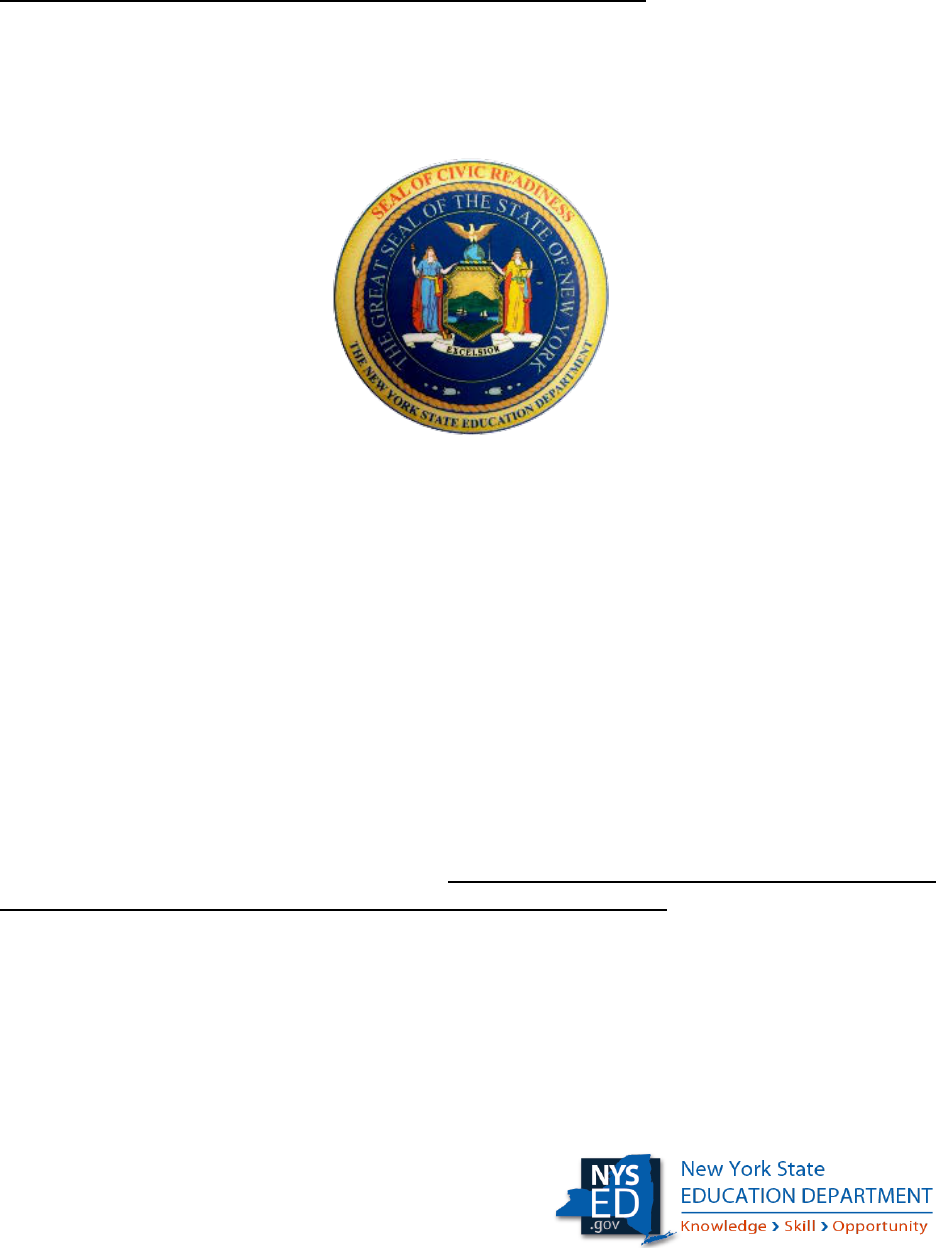
New York State Seal of Civic Readiness Manual 96
Appendix U: Updated Frequently Asked Questions for BOCES
Frequently Asked Questions about the Seal of Civic Readiness Application
for BOCES, P-Techs, Regional High Schools, Early Colleges, and other
Entities
Seal of Civic Readiness
The Seal of Civic Readiness is a formal recognition that a student has attained a high level
of proficiency in terms of civic knowledge, civic skills, civic mindset, and civic experiences.
The Seal of Civic Readiness is a distinction on both a high school transcript and diploma
that:
• shows the student’s understanding of a commitment to participatory government; civic
responsibility and civic values;
• demonstrates to universities, colleges, and future employers that the student has
completed an action project in civics or social justice; and
• recognizes the value of civic engagement and scholarship.
Criteria for the Seal of Civic Readiness
In order to obtain the Seal of Civic Readiness, a student must complete all the requirements for a
New York State local or Regents diploma and earn a total of six points with at least two points
in Civic Knowledge and at least two points in Civic Participation. Students may also earn
points by completing a middle school Capstone project and/or a high school Capstone project.
BOCES and other educational entities that enroll students from one or more districts, and which
do not confer high school diplomas for some (out of district) or all enrolled students, that would
like to offer coursework and learning experiences that would provide students with the
opportunity to attain the Seal, must complete the Seal of Civic Readiness application through the
NYSED Business Portal and receive approval from NYSED.
New York State Seal of Civic Readiness Manual 97
Frequently Asked Questions
1. In order for a BOCES (CTE) or other alternative program to offer the Seal do all of
their participating component districts need to sign off on the BOCES application?
No. If one component district signs off, a BOCES (CTE) or other alternative program may
offer the Seal to the students from that one district. For example, if a CTE High School has
ten components and six sign off they can offer the Seal to students from those six districts.
2. If a student attends a program from outside those components, must their district also
sign off to make them eligible?
Yes. Students from BOCES, P-Tech, and other entities must have their district sign off to
earn the Seal of Civic Readiness.
3. Can a BOCES, P-Tech, or other entity school combine points between the home high
school and their programs?
Yes. A student may earn the Seal adding together a combination of points earned in their
BOCES program, at their local high school, and work completed outside of the school. This
approach will require collaboration between the home districts and the BOCES programs. It
is strongly recommended that the outside programs work with the local high school’s school
counseling department.
4. Who is responsible for ordering the Seals, medallions, cords, etc. and delivering them to
the home school?
Providing seals or any graduation related regalia is not mandatory. However, this could be
provided by either the BOCES or other entities or the component districts.
5. Is the BOCES or alternative program responsible for housing student data and work
associated with the Seal and responsible for communicating successful completion of
the Seal to the home school?
Yes. However, it is strongly recommended that the BOCES or alternative program develop a
strong relationship with the school counseling department of each component district. Please
see below for additional guidance on the role of the school counseling department.
6. How can the counseling departments in component schools assist BOCES/Alternative
Programs in tracking student points?
Several of the components of the Seal of Civic Readiness (circled in red below) can be
tracked by school counselors and/or administrators to maintain student privacy. The
components would be accessed through student transcripts and records.
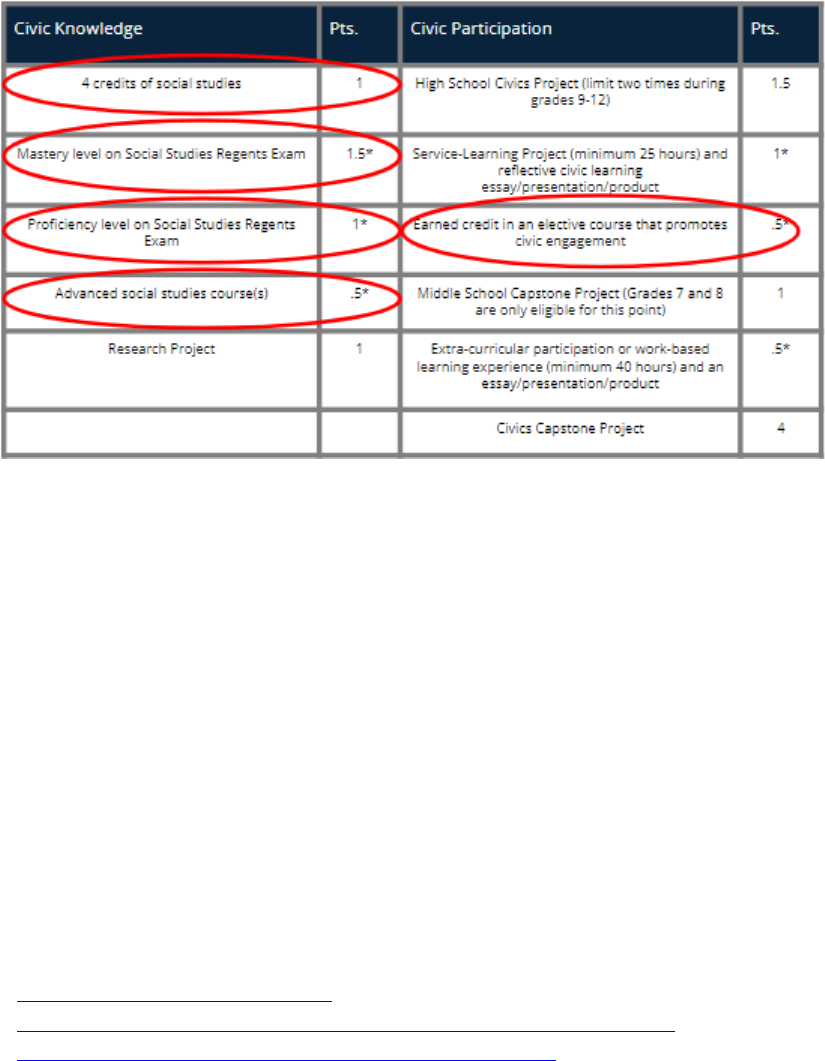
New York State Seal of Civic Readiness Manual 98
*Students may receive these points more than once.
Testing accommodations recommended in an individualized education program or section 504
should be adhered to. Accommodations Plan must be provided for all State and districtwide
assessments administered to students with disabilities, as consistent with State policy. Students in
schools with an alternate pathway for graduation approved by the Commissioner will be held to
those schools' criteria.
7. What are some ways counseling departments could assist their students participating in
a BOCES/P-Tech/Alternative program?
• The use of an electronic tracking process which is secure and complies with all applicable
district, state, and federal privacy policies and laws
• Drafting and updating a “course catalog” which specifies which courses are eligible
• Highlight that participating in the Seal assists in college and career preparedness
• Assisting in facilitating ongoing communication between the school, students, and
families
Resources
• NYSED Seal of Civic Readiness
• Printable PDF version of the Criteria for the Seal of Civic Readiness
• The New York State Seal of Civic Readiness Handbook
